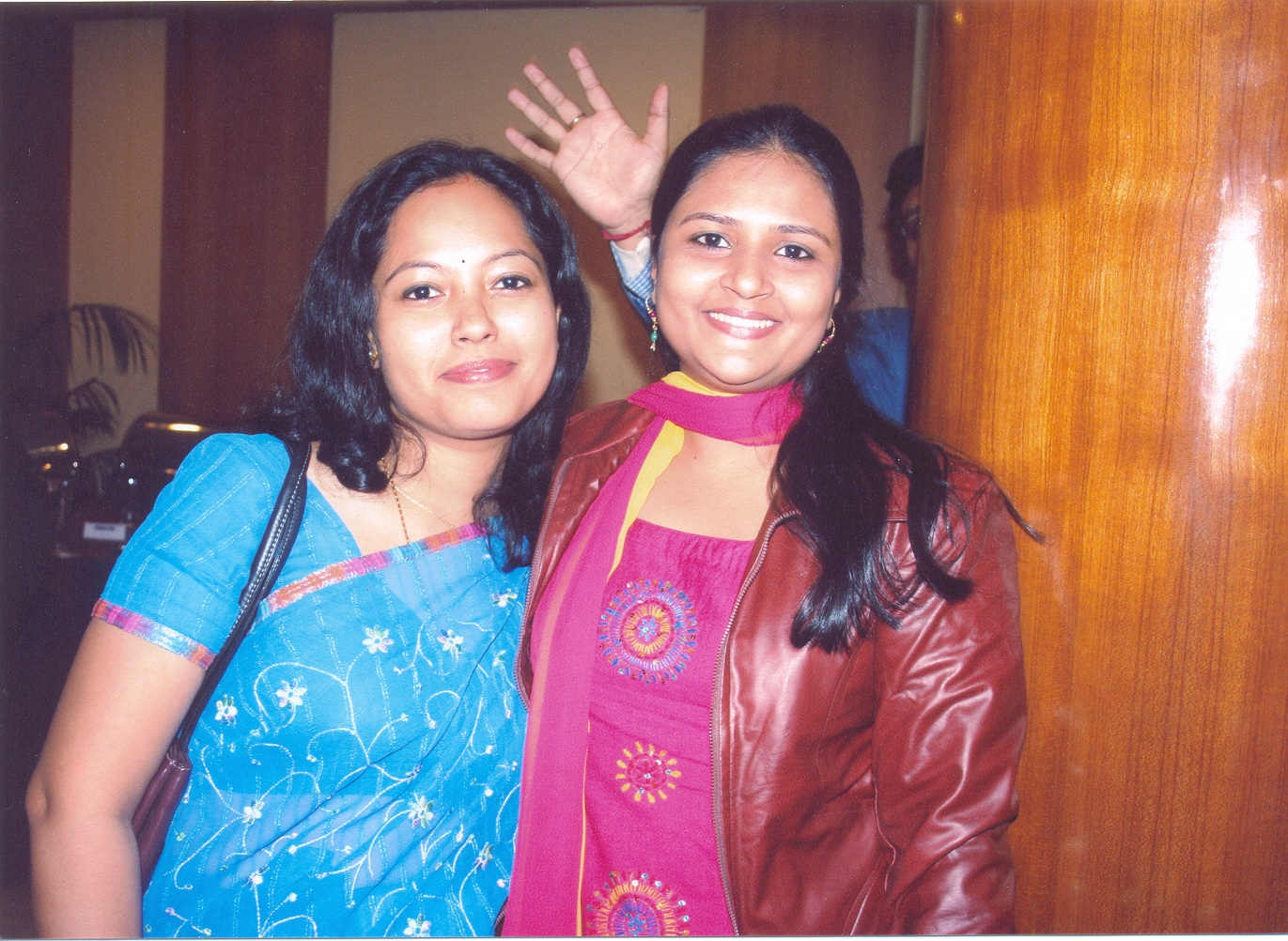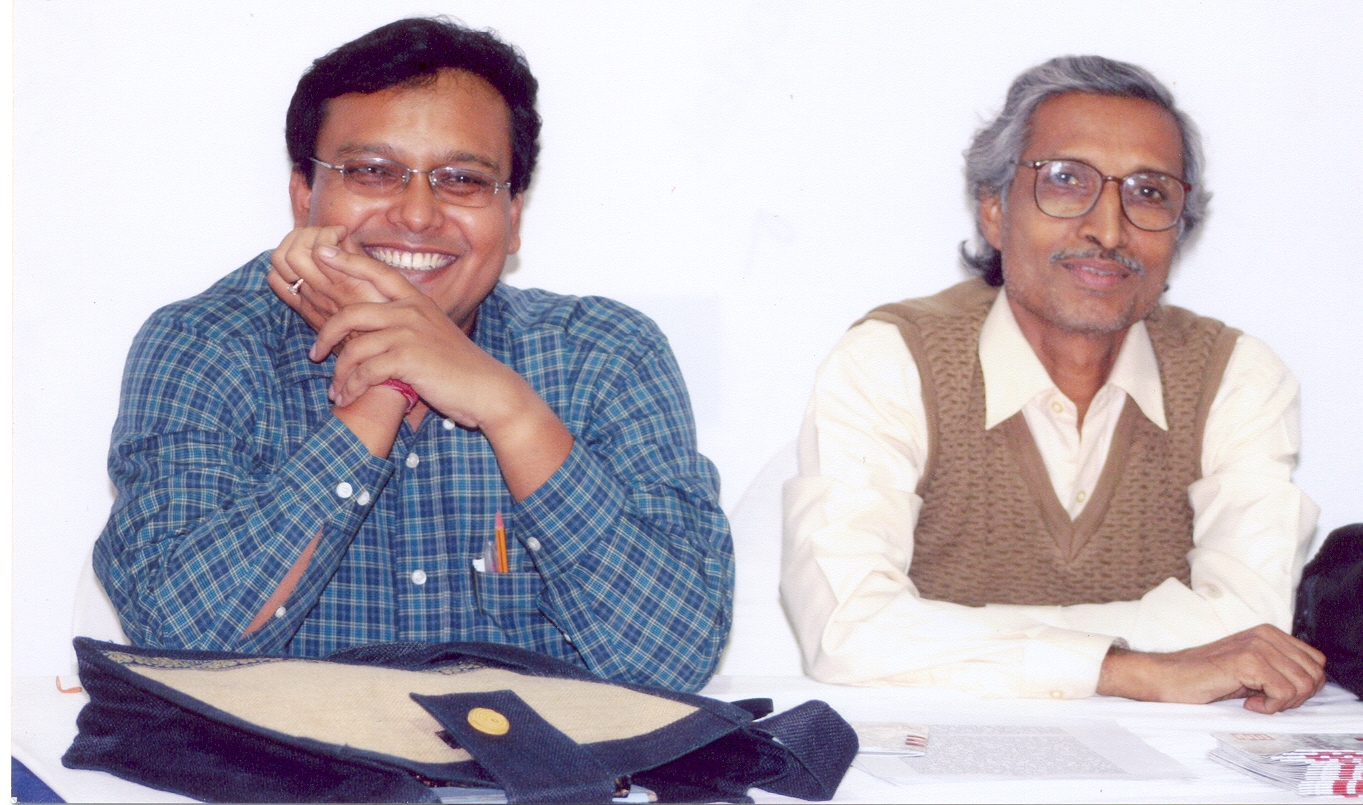This report is a product of notes and writings and prepared by the participants, faculty members and members of CRG desk for the winter course on forced migration. Thanks are to the participants and all others who contributed to it. Thanks are in particular to the UNHCR, the Brookings Institution and the Government of Finland whose generous help and advice made the programme possible.
Contents
- A Unique Programme
- Structure of the Course
- The Participants
- Members of Faculty and Speakers in Roundtables
- Partnerships: Supporting and Collaborating Institutions
- Schedule of the 15-day Programme
- Distance Education, the Modules and Assignments
- Creative Assignments
- Field Visit
- Public Lectures
- Interactive Sessions
- The Film-Tales of the Nightfairies
- Inaugural and Valedictory Session
- Evalution
- Follow-Up Activiries
- CRG team on Forced Migration
In the current political, social, and cultural climate of India, South Asia, and the world in general, the significance of a human rights and peace education programme on the inter-linked phenomena of massive forced migration, racism, and xenophobia cannot be overestimated. Attacks on civilians, atrocities on individuals and groups mostly belonging to minority communities, public espousal of national chauvinism, sexism, and masochism, intolerance, majoritarianism, and wars and war hysteria have increased. The scenario is marked by less tolerance, increase of hatred against foreigners, immigrants and refugees, a reduction of the civic-cultural space for discussion, debate, and dialogue in a context dominated by globalisation and a concomitant reduction of capacity of the states to listen to public voice for democracy, tolerance, and inter-cultural understanding. The situation is compounded by two trends: on one hand, education is becoming more nationalistic, majority-centric, consumerist, and is littered with hate-words and hate-speech, which impact on mass culture and reinforce the mass populist basis of war and militarism; on the other hand, there is a general decline of human rights standards, erasure of human rights protection mechanisms, and an increasing contempt and derision for appeals to heed to human rights laws and humanitarian laws in public life and follow the ethics of considerations for vulnerable sections of society.
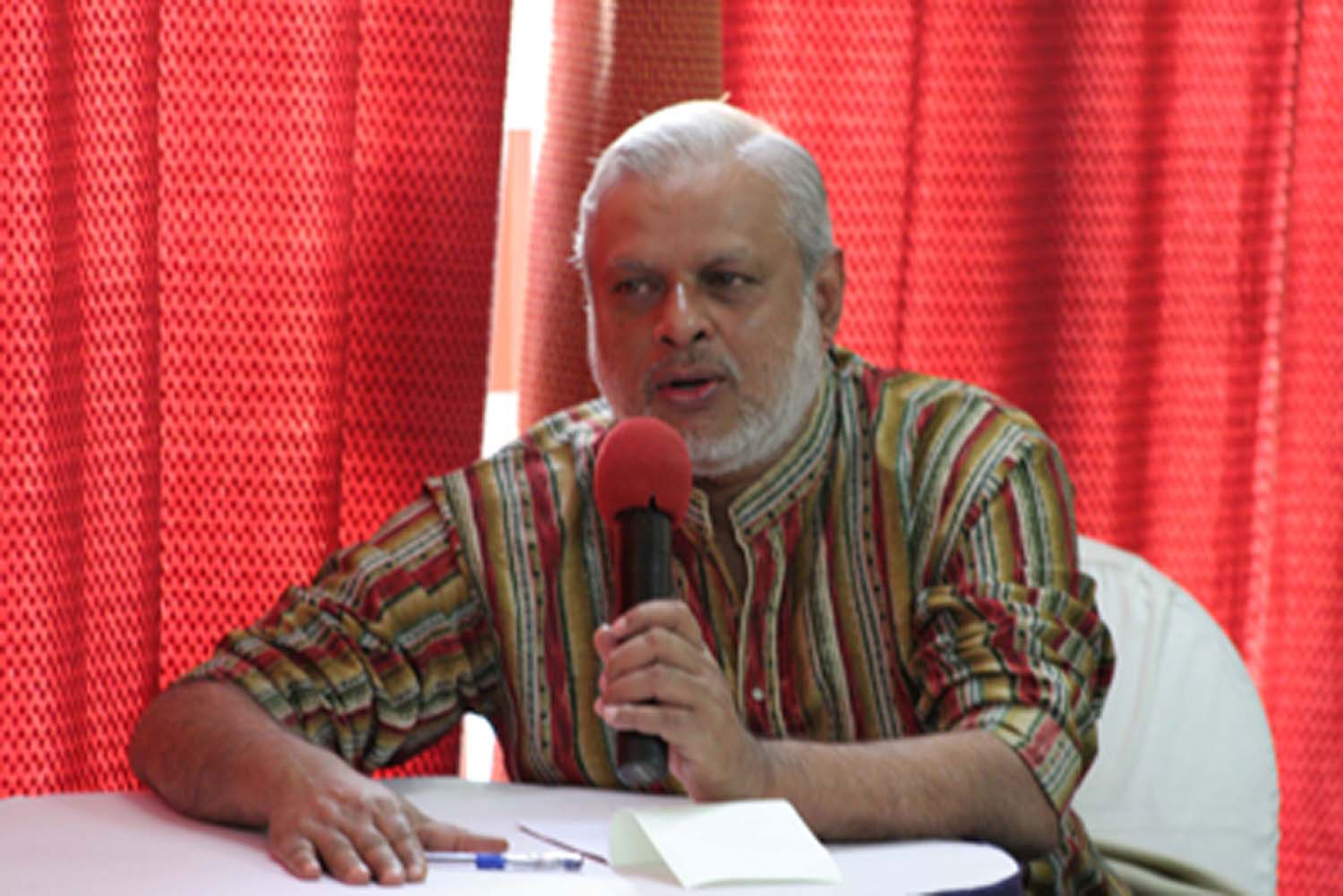
Ranabir Samaddar, Director of Calcutta Research Group addresses course participants
Never before in this region
was there such dire need to work for peace education that would be based on the
ethos of culture of peace so as to foster respect for human rights.
Most conspicuous, because of
conflicts, developmental policies, and environmental hazards, population
displacement has taken alarming proportions and the victims of forced
displacement are becoming targets of xenophobic frenzy, inter-state rivalry,
suspicion, and hate speech and hate acts. The flows are of mixed and massive
types called for grater atten5tion to human rights standards and humanitarian
protection – across boundaries and within nation-states. In short, the
situation calls for greater mobilisation of the civic-political space, of human
rights, peace, and humanitarian institutions and activists, grater dialogue
among all concerned on the related issues of rights, justice, and protection.
Developed through last few years as a programme on human rights and peace education, the
annual winter course on forced migration organised each year by the Mahanirban
Calcutta Research Group (CRG) has come to be recognised in the region of South
Asia as one of the most well known educational programmes on issues of rights
and justice relating to the victims of forced migration. In the from of a
certificate course, certified by the UNHCR and supported by the Government of
Finland and the Brookings Institution, the winter course is aimed at scholars
and educationists working on issues of rights and justice, functionaries of
humanitarian organisations, national human rights institutions, peace studies
scholars and activists, and minority groups, refugee communities, and women’s
rights activists. Participants come from all over South Asia, with some joining
from Thailand and Burma, and from the Europe and the Americas. The course
attracts a renowned international faculty, and is now recognised by the National
Human Rights Commission in India, and several universities along with various
grassroots organisations have collaborated over the years to make it a success.
There
are several features of the course, which make it a unique programme.
Readers of the report will find the details in subsequent pages; however it
is important to summarise them and place them at the beginning:
(a) Emphasis on distance education, its innovation, and continuous
improvement through interactive methods, including the use of web-based
education;
(b) International standard, rigorous nature of the course, field work,
and a comprehensive regional nature of the course;
(c) Emphasis on experiences of the victims of forced displacement in the
conflict zones; such as the Northeast, Jammu Kashmir, and Jharkhand.
(d) Emphasis on gender justice
(e) Special attention on policy implications
(f) Follow up programmes such as spreading it to universities, innovating
local modules, training participants to become trainers of the future
programmes;
(g) And, finally building up
the programme as a facilitator of a network of several universities,
grassroots organisations, Mothers Fronts, research foundations, UN
institutions etc.
The Fourth Annual CRG Winter Course on Forced Migration concluded on 15 December 2006. Although this course is called a course on forced migration it also discusses the root causes for migrations/displacements, and so issues such as racism, immigration and xenophobia in the context of displacements fall within its purview and are discussed in some details. The major thrust area of this course is South Asia although examples from other regions are also brought in for purposes of comparison and analysis. The course, as has already been mentioned earlier, is an outcome of the ongoing and past work by the CRG, and other collaborating groups, institutions, scholars, and human rights and humanitarian activists in the field of refugee studies and on displacement and human rights. The course structure is intended to take cognisance of the gendered nature of forced displacement in South Asia. It pays special attention to victim’s voices and their responses to national and international policies on rehabilitation and care. The course builds on CRGs ongoing research on forced displacements in the region and hence it is constantly evolving. It analyses mechanisms, both formal and informal, for empowerment of the displaced. It pays particular attention to different forms of vulnerabilities in displacement without creating hierarchies. It is built around six modules, four of which are compulsory and two others optional. From the two optional modules the participants are expected to select one for their study.
The compulsory
modules:
1. Nationalism, ethnicity, racism and xenophobia
2. Gendered nature of forced migration, victim-hood, and gender-justice
3. International, regional, and national regimes of protection
4. Internal displacement – causes, linkages, and responses
The optional
modules:
5. Resource politics, environmental degradation, and forced migration
6. Ethics of care and justice
This year the course activities besides the writing assignments, included workshop assignments, group discussions, field visit, creative sessions, review discussions, and face-to-face sessions with resource persons experienced in related areas and with refugee activists working with refugees living in camps. The course also included film and documentary sessions.
Duration and
activities
The course was of three (3) months duration with two and half months duration of distance education, communication on related issues of displacement studies, course assignments by participants followed by fifteen days of direct course work in a winter workshop. Upon the participants being selected, course material was sent to them in a phased manner Short introductory note on each module was sent to the participants; along with these notes, lists, bibliographies, and other announcements were also sent. The reading material was also sent to the participants in a phased manner. For review assignments and term papers lead-questions and discussion points were sent at regular intervals. Each module had a tutor and a number of faculty members. On the basis of the modules chosen by them the participants were encouraged to contact the faculty persons for necessary advice and inputs. Chat sessions were organised so that participants could discuss their assignments with module tutors.
Participants
were required to prepare an assignment paper each and bring the papers with them
for the workshop where the papers were discussed. These papers were first read
and commented upon by the module tutors and then made available for wider
circulation and discussion on the CRG website. The participants were also given
assignments termed as creative assignment so that the period of three months
could also be used for training in communication aspects of humanitarian and
human rights work, and other practical aspects such as providing the
participants with information and documentation skills, preparing local data
base, campaign for fund-raising for human rights and humanitarian efforts, and
report writing. Creative assignments were made mandatory this year and its
results were varied and rich. Participation in the field visit was also
compulsory.
The
preparation of course material was of great significance. The course material
included mandatory, optional and supplementary material. The mandatory material
included a number of books, essays and web-based material. Supplementary
materials including a short write-up on fieldwork was handed
to them when they arrived in Kolkata. Three weeks before the participants arrived
in Kolkata they were given workshop themes. They were required to participate in
one of the workshops. Participants were graded on all these assignments and on
the valedictory day these grades were handed to them. Since 2005 the course also
includes two optional modules. The participants were
asked to select any one of the modules of their choice. They were given one assignment from the optional
module that they selected. They had to write a review essay analysing some of
the reading material given in that module.
Participants
Twenty-four participants were selected for the course, of whom twenty-one could complete the course. These participants were selected through public notifications and were drawn from backgrounds of law, social and humanitarian work, human rights work, and academic and research work. Most of them came from South Asia but few were also from other regions such as Europe, Africa and Australia and brought forth with them wider experiences of refugee-hood and of rehabilitation and care. Those who could not complete the course were to do so mainly due to visa problems.
Faculty
The faculty was drawn from people with recognised backgrounds in refugee studies, studies on internal displacement, university teaching and research, humanitarian work in NGOs, legal studies, UN functionaries, particularly UNHCR and ICRC functionaries; public policy analysis, journalism, and concerned human rights activism and humanitarian work. Attention was paid to diversity of background and region. Importance was attached to the requirements of the syllabus; the faculty was also involved in developing on a permanent scale a syllabus, a set of reading material, evaluation, and follow-up activities. The resource persons also helped in harmonising the syllabus of this course with the requirements of the participants, and similar syllabi in various universities, workshops, and courses. They graded participants on their skills such as speaking and writing skills, analysis of themes chosen, execution of creative assignments etc.
Evaluation
The participants were evaluated by a number of
resource persons. The core faculty
evaluated each of their assignments. All the resource persons present evaluated their presentations,
including the presentation of their term paper. They were given a grade for the distance education segment and
another for the Kolkata workshop. At the end of the course they were given a cumulative grade. The course is
equivalent to six credit hours of graduate level work.
The course has a built in evaluation system. Each participant is required to
present a written evaluation and each resource person is also expected to do
the same. Every year CRG invites
independent scholars of renown, social activists and administrators to evaluate
the course. This year Professor Tarja
Väyrynen of Tampere University, Finland, Professor Barbara Ramusack of
University of Cincinnati, USA, and Dr. Khalid Koser of the Brookings-Berne
Project on Internal Displacement evaluated their course. Excerpts from their evaluation are presented
in Section 14.
Follow-Up
Considering
the growing popularity of the course the advisory committee asked the CRG
organisers to look into possibilities of organizing short courses in
collaboration with willing centres and departments of Universities in India as
follow-up activity. On the basis of such advice the CRG is now in the process
of designing a number of short courses for different Universities and research
centres. This year two such short courses were held. The first was held in
Guwahati and it was organised in collaboration with Panos, South Asia. The
second course was held in Delhi in collaboration with Jamia Milia Islamia
University (JMU).
Apart from this a number of workshops on forced migration were held in different
parts of South Asia. The CRG also collaborated with a number of institutions and
organised a number of public lectures. This year three fellowships were given to
the participants of the Winter Course. Also CRG conducted a many research
projects on the theme of forced migration. For a detailed report on follow-up
activities please read Section 15.
The follow-up activities of the winter course have now assumed the character of
an entire programme with other allied work. The CRG established the forced
migration desk to look after the entire programme.
Abdur Rashid
is a Senior Programme Officer at the Refugee and Migratory Movements Research
Unit (RMMRU) in Dhaka, Bangladesh.
Dilip Gogoi
is a lecturer in Political Science at Cotton College, Guwahati, India.
Eeva Puumala
is a doctoral student and research assistant at the Tampere Peace Research
Institute (TAPRI), Finland.
Hina Shahid
is a Program Officer with Action Aid, Pakistan.
Jason Miller
is a researcher monitoring human rights in Burma.
Judith Macchi
is pursuing her Master’s degree in Human Geography at the University of Berne
and working on her Master’s thesis on the Sri Lankan immigrants to
Switzerland.
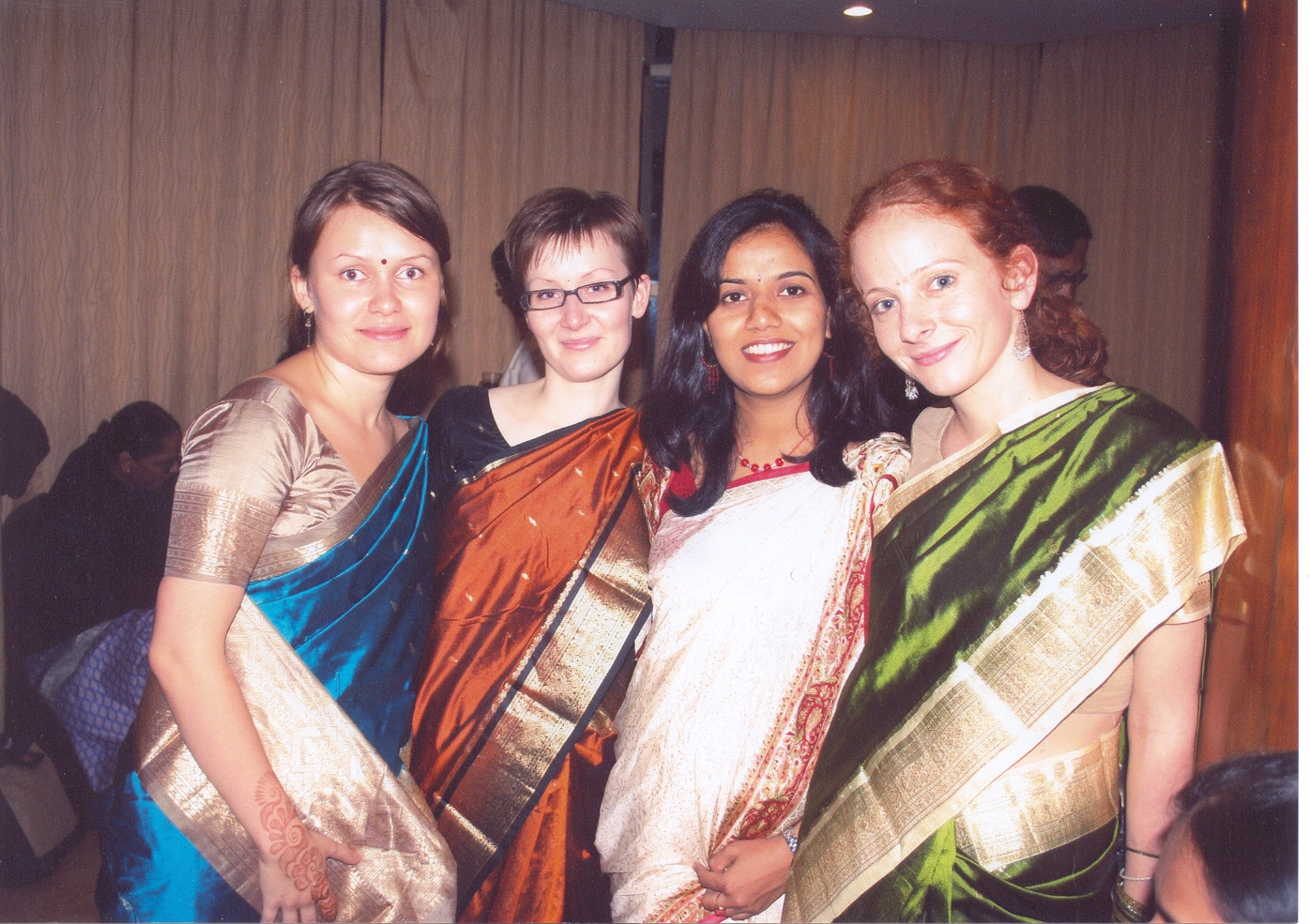
Ksenia Glebova,Eeva Puumala, Uma Joshi & Judith Macchi
Khaleel Ahmed is an Assistant Registrar (Law) with the National Human Rights Commission of India.
Ksenia Glebova is a freelance journalist from Finland specialising in refugee and displacement issues.
Madhumita Sengupta is lecturer in History at Rani Birla College, Kolkata, India.
Malkit Singh is a doctoral student in Political Science at the Punjab University working on issues of state, militancy and human rights in Punjab, India
Mostafa Mahmud Naser is a lecturer in Law in the Department of Law, University of Chittagong, Bangladesh.
Nanda Kishor is a doctoral student at the Department of political science, University of Hyderabad are working on the subject of urban displacement and sustainable urban development.
Nir Prasad Dahal is a researcher working for the Nepal Institute for Peace, Kathmandu, Nepal.
Oluwatoyin Oluwaniyi is a lecturer in Political Science at the Covenant University, Ota, Nigeria.
Om Prakash Vyas works for the Investigation Division of the National Human Rights Commission of India.
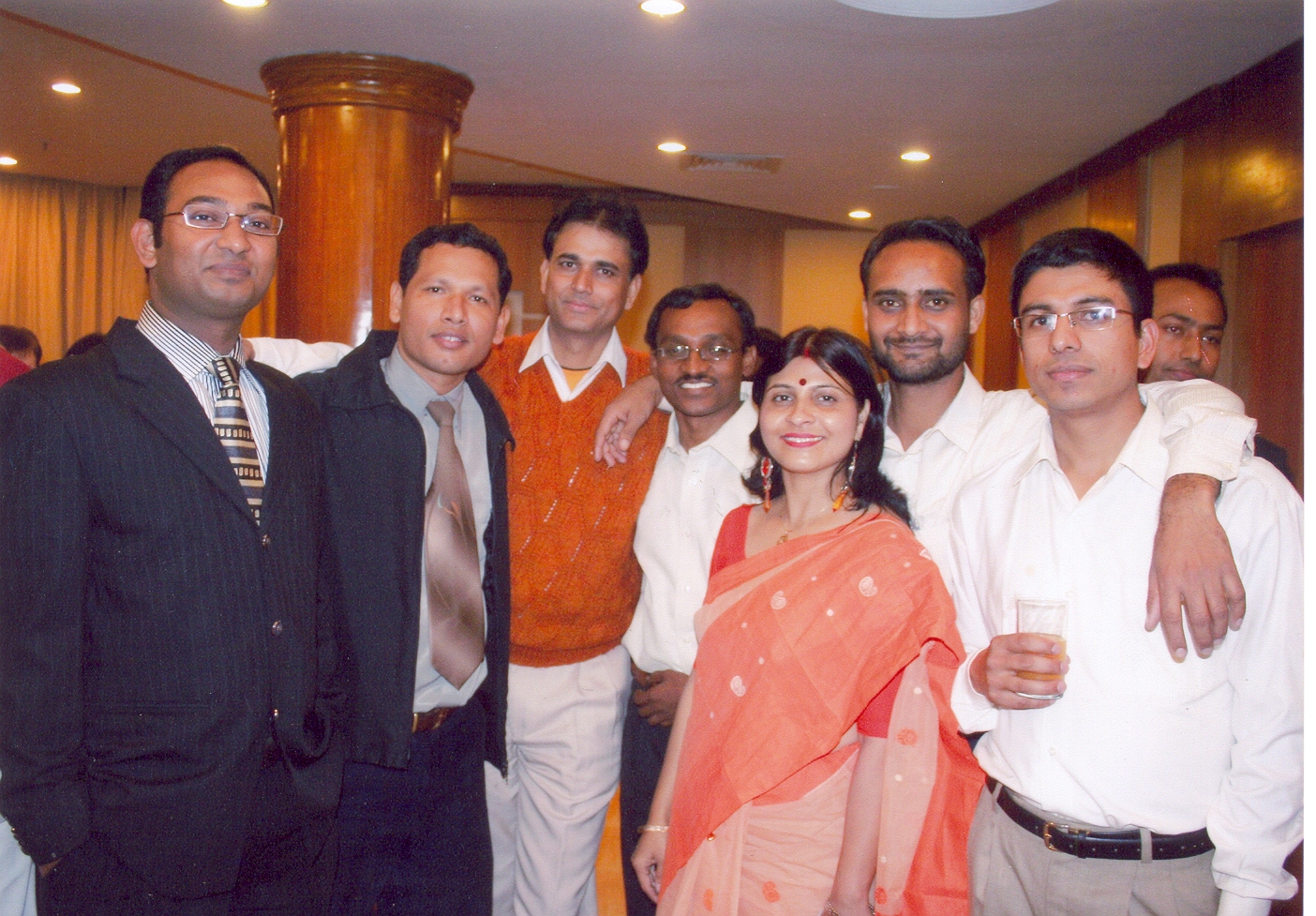
Course participants from India, Nepal, Bangladesh and Pakistan
S.Y.Surendra Kumar is a doctoral student at the Jawarharlal Nehru University, New Delhi and a lecturer in Political Science in Bangalore University, India.
Saba Hussain is working for Greenpeace, India.
Shiva Kumar Dhungana is a Research Officer working for a Kathmandu-based NGO Friends For Peace, Kathmandu, Nepal.
Uma Joshi works for the National Human Rights Commission of Nepal.
Vanita Banjan is a senior lecturer in Political Science at the SIES College of Arts, Science and Commerce in Mumbai, India.
Ajay Gandhi Human rights activist and researcher, McGill University
Flavia Agnes Women’s Rights Activist, Majlis, Mumbai
Hameeda Hossain Ain O Shalish Kendra, Dhaka
Hans-Joachim Heintze Professor, University of Ruhr, Bochum, International Regime of Refugee Protection
Jagat Acharya Bhutanese Refugee and Activist, Nepal Institute of Peace, Kathmandu
K. M. Parivelan Information Officer UNDP/TNTRC Chennai
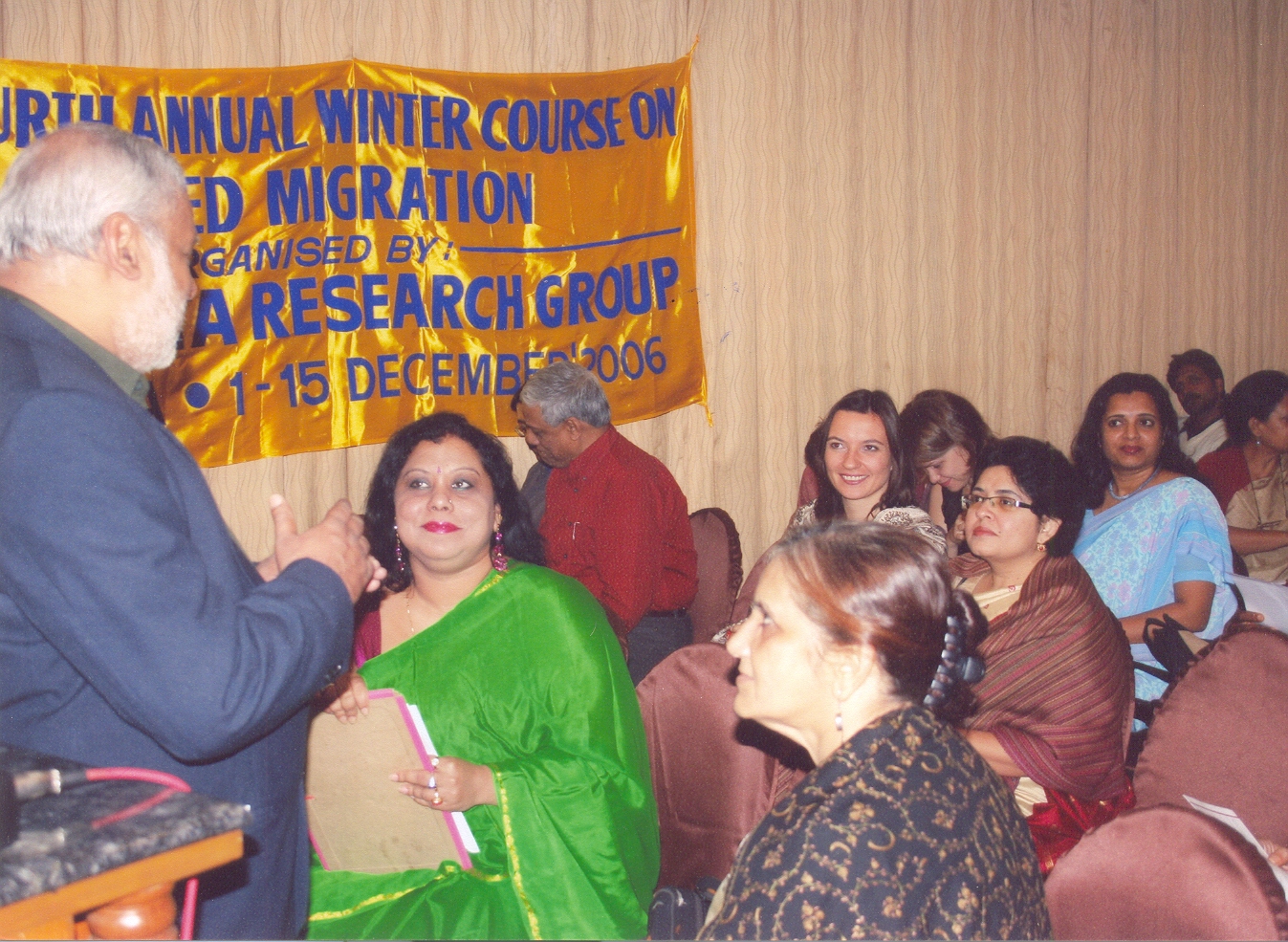
Faculty members in discussion before the inaugural session
Keya Dasgupta
Centre for Studies in Social Sciences, Kolkata
Khalid Koser Deputy Director, Brookings-Bern Project on
Internal Displacement, Brookings Institution
Manabi Majumdar
Centre for Studies in Social Sciences, Kolkata
Manuela Bojadzijev
Projekt Migration, Frankfurt and Berlin
(European Experiences of Racism and Immigration)
Mario Gomez
Berghof Foundation, Colombo (Human Rights Commission and the Protection of the
IDPs in Sri Lanka
Meghna Guhathakurta Professor, Department of International Relations,
University of Dhaka, Bangladesh
O.P. Mishra
Centre for Refugee Studies, Jadavpur University
Oishik Sircar
Pune ILC, The Politics of Asylum Jurisprudence and
International Protection
Paula Banerjee Historian and women’s rights activist, member of the Calcutta
Research Group, Faculty, Department of South and South-East Asian studies,
University of Calcutta, Kolkata, India.
Pradip Phanjoubam
Editor, Imphal
Free Press
Ranabir Samaddar Political thinker and Director, Calcutta Research Group, Kolkata,
India.
Sabyasachi Basu Ray
Chaudhury Secretary of the Calcutta Research Group and
Faculty, Department of Political Science, Rabindra Bharati University,
Kolkata, India.
Samir K. Das Political analyst on the North East and member of the Calcutta
Research Group, and Faculty, Department of Political Science, University
of Calcutta, Kolkata, India.
Sohini Ghosh Filmmaker,
Jamia Milia Islamia University
Subhas Ranjan
Chakraborty President of the Calcutta Research Group and
Faculty Presidency College.
Sudeep Basu Institute of
Development Studies, Kolkata
Sumbul Rizvi UNHCR, New Delhi
The
Government of Finland, the United Nations High Commissioner for Refugees, New
Delhi, and the Brookings Institution, Washington DC are the sponsors of the
programme. With their un-stinted support and goodwill, the programme has become
one of the most well known events in the field of studies on forced migration
studies, and an academic event in Kolkata.
Preparation for the Fourth Winter Course on
Forced Migration commenced on 14 December 2005, a day before the Third
Winter Course formally ended. By
that time CRG members and its collaborators had realised that the Winter
Course has grown into a full-fledged programme with components of
research, networking, particularly partnership between Indian and Finnish
institutions, and training under innovative and different formats.
This was later accepted and endorsed by the advisors during the
advisory committee meeting in June 2006.
The collaborative nature of the programme was underlined from the
beginning by the participatory nature of the advisory meeting. The
Advisory Committee Meeting of the Fourth CRG Winter Course on Forced
Migration was held in Swabhumi Kolkata, on 13 June 2006. The participants
included the following:
Abu Ahmed (OKD)
Ajay Darshan Behra (Jamia
Milia Islamia University)
Anita Sengupta (MAKAIAS)
Anna-Kaisa Heikkinen
(Government of Finland)
Jyrki Käkönen
(University of Tampere)
Krishna Banerjee (Khoj
Akhon, CRG)
Monirul Hussain (Guwahati
University)
Oishik Sircar (Pune
University)
Paula Banerjee (CRG)
Pradip Kumar Bose (CRG)
Pritima Sharma (CRG)
Ranabir Samaddar (CRG)
Ritu Menon (Women
Unlimited)
Sabyasachi Basu Roy
Chaudhury (CRG)
Samir Das (CRG)
Sharmistha Chakraborty
(Calcutta University)
Shivaji Pratim Basu
(Sri Chaitanya College)
Shoumitra Dastidar
(Independent Filmmaker)
Shreyashi Chaudhuri (CRG)
Subhas Chakraborty (CRG)
Sudeep Basu (IDSK)
Sudhir Chowdhury (NHRC)
Sumbul Rizvi Khan (UNHCR)
Swati Ghosh (Rabindra
Bharati University)
Uttara Chakraborty
(Bethune College)
Several suggestions
emerged as a result of the advisory meeting including greater engagement
with the concept of ‘refugee’, more emphasis on Bhutanese and Nepalese
refugees in the course, and introducing the Sub-Saharan as well as Latin
American dimensions would make the course more interesting and
far-reaching.
It was also acknowledged that collaboration with Finland is proving
significant as more Finnish students are getting interested in joining the
course. Sending selected Winter Course participants to Tampere University
for a week-long exposure trip was one of the suggestions later put into
practice.
Four areas of experiment were identified
including structuring of module, distance education, participants profile
and participants assignments. Suggestions were made for a short-term
course with SDPI or LUMPS in Islamabad and ICES in Colombo, including
growing violence against the displaced as an optional module, looking at
the refugee problem as a cultural problem and making the field visit
longer in duration. Also, the distance education segment can be reduced so
that the time for direct orientation workshop in Kolkata can be increased.
In the assignment component CRG can also think of a collaborative research
of participants of two or three countries together.
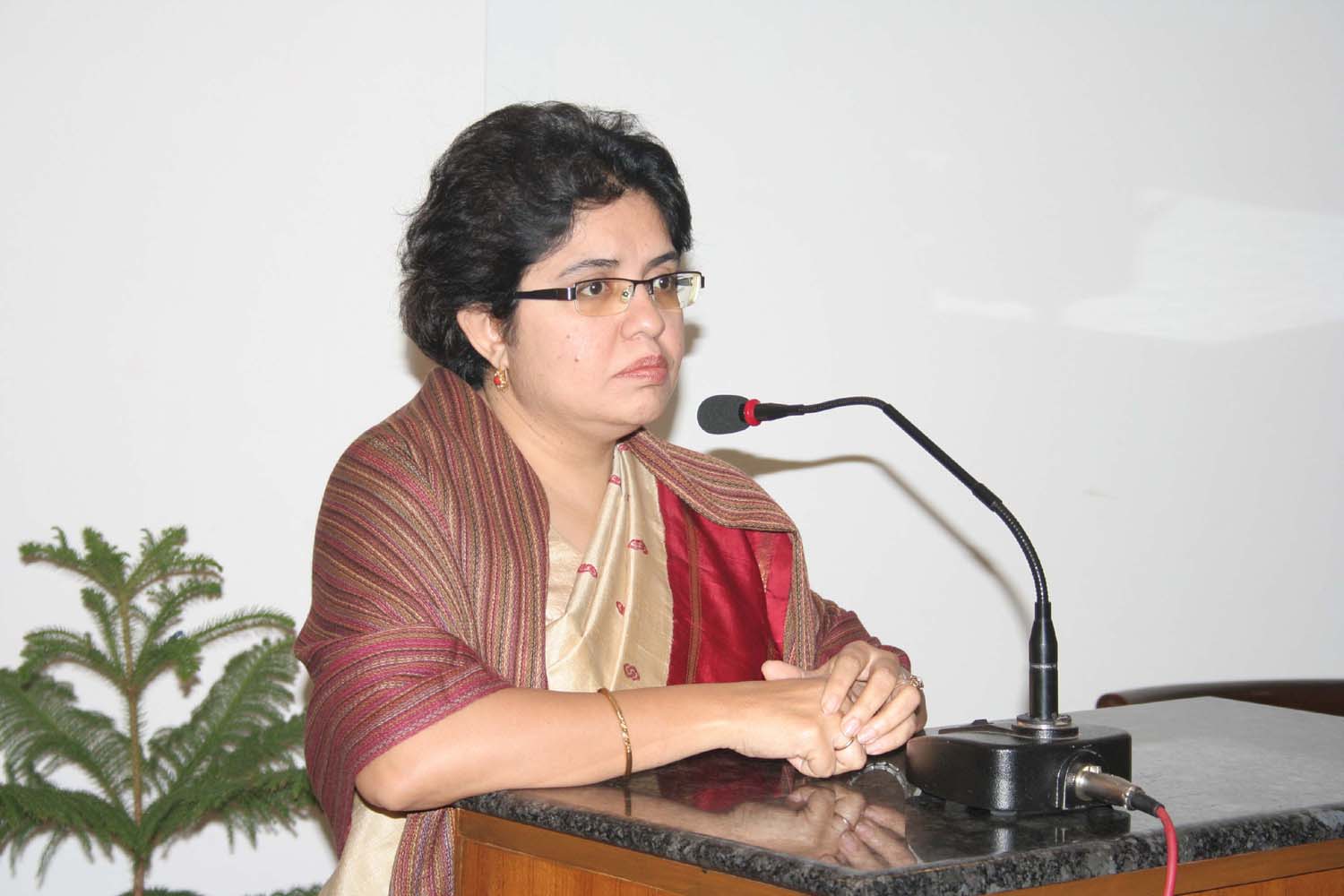
Sumbul Rizvi, UNHCR Protection Officer
In terms of
furthering existing co-operation and creating new collaboration networks,
Professor Jyrki Käkönen confirmed his intention to further CRG-Tampere
University exchanges. He
stated that Dr. Paula Banerjee was to be invited to teach a course in
Tampere for one week. This
course can be on forced migration. Professor Ranabir Samaddar has been
invited by Turku University as part of the emerging cooperation. Professor
Abu Ahmed stated that the OKD Centre was willing to sign a MOU with CRG
for further exchanges.
Support for the winter
course has also been expressed at individual level. Several faculty
members came without full or any travel support and offered to contribute
their knowledge and expertise for the benefit of the course. Many
institutions such as the National Human Rights Commission have supported
the course by sending participants. Finally, the cooperation from various
quarters in circulating the announcement on the course was tremendous. In
all these, the cooperation of the participants and the ex-participants was
the most valuable asset. CRG remains indebted to all for making the course
a success.
Due to the growing popularity of the course the advisory committee asked
the organisers to look into possibilities of organizing short courses in
collaboration with willing centres and departments of Universities in
India as follow-up activities. As a result of a series of follow-up
activities the CRG is building partnerships with many new institutions. A
number of organisations and institutions have shown willingness to
collaborate with CRG on this. Included in these are NALSAR,
Secunderabad, Jamia Milia Islamia University, New Delhi, Omeo Kumar Das
Centre, Guwahati, Punjab University, Chandigarh. Women’s Studies Centre,
Utkal University, Department of Law, Guwahati University, Department of
Political Science, Rabindra Bharati University, Department of South and
South East Asian Studies, Calcutta University and several Finnish
institutions. Besides as reported earlier the CRG has collaborated with a
number of institutions to organise public lectures and discussions as part
of its follow-up activity. CRG remains grateful to all the organisations
that have showed willingness to collaborate on programmes on forced
migration.
Short Course in Jamia Milia Islamia
A
five-day course on issues of forced migration was held in Jamia Milia
Islamia (JMI) University with full cooperation of the Honorable Vice
Chancellor, Professor Mushirul Hasan.
The course coordinators were Ajay Darshan Behera of JMI and Paula
Banerjee of CRG. Lectures were delivered by Rashmi Doraiswamy (JMI),
Navneeta Chaddha Behera (Delhi
University), Ritu Menon (Women Unlimited), Urvashi Bhutalia (Zubaan), and
Walter Fernandez (NESRC) among others.
Details of the above course are provided later.
Fellowship
Program
This year three fellowships were given to the participants of the Winter
Course. Eeva Puumala came
from Tampere University and spent a month in CRG in December 2006 working
on the theme, Calcutta: A migrants’ City. Two Indian participants, Nanda
Kishore and Priyanca Mathur Velath were sent to Tampere for a week and
they worked on Finland’s policies of providing asylum in February 2007.
Again details can be found on the following paper.
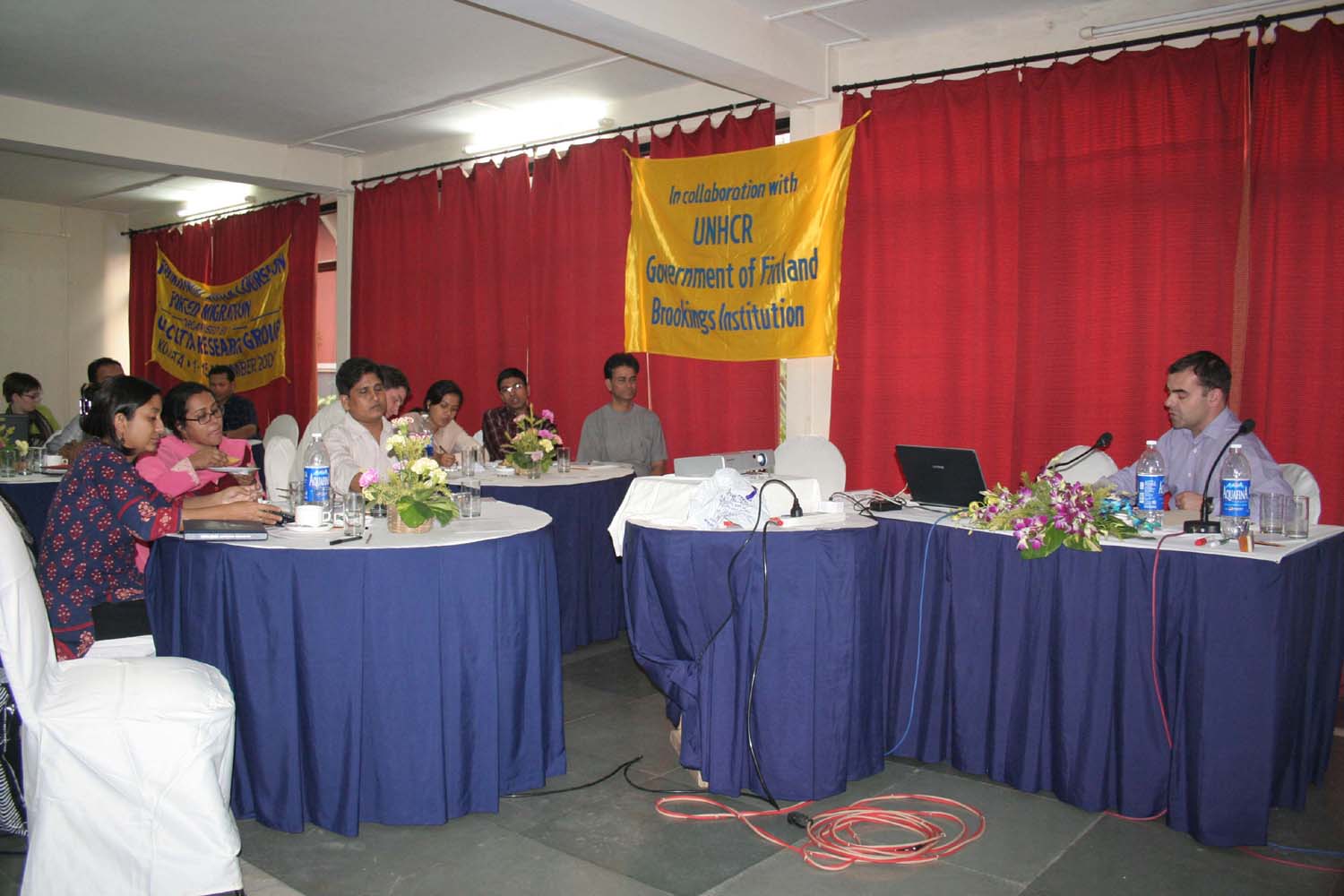
Khalid Koser of the Brookings Institution in an interactive session with the participants
Workshops Held
Prior to the Winter Course a number of
workshops were held. One workshop was held in collaboration with the
Punjab University, Chandigarh. In
that seminar CRG organized two panels on the issue of forced migration.
The speakers in these panels included Samir K. Das, Sabyasachi Basu
Ray Chowdhury, Paula Banerjee and Mika Aaltola.
In April 2006 CRG organized a workshop in Guwahati in collaboration
with Panos, South Asia. The participants were from different parts of East
and Northeast India. Other than CRG members the resource persons included
scholars and activists from Northeast India such as Walter Fernandez,
Sujata Dutta-Hazarika, Sanjay Borbora etc. In the summer of 2006 CRG
members Ranabir samaddar, Sanjay Chaturvedi and Anita Sengupta
participated in a seminar on the issue of borders in Europe and Asia.
In August another workshop was held in Kohima, Nagaland in
collaboration with Naga People’s Movement on Human Rights.
Between January and
March 2007 a number of workshops were held in different parts of South
Asia on the occasion of the release of the report on “Voices of IDPs”.
The report has been released in Katmandu in Nepal in collaboration with
Nepal Institute of Peace in February 2007.
Around the same time the report was released in Guwahati.
Panos, South Asia facilitated the release in Guwahati.
This was followed by a daylong trip of the media people to camps in
Kokrajhar, where part of the fieldwork was held. Detailed report on this
is in the later part of this report.
Public
Lectures
The CRG collaborated
with a number of institutions to organize public lectures before and after
the course. With the
Institute of International Law Jeevan Thiagrajajah’”s lecture was
organized in New Delhi. Ranabir
Samaddar and Paula Banerjee delivered two public lectures in Dhaka
University, Bangladesh in August 2006.
CRG members including Sabyasachi Basu Raychowdhury delivered public
lectures in February 2007 in Katmandu in collaboration with Friends for
Peace in Nepal. In Kolkata
Professor Sonia Dayan-Hezbrun of University of Paris VII, France addressed
a public lecture in February 2007.
Research
Programme
The CRG has designed
and organized a number of researches on the theme of forced migration in
collaboration with different institutes in South Asia.
The research on the “Voices of IDPs” was organized in
collaboration with a number of human rights group.
In Sri Lanka the research was conducted in collaboration with
National Peace Council in Colombo, in Nepal with the Nepal Institute of
Peace, Katmandu and in Bangladesh with Research Initiative of Bangladesh,
Dhaka.
The CRG has been able to set-up a well-organized network of institution
and individuals passionately committed to the cause of forced migrants in
South Asia. In the field of studies and discourses on forced migration it
has been able to establish itself as a premier institution.
Fourth Annual Winter Course on Forced Migration (1-15 December 2006, Kolkata)
(Venue – Conference Room, Swabhumi, Kolkata, unless otherwise stated)
Course Modules
(Compulsory)
A. Forced migration, racism, immigration and xenophobia
B. Gender dimensions of forced migration, vulnerabilities, and justice
C. International, regional, and the national legal regimes of protection, sovereignty and the principle of responsibility
D. Internal displacement with special reference to causes, linkages, and responses
(Optional)
E. Resource politics, environmental degradation, violence and displacement
F. Ethics of care and justice
Plus Field Visit, Seminars, Course Assignments, Workshops, Public Lectures, etc
1 December (Friday)
5.00 PM Inauguration, Sojourn Hotel (Salt Lake, Sector III, near Salt Lake Stadium, Kolkata 700106)
Inaugural Lecture Flavia Agnes, Women’s Rights Activist, Majlis, Mumbai
2 December (Saturday)
9.30 – 11.00 AM Explaining the Course and foundational concepts / Ranabir Samaddar
11.00 – 11.30 AM Tea break
11.30 – 1.00 PM Module B / Sumbul Rizvi, Protection Officer, UNHCR, India (Statelessness and Women)
1.00 – 2.00 PM Lunch break
(Flavia Agnes, Manabi Majumdar, Centre for Studies in Social Sciences, Kolkata; Ruchira Goswami, National University of Juridical Sciences, Kolkata,Priyanca Mathur, (participant) Moderator: Paula Banerjee, CRG & Calcutta University, Kolkata)
3.30 – 4.00 PM Tea break
4.00 – 5.30 PM Module A / Ranabir Samaddar
6.00 – 8.00 PM Library hours
3 December (Sunday)
9.30 – 11.00 AM Module A/ Manuela Bojadzijev, Projekt Migration, Frankfurt and Berlin (European Experiences of Racism and Immigration)
11.00 – 11.30 AM Tea break
11.30 – 1.00 PM Participants’ presentation under Module A (Moderator: Ranabir Samaddar)
1.00 – 2.00 PM Lunch break
2.00 – 3.30 PM Module A/Jagat Acharya, Bhutanese Refugee and Activist, Nepal Institute of Peace, Kathmandu ("Political, Social and Economic Discriminations in Bhutan and Bhutanese Refugee Question")
3.30
– 5.00 PM Panel
discussion on "Do Partition Refugees have a Right to Return? (
Jagat Acharya, Ranabir Samaddar, Subhoranjan Das Gupta,
Institute of Development
Studies, Kolkata, Samir Das, CRG & Calcutta University, Kolkata/ Vanita Banjan, Malkit
Singh,(participants) Moderator: Keya Dasgupta, Centre for Studies in Social Sciences,
Kolkata)
6.00 –
8.00
PM Library hours
4 December (Monday)
9.30 – 11.00 AM Module B/ Paula Banerjee, (Gender dimensions of Forced Migration)11.00 – 11.30 AM Tea break
11.30 –
1.00 PM Module
B/ Manuela Bojadzijev, (EU and European States' Policies towards Refugee
and illegal immigrant women)
1.00 – 2.00 PM Lunch break
2.00 – 3.30 PM Participants’ presentation under Module
B (Moderator: Paula Banerjee)
3.30 – 4.00 AM Tea break
4.00
– 5.30 PM Lecture
by OP Mishra, Centre for Refugee Studies, Jadavpur University
6.00
– 7.00 PM Discussion on revision of term papers under Modules A and B with
Ranabir Samaddar and Paula Banerjee and other concerned resource
persons (only with participants presenting papers under these two
modules)
7.00 –
8.00
PM Library hours
5 December (Tuesday)
9.30 – 11.00 AM
Module C/ Oishik Sircar, Pune ILC (The
Politics of Asylum Jurisprudence and International Protection)
11.00
– 11.30 AM Tea break
11.30 –
1.00 PM Module
C/ Parivelan Information Officer TNTRC,
Tamil Nadu
(The Need for National Legislation and Regional Convention for Refugees
and other Victims of Forced Migration)
1.00 – 2.00 PM Lunch break
2.00 – 3.30 PM Participants’ presentation under Module C (Moderator: Khalid Koser, Deputy Director, Brookings-Bern Project on Internal Displacement, Brookings Institution)
3.30 –
4.00 PM
Tea break
4.00 –
5.30 PM
Module
C / Khalid Koser, (Human Rights Origins of the International Regimes of
Protection of the Victims of Forced Migration)
6.00 –
8.00 PM
Library hours 11.00
– 11.30 AM Tea break
11.30 –
1.00 PM Module
D/ Mario Gomez, Bergh of Foundation, Colombo (Human rights
Commission and the Protection of the IDPs in Sri Lanka)
1.00
– 2.00 PM Lunch break
2.00 – 3.30 PM
Participants’ presentation under Module D (Moderator: Sabyasachi Basu
Ray Chaudhury CRG, Rabindra Bharati University, Kolkata)
3.30 –
4.00 PM
Tea break
4.00 –
5.30 PM
Roundtable
on"How Effective are the NHRCs in Protecting the Victims of Forced
Migration?" (Mario Gomez, O.P.Vyas, Khalil Ahmed, Uma Josi,
(Participants) Moderator: Parivelan) in collaboration with the dept of
South and Southeast Asian Studies, Calcutta University.
6.00 – 7.00 PM
Discussion on
revision of term papers under Module C and D with Parivelan and Sabyasachi
Basu Ray Chaudhury and concerned resource persons (only with participants
presenting papers under these modules)
7.00 –
8.00 PM
Library hours
9.30 – 11.00 AM
Module C/ Khoti Kamanga (Laws
and Displaced Women in Sub-Saharan Africa)
11.00
– 11.30 AM Tea break
11.30 –
1.00 PM
Participant's workshop on "Resources Violence and Displacement" Muhammad
Rafique, Judith Machhi, Mostafa Mahmud Naser, Saba Hussain, Nir Dahal, Nanda
Kishor, Ksenia Glebova, (Participants) (Moderator: Sabysachi Basu Rao Chaudhury)
1.00
– 2.00 PM Lunch break
3.30 –
4.00 PM Tea break
4.00 –
5.30 PM Camp
life and Voices of Refugees, Ranabir Samaddar and Paula Banerjee
6.00 –
8.00 PM
Library hours
8 December (Friday)
9.00 – 9.30 AM
Briefing
on field visit-Subhas Ranjan Chakraborty, President CRG and Sudeep
Basu, Institute of Development Studies, Kolkata
9.30 – 11.00 AM
Module
D/ Pradip Phanjoubam, Imphal Free Press (Hundred Years of
Displacement in Manipur)
11.00
– 11.30 AM Tea break
11.30 –
1.00 PM
Participant's workshop on "Forced Displacement in Northeast" Pradip
Phanjoubam, Meghna Guhathaurta, Dhaka University and RIB, Dhaka,Madhumita
Sengupta, Dilip Gogoi, Hina Shahid, Jason Miller, S.Y. Surendra Kumar,
(Participants) (Moderator: Samir Kumar Das)
1.00
– 2.00 PM Lunch break
3.30 –
4.00 PM Tea break
4.00 –
5.30 PM Interactive
session with Sohini Ghosh, filmmaker,Jamia Milia Islamia
6.00 –
8.00 PM
Library hours
9.30 – 11.00 AM
Film
Show and discussion 11.00
– 11.30 AM Tea break
11.30 –
1.00 PM Film
Show and discussion contd. / Moderator: Sohini Ghosh
1.00
– 2.00 PM Lunch break
3.30 –
4.00 PM Tea break
4.00 –
5.30 PM Two
parallel sessions on Modules E and F (Meghna Guhathakurta and Ranabir
Samaddar)
6.00 –
8.00 PM
Library hours
10 December (Sunday)
9.30 – 11.00 AM
Discussion
on Creative assignments 11.00
– 11.30 AM Tea break
11.30 –
1.00 PM Module
C/D Sabyasachi Basu Roy Chaudhury
1.00
– 2.00 PM Lunch break
11 December (Monday)
Field
Visit and Public Lecture
12 December (Tuesday)
(Field
Visit)
13 December (Wednesday)
12.00 Noon
Lunch 12.30
– 2.30 PM Module
C / Hans-Joachim Hentze, University of Ruhr, Bochum (International Regime
of Refugee Protection)
2.30 –
3.00 PM Tea
break
3.00 – 4.30 PM
Roundtable discussion
on "Is Palestinian Experience a Unique Experience in Refugee
Annals?" Eeva Puumala, Neha Bhat (participants) Sonia Dayan,
University of Paris VII, Ajay Gandhi, Human rights activist and
researcher, McGill University and Hans-Joachim Heintze,
Moderator:Subhas Chakraborty
14 December (Thursday /
Hotel Sojourm)
9.30 - 11.00 AM
Camp
life: Palestinian Experiences / Ajay Gandhi 11.00
– 11.30 AM Tea
break
11.30 –
1.00 PM Module
F / Roundtable on "Humanitarian Institutions and their Task of
Care" Shiva Dhungana, Oluwaniyi, (Participants) (Moderator: Ranabir
Samaddar)
1.00
– 2.00 PM
Lunch break
6.00 PM
Cultural
Evening
15 December (Friday /
Hotel Sojourm)
9.30 - 11.00 AM
Evaluation
(Sojourn Hotel)
5.00 PM
Valedictory Session, Sojourn Hotel (Salt Lake, Sector III, near Salt
Lake Stadium,
Kolkata 700106)
6
December
(Wednesday)
9.30 – 11.00 AM
Module D/ Khoti Kamanga, Lawyer, Coordinator of the Centre for
the Study of Forced Migration-University of Dar es Salaam and Secretary of
the International Association for the study of Forced Migration (IDP
Situation in Africa)
7 December (Thursday)
2.00 – 3.30 PM
Participant's workshop contd.
2.00 – 3.30 PM
Panel Discussion contd.
9 December (Saturday)
2.00 – 3.30 PM
Two parallel sessions on Modules E and F / Meghna Guhathakurta, and Samir
K. Das respectively
8.00 PM
Rail Journey (Field Visit)
Return Journey by train back to Kolkata
5.00 –
6.30 PM Public
lecture by Dr. Hans-Joachim Heintze in collaboration with the Dept of
International Relations, Jadavpur University, Kolkata
2.00 –
3.30 PM
Rountable Contd.
Presentation of
Certificates
Valedictory Address Hameeda
Hossain, Ain O Kendra, Dhaka on " Forced Migration and Trafficking of
Labour-Migrant Women Workers of Bangladesh"
Vote of
Thanks
Paula Banerjee
Roundtable Discussion in Calcutta University

7. Distance Education, the Modules and Assignments
The course is structured around six modules that have already been mentioned before. The participants are given reading materials on all six modules. The readings are divided in two sections - essential and supplementary. The course material is sent to the participants in a phased manner. The essential readings are sent to them during the distance education period, and the supplementary readings are given when the participants arrive in Kolkata for the direct orientation programme. The essential or core material is in many forms: books, and electrically sent material in form of attachments, CD, and web-posted and web-linked material. The supplementary materials included essays and book sections meant strictly for classroom, journals, are relevant web based materials. Some of the reading material is provided free of cost and some has to be bought by the participants at heavily subsidised rates.
The distance segment of the orientation course begins from 15 September. By 30 September most participants get the books and the module notes. An introductory note on each module is sent to the participants; along with these notes, lists, bibliographies, and other announcements are also sent. Introductory notes are considered extremely useful by the participants as they discussed the modules at some length. The abstracts of these Introductory notes to the modules are given below:
Module A (Forced
Migration,racism,immigration,and xenophobia)
core faculty member: Ranabir Samaddar
The first module deals with linkages between the phenomenon of forced migration and those of racism, xenophobia, and immigration.
While international law on protection of refugees deals with the condition, status, and the rights of persons who have already escaped the persecution and crossed the border to seek asylum, this module deals with what may be called the “root causes” of the flight. It is in this respect that we have to discuss the phenomena of racism and xenophobia, and the relation of the state controls on immigration with the issue of protection of refugees.
Also it must be borne in mind that whatever be the cause, refugees have a right to care, protection, and settlement, though it is true that if the root causes are not considered seriously, then there is a probability that we shall consider the refugee situation as a banal one, and neglect thereby the question of the rights of the refugees or the duty of the States and the international community to protect the escapees of violence. One example is around the concept of “well-founded fear” which is a test for grant of refugee status.
The “well-founded
fear” concept has evolved from a relatively simple inquiry within which the
refugee's subjective feelings of "terror" were prominent, to a much more complex
and wide-ranging inquiry within which concepts such as the "safe state" have
become increasingly the sole determinants of the issue of the well-founded fear.
Or
take this case, on which a jurist had to comment, “Refugee determination
procedure on individual basis and the unequal sharing of burden of care have now
produced confused, traumatized, and nervous shelter-seekers who travel rarely
with supportive documents, false or no papers, and land in alien systems which
are frequently hostile or incredulous" hosts”. In this case involving a Sri
Lanka Tamil who had fled persecution allegedly at the hands of the LTTE (R. SSHD
ex parte Karunakaran 25 January 2000, unreported), the judge commented, “The
civil standard of proof, which treats anything, which probably happened, is part
of a pragmatic legal fiction. It has no logical bearing on the assessment of the
likelihood of future events or (by parity of reasoning) the quality of past
ones... The method of evaluation is itself not one of hard facts. But it
requires knowledge not only of applicant's own tale, and what is accepted of it,
but a whole range of other factual matters.”
In any case, the dual phenomena of racism and
xenophobia have become almost universal phenomena. Xenophobia is a related
phenomenon; aggressive attitude towards national differences produces neo-racist
differences. It had been so earlier also. Partition of states produces the most
concentrated violence, reshaping states reshape minds, and the formation of new
states happens amidst mass murders, mass dislocations, and mass displacements.
Partition refugees are a special category, for they lose the right to return
even a right granted at least nominally to other groups of refugees.
The right to return is
a significant issue in this context. Although much debated internationally
the right to return is most clearly enshrined in the 1966 International Covenant
on Civil and Political Rights (ICCPR) under its provisions on the right to
freedom of movement (Article 12.4) which says that No one shall be arbitrarily
deprived of the right to enter his own country. But this right has often
proved to be a chimera at least in South Asia. A historian has shown that
perhaps the first group of people, though not refugees, whose right to
return was denied by a South Asian state were the Indian emigrants who travelled
abroad in the nineteenth century to work as plantation labourers. All through
the nationalist period the fate of these labourers in their country of domicile
was a rallying point for Indian leaders to portray the dark side of foreign
rule. There was constant reiteration that the state was responsible for all the
people who were born in India. Yet during the legislative assembly debates in
1944 the leaders came to a consensus that these émigrés rightfully belonged to
their country of domicile and not in India. Unlike nationalists during the
colonial period, the leaders of the post-colonial State formation project no
longer looked forward to the return of the emigrants who were slowly being
considered as foreigners. South Asian independence was accompanied by a
blood bath. The partition of India and Pakistan resulted in two million deaths
and about 15 million people were displaced. Most of the refugees were lucky
enough to get domicile and often citizenship in their country of domicile. Yet
problem arose over the issue of return. South Asian states passed legislations
whereby property of the displaced were confiscated by the State and treated as
enemy property. So the home that they wanted to go back to remained only
in their own imagination. One often hears the argument that because partition
refugees got an alternate citizenship they lost the right to return. In South
Asia there are however, other groups of refugees who remain as stateless people;
yet they are denied the right to return. We have the instances of two such
groups of refugees: the Chakmas (Jumma people) and the Bhutanese. The focus in
any discussion on the right to return of citizens expelled has to be thus on the
need to move away from the classical theories of sovereignty, democracy, State,
and citizenship, and take the exile, the alien, the displaced (both internally
and trans-border), and the half-citizen as the central figure of the politics in
South Asia, the figure who is with us like the eternally accompanying shadow, so
normalised that we forget its existence which we have taken for granted. In this
physical milieu of expulsion, de-enfranchisement, and nationalisation, the right
to return is at once the most crucial question and the most hallucinatory claim.
The last point that
this module discusses is the relation between refugee flow
immigration flow, and the way
these flows mix to form
massive and mixed flows of population groups in today's world.
Module A is the
beginning. But the module should offer enough glimpses of the problems in the
issue of refugee protection today, so that the following modules in this course
can be appreciated better. And, one must not forget that in all instances and
phenomena cited above gender stays as the most deeply inscribed category of
discrimination and difference, if discrimination and difference are taken as the
key opening words. A good beginning means an anticipation of the problems that
will arise at the end.
References
Etienne Balibar, in Etienne Balibar and Immanuel Wallerstein, Race, Nation, Class – Ambiguous Identities (Verso, 1991)
B.S. Chimni, International Refugee Law – A Reader (Sage Publications,
2003), section 5
Ranabir Samaddar (ed.), Peace Studies I (Sage Publications, 2004),
chapters 7-8, 13-14
Ranabir Samaddar (ed.), Refugees and the State (Sage Publications, 2003),
chapters 1-3, 6, 9
Ranabir Samaddar, The Marginal Nation (Sage Publications, 1999), chapters
1-4, 13
REFUGEE WATCH, “Scrutinising the Land Settlement Scheme in Bhutan”, No. 9, March
2000
REFUGEE WATCH, “Displacing the People the Nation Marches Ahead in Sri Lanka”,
No. 15, September 2001
Web-based
RW.: Displacing the People the Nation Marches Ahead in Sri Lanka http://www.safhr.org/refugee_watch15_7.htm
RW.: Mohajirs : The Refugees By Choice http://www.safhr.org/refugee_watch14_5.htm
TERM
PAPER
MODULE
A
Forced Migration,racism,immigration,and xenophobia
Write a note on how the syllabus and the reading material of this course connect the four key words of this module - forced migration, racism, immigration, and xenophobia - and build on the basis of these linkages an orientation course on forced migration.
OR
Prepare and present a fact sheet of newspaper reports (4 pages) on an event or topic related to any of the four themes mentioned in the title of the module and show thereby how a refugee situation or that of internal displacement is created.
OR
Discuss with the help of case studies the various elements involved in the "right to return" and argue in the context of those elements if the right to return can be considered as a substantive one or otherwise.
OR
Write a note on the context of the phrase, "mixed and massive flows" of migration, and show how this situation affects the task of protecting the refugees.
Module B (Gender
dimensions of forced migration, vulnerabilities, and justice)
core faculty member: Paula Banerjee
Over one percent of
the total world population today consists of refugees. More than eighty
percent of that number is made up of women and their dependent children.
An overwhelming majority of these women come from the developing world. South
Asia is the fourth largest refugee-producing region in the world. Again, a
majority of these refugees are made up of women. The sheer number of women among
the refugee population portrays the gendered nature of the issue. The nation
building projects in South Asia has led to the creation of a homogenised
identity of citizenship. State machineries seek to create a “unified”
and “national” citizenry that accepts the central role of the existing
elite. This is done through privileging majoritarian, male and monolithic
cultural values that deny the space to difference. Such a denial has often
led to the segregation of minorities, on the basis of caste, religion and gender
from the collective “we”. One way of marginalising women from body politic
is done by targeting them and displacing them in times of state verses community
conflicts. As a refugee a woman loses her individuality, subjectivity,
citizenship and her ability to make political choices. As political
non-subjects refugee women emerge as the symbol of difference between citizens
and its other: the refugees and the non-citizens. By taking some select examples
from South Asia in this module we will address such theoretical assumptions.
Here the category of refugee women will include women who have crossed
international borders and those who are internally displaced and are potential
refugees.
References
Paula Banerjee, Sabyasachi Basu Ray
Chaudhury and Samir Das, Internal Displacement in South Asia, chapter 9.
B.S. Chimni, International
Refugee Law – A Reader (Sage Publications, 2003), section 1
Ritu Menon and Kamla Bhasin,
Borders and Boundaries, chapter 3.
Joshva Raja, Refugees and their
Right to Communicate, chapter 8.
Ranabir Samaddar (ed.), Refugees
and the State (Sage Publications, 2003), chapter 9.
Ranabir Samaddar, The Marginal
Nation (Sage
Publications, 1999), chapter 12.
Refugee Watch, Nos. 10-11
UNHCR Policy on Refugee Women
Select UNICEF
Policy Recommendation on the Gender Dimensions of Internal Displacement
http://www.safhr.org/refugee_watch10&11_92.htm
CEDAW :
http://www.un.org/womenwatch/daw/cedaw/econvention.htm
RW.: Dislocated Subjects : The Story of Refugee Women
RW.: War and Its Impact on Women in Sri Lanka
RW : Afghan Women In Iran
RW.: Refugee Women of Bhutan
RW.: Rohingya Women – Stateless and Oppressed in Burma
RW.: Dislocating the Women and Making the Nation
TERM PAPER MODULE
B On
the basis of a close reading of B.S. Chimni's Reader address the debate: is it
desirable that women be treated as a separate legal category in international
and national legal regimes of protection. OR Compare
the situation of Sri Lankan women IDPs and Afghan refugee women in Pakistan. OR Why
listening to women's experiences and chronicling them is particularly relevant
for understanding refugee situations in South Asia. OR In
the context of women's displacement all over South Asia discuss women's lack of
control over institutional structures of protection. OR Is
lack of control over resources a reason for women's displacement? Argue
your case with reference to one particular group of women refugees/IDPs.
Module C (International,
regional, and national regimes of protection)
Module C deals with the international and national legal regimes of protection
of the victims of forced displacement and their right.
Refugee Law is a relatively new branch of International Law. The first major
step towards developing an international regime of protection was the 1951
Convention that was later modified by the 1967 Protocol. From then on the 1951
convention has formed the core of all Human Rights Law and Humanitarian Law for
the protection of refugees. The 1951 Convention defines a refugee as a person
who owing
to well-founded fear of being persecuted for reasons of race, religion,
nationality, membership of a particular social group or political opinion, is
outside the country of his nationality and is unable or, owing to such fear, is
unwilling to avail himself of the protection of that country; or who, not having
a nationality and being outside the country of his former habitual residence as
a result of such events, is unable or, owing to such fear, is unwilling to
return to it.
However since its inception there have been many objections to the provisions of
the 1951 convention. It is said that the Convention mandates protection for
those whose civil and political rights are violated, without protecting persons
whose socio-economic rights are at risk. Also it has been criticised on the
grounds of its Euro centrism, and insensitivity towards the internecine racial,
ethnic and religious conflicts in third world, which has resulted in the
creation of refugees in large numbers. The provisions of the convention have
served well for the protection of refugees during the Cold War times but have
failed to do so after that. Today the first world often attempts at dealing
with the refugee problems ‘at source’. This has led to the international
interference in the internal matters of a sovereign nation creating further
problems for states and for the displaced. This has been witnessed very recently
in the Darfur region of Sudan and in past in former Yugoslavia, Somalia, and
other African countries.
Today
provisions of the 1951 Convention seems dated and in need for further revision
due to increased complexities in the process of refugee generation, protection
and also due to advances in the field of refugee studies. The increased focus on
refugee studies has led to broadening of definitions of ‘refugee’, ‘protection’,
‘rights’, ‘justice’ etc. As a result of all these reasons the 1951 Convention
has not been ratified by many nations of the world. Many regions have developed
its own regimes for protection of people facing forced displacement. The OAU
Convention expanded the definition of refugee contained in the 1951 Convention.
The OAU Convention defines the term “refugee” to include persons fleeing their
country of origin due to external aggression, occupation, foreign domination, or
events seriously disturbing public order in either a part or the whole of the
country of origin or nationality. This implies that “well-founded fear” is a
subjective category and anyone facing civil and political disturbances and war
need not prove their well-founded fear for life. The Cartagena Declaration
recommends a definition similar to that contained in the OAU Convention. In so
far as Asia is concerned mention may be made of the Asian African Legal
Consultative Committee (AALCC) in 1966. But this has not had the impact of
either the OAU Convention or the Cartagena Declaration. South Asia has not been
able to develop a legal regime for refugees or IDPs.
In
this module we have focusses on the various aspects of refugee protection at an
international level in general and on South Asian level in particular (Module D
discusses in details the legal principles of protection of IDPs).
Paula
Banerjee, Sabyasachi Basu Ray Chaudhury and Samir Das, Internal Displacement
in South Asia, Epilogue
F-e-material 1 – International Humanitarian Law and
Human Rights Law
Convention Against Torture
REFUGEE
WATCH
TERM PAPER MODULE
C
The partition of the
Indian subcontinent in 1947 witnessed probably the largest refugee movement in
modern history. About 8 million Hindus and Sikhs left Pakistan to resettle
in India while about 6-7 million Muslims went to Pakistan. Such transfer
of population was accompanied by horrific violence. Some 50,000 Muslim
women in India and 33,000 non-Muslim women in Pakistan were abducted, abandoned
or separated from their families. Women's experiences of migration, abduction
and destitution during partition and State's responses to it is a pointer to the
relationship between women's position as marginal participants in state politics
and gender subordination as perpetrated by the State. In this context the
experiences of abducted women and their often forcible repatriation by the State
assumes enormous importance today when thousands of South Asian women are either
refugees, migrants or stateless within the subcontinent. Abducted women
were not considered as legal entities with political and constitutional rights.
All choices were denied to them and while the state patronised them verbally by
portraying their “need” for protection it also infantilised them by giving
decision making power to their guardians who were defined by the male pronoun
“he”. Even today the refugee women do not represent themselves.
Officials represent them. For the abducted women it was their sexuality
that threatened their security and the honour of the nation.
Refugee women from
other parts of South Asia reflect trauma faced by women belonging to communities
considered as disorderly by the state. During multiple displacements women who
have never coped with such situations before are often at a loss for necessary
papers. When separated from male members of their family they are
vulnerable to sexual abuse. The camps are not conducive for the personal safety
of women, as they enjoy no privacy. But what is more worrying is that
without any institutional support women become particularly vulnerable to human
traffickers. These people aided by network of criminals force women into
prostitution. Millions of rupees change hands in this trade and more lives
get wrecked every day. Many displaced women who are unable to cross
international border swell the ranks of the internally displaced. Even in IDP
camps women are responsible for holding together fragmented families.
Today roughly one-third of all households in Sri Lanka are headed by women and
the numbers increase many fold in the camps for internally displaced.
Although 89 percent women in Sri Lanka are literate, due to two decades of armed
conflict women from North and East have lower levels of education with one in
every four being illiterate. A report based on a research carried
out at Mannar district portray that among 190,000 IDPs women often find it
impossible to generate enough income for buying food for the whole family.
In Illupakkadavai, all 36 heads of female-headed households stated that they
rely on dry rations for approximately 90 percent for their nutritional needs and
that the children of women headed households are most vulnerable to
exploitation. In Sri Lanka suicide rates for women have doubled in the
last two decades.
None of the South
Asian states are signatories to the 1951 Convention relating to the Status of
Refugees or the 1967 Protocol. As India is the largest South Asian state
it should be interesting to see how women refugees are dealt with here. In
India Articles 14, 21 and 25 under Fundamental Rights guarantees the Right to
Equality, Right to Life and Liberty and Freedom of Religion of citizens and
aliens alike. Like the other South Asian states India had ratified the
1979 Convention on the Elimination of all Forms of Discrimination Against Women
in 1993. Although there is no incorporation of international treaty
obligations in the Municipal laws still rights accruing to the refugees in India
under Articles 14, 21 and 25 can be enforced in the Supreme Court under Article
32 and in the High Court under Article 226. The other guiding principles
for refugees are the executive orders that have been passed under the Foreigners
Act of 1946 and the Passport Act of 1967. The National Human Rights
Commission has also taken up questions regarding the protection of refugees.
It approached the Supreme Court under Article 32 of the Constitution and stopped
the Expulsion of Chakma refugees from Northeast India. Yet all these orders are
ad hoc in nature and the legal position remains nebulous. This is true not
just of India but all of South Asia.
The overwhelming presence of women among displaced populations is not an
accident of history. It is a way by which states have made women political
non-subjects. By making women permanent refugee, living a savage life in
camps, it is easy to homogenise them, ignore their identity, individuality and
subjectivity. By reducing refugee women to the status of mere victims in
our own narratives we accept the homogenisation of women and their
depoliticisation. We legitimise a space where states can make certain
groups of people political non-subjects. In this module we intend to
discuss the causes of such depoliticisation that often results in displacements.
We will also discuss the situation of displaced women in South Asia and consider
policy alternatives that might help in their rehabilitation and care.
Web-based
http://www.safhr.org/refugee_watch10&11_92.htm
http://www.safhr.org/refugee_watch10&11_8.htm
http://www.safhr.org/refugee_watch10&11_4.htm
http://www.safhr.org/refugee_watch10&11_6.htm
http://www.safhr.org/refugee_watch10&11_5.htm
http://www.safhr.org/refugee_watch10&11_5.htm
http://www.safhr.org/refugee_watch17_1.htm
http://www.unifemantitrafficking.org/main.html
Gender
dimensions of forced migration, vulnerabilities, and justice
Core faculty member: Khalid Koser
Another failure of the Convention has been the inability to recognise the
special needs of women, children, and aged people within the sections of
refugees, though this has been addressed to some extent in the provisions of
CEDAW convention. In 1985, the UNHCR Executive Committee adopted Conclusion No.
39 that recognised that refugee women and girls formed a majority among the
world refugee population. The Conclusion also recognised that states were free
to consider women facing inhuman treatment as belonging to a particular social
group within the 1951 convention. In October 1993 the UNHCR adopted Conclusion
No. 73 that stated that all those who have suffered sexual violence should be
treated with particular sensitivity. However, there is little in UNHCR
guidelines that can make women victims of sexual violence as special claimants
for refugee protection.
None
of the South Asian states are a signatory to the 1951 Convention or the 67
Protocol. India has also stayed away from these mechanisms, citing certain
biases in the provisions of the convention. However, it has developed its own
provisions to deal with the problems of refugees on a case-by-case basis in
absence of a consistent national policy. This has its own problems, for example
India has provided all possible help to Tibetan refugee due to its own political
necessities but has not done so with the Bangladeshi and Bhutanese refugees. The
provisions of Indian state has also not progressed with the evolution of
feminist critic of the protection regimes which needs attention and creation of
a consistent policy accommodating the faults in current practices.Not
everyone who applies for refugee status can get protection. In 1951 Convention
there are a list of “exclusion clauses” containing categories of persons who do
not deserve international protection.
References
B.S. Chimni, International Refugee Law – A Reader (Sage Publications,
2003)
Who is a Refugee?, Pgs. 1-81; Asylum, Pgs. 82-160; Rights and Duties of a
Refugee, Pgs. 161-209
Ranabir Samaddar (ed.), Refugees and the State (Sage Publications, 2003),
chapters 10-11.
Refugee Watch No.4 (December 1998) articles by Sarbani Sen and Brian Gorlick.
Web-based
Document printed from the website of the ICRC.
URL: http://www.icrc.org/web/eng/siteeng0.nsf/html/57JMRT
International Committee of the Red Cross
CAT:
http://www.un.org/documents/ga/res/39/a39r046.htm
International,
regional, and the national regimes of protection
Do you think that the category of "well-founded fear" reflects subjectivity in the definition of refugees as indicated in the Convention Relating to the Status of Refugees? Comment in the light of the definition adopted by the OAU Convention.
OR
Examine the principle of non-refoulement in relation to the policy of non-entrée.
OR
Do you think that there is a need for a national law on refugees? Argue your case with reference to experiences of any country.
OR
Explain how the Conclusion No. 39 and 73 adopted by the UNHCR Executive Committee and the CEDAW have attempted to take into account the special needs of women refugees.
OR
How the internally displaced persons can return to the places of their habitual residence and/or resettled? Discuss with special reference to Principles 28 and 29 of the UN Guiding Principles
Module D (Internal
displacement - causes, linkages, and responses)
Core faculty member: Sabyasachi Basu Ray Chaudhuri
The eviction of indigenous people from their land is a recurrent theme in South Asia. Be it Ranigaon, Golai, Motakeda, Somthana, Ahmedabad, Bandarban, or Trincomalee, thousands of families are being evicted from their homes either in the name of conflict or in the name of modernization. They are being forced to stay in the open, in pouring rain with a number of them suffering from malnutrition and starvation and they are fearful for their lives at most times. The last two decades have witnessed an enormous increase in the number of internally displaced people in South Asia. Their situation is particularly vulnerable because unlike the refugees they are unable to move away from the site of conflict and have to remain within a state in which they were displaced in the first place. These unfortunate people who have been displaced once are often displaced multiple times by the hands of the powers that be. Yet as displaced they do not have the capacity to cross international borders but seek rehabilitation from the powers that are responsible for their displacement in the first place.
The situation of the internally displaced persons (IDPs) seems particularly vulnerable when one considers that there are hardly any legal mechanisms that guide their rehabilitation and care in South Asia. Since the early 1990s the need for a separate legal mechanism for IDPs in South Asia has increasingly been felt. This is not only to compile new laws but also to bring together the existing laws within a single legal instrument and to plug the loopholes detected in them over the years. Only recently the international community has developed such a mechanism that is popularly known as the UN Guiding Principles on internal displacement. This has given us a framework within which rehabilitation and care of internally displaced people in South Asia can be organised. Keeping that in mind it becomes imperative for scholars working on issues of forced migration in South Asia to consider whether South Asian states have taken the Guiding Principles into account while organising programmes for rehabilitation and care for the internally displaced persons (IDPs).
The Guiding Principles on Internally Displaced Persons set out the rights of internally displaced persons relevant to the needs they encounter in different stages of displacement. The Guiding Principles provide a handy schematic of how to design a national policy or law on internal displacement that is focused on the individuals concerned and responsive to the requirements of international law. Similarly, governments (and particularly national human rights institutions where they exist), advocates, and displaced persons can use the Guiding Principles as a means to measure the compliance of existing laws and policies with international standards. Finally, their simplicity allows the Guiding Principles to effectively inform the internally displaced themselves of their rights. The Guiding Principles are thus part of a growing number of “soft law” instruments that have come to characterize norm-making in the human rights field as well as other areas of international law, in particular environmental, labor and finance.
The
short notes to the questions presented below indicate the discussions that this
module aims to discuss.
What Types of Displacement are Prohibited by the Guiding Principles?
Principle 6 affirms that “[e]very human being shall have the right to be protected against being arbitrarily displaced from his or her home or place of habitual residence.” Support for this proposition can be found in humanitarian law and also in the right to movement, guaranteed by a number of human rights instruments, which can be reasonably expected to have as its corollary the “right not to move.” Where displacement is to occur outside the context of armed conflict, Principle 7 provides a list of procedural protections that must be guaranteed, including decision- making and enforcement by appropriate authorities, involvement of and consultation with those to be affected and the provision of an effective remedy for those wishing to challenge their displacement. These provisions are, of course, of particular interest to those facing displacement for development projects.Moreover, in either context, “all measures” must be taken to minimize the effects and duration of the displacement and the responsible authorities are required to ensure “to the greatest practicable extent” that the basic needs of those displaced (e.g., shelter, safety, nutrition, health, and hygiene) are met. It should also be noted that Principal 9 articulates a “special obligation” to protection against displacement of a number of groups whose special attachment to territory has been recognized in international law, including indigenous persons, minorities, peasants, and pastoralists.
What Rights do Persons have once Displaced?
Displaced persons enjoy the full range of rights enjoyed by civilians in humanitarian law and by every human being in human rights law. These include the rights to life, integrity and dignity of the person (e.g., freedom from rape and torture), non-discrimination, recognition as a person before the law, freedom from arbitrary detention, liberty of movement, respect for family life, an adequate standard of living (including to access to basic humanitarian needs), medical care, access to legal remedies, possession of property, freedom of expression, freedom of religion, participation in public life, and education, as set out in Principles 10-23.In several instances, the Guiding Principles specify how generally expressed rights apply in situations of displacement. These should be of particular interest to those designing and assessing domestic policies on internal displacement. For example, Principle 12 provides that, to give effect to the right of liberty from arbitrary detention, internally displaced persons “shall not be interned in or confined in a camp” absent “exceptional circumstances” and that they shall not be subject to discriminatory arrest “as a result of their displacement.” Likewise Principle 20 provides that the right to “recognition everywhere as a person before the law” should be given effect for displaced persons by authorities facilitating the issuance of “all documents necessary for the enjoyment and exercise of their legal rights, such as passports, personal identification documents, birth certificates and marriage certificates.” The Guiding Principles provide for special consideration of the needs of women and children (including “positive discrimination” or affirmative activities on behalf of governments to model assistance and protection to their particular needs, consultation and involvement in decisions regarding their displacement and return or resettlement, protection against recruitment of minors and free and compulsory education), as well as for other especially vulnerable groups, such as the elderly and disabled.
What Help Should Displaced Persons Expect with Return, Reintegration and Resettlement?
The Guiding Principles provide that competent authorities have “the primary duty and responsibility” to assist displaced persons by providing the means as well as by establishing conditions for return to their places of origin, or for resettlement in another part of the country (Principle 28). Any return or resettlement must be voluntary and carried out in conditions of safety and dignity for those involved. As a corollary to the right to free movement, therefore, displaced persons have the right to return to their homes. Although the right to return or resettle is not expressly stated in any particular human rights instrument, this interpretation of the right of free movement is strongly supported by resolutions of the Security Council, decisions of treaty monitoring bodies, and other sources of authority. However, though the displaced have the right to return, Principle 28 carefully specifies that they must not be forced to do so, particularly (but not only) when their safety would be imperiled. The issue of the voluntariness of return or resettlement is recurrent in protracted displacement situations around the world. In many places, governments and insurgent groups have ceded to the temptation to use the return or resettlement of displaced persons as a political tool.
Are their any special provisions for women?
In the guiding principles a concerted attempt was made to prioritise gender issues. For example, while discussing groups that needed special attention in Principle 4 it was stated that expectant mothers, mothers with young children and female heads of households, among others, are people who may need special attention. In Principle 7 it was stated that when displacement occurred due to reasons other than armed conflict authorities should involve women who are affected, in the planning and management of their relocation. Principle 9 upheld that IDPs should be protected in particular against “Rape, mutilation, torture, cruel, inhuman or degrading treatment or punishment, and other outrages upon personal dignity, such as acts of gender-specific violence, forced prostitution and any other form of indecent assault.” Special protection was also sought against sexual exploitation. Principle 19 stated that attention should be given to the health needs of women and Principle 20 stated that both men and women had equal rights to obtain government documents in their own names. Apart from the Guiding Principles there are other international mechanisms that displaced women can access. They include the 1979 Convention on the Elimination of All Forms of Discrimination against Women (hereafter CEDAW) and the 1999 Optional Protocol sets out specific steps for states to become proactive in their efforts to eliminate discrimination against displaced women.
Are the Guiding Principles legally binding?
Although the UN Guiding Principles on Internal Displacement is not a legally binding treaty it is formed of principles that are based on established legal mechanisms for aiding the human rights of the displaced people. Many of these Principles may gradually attain the status of customary international law. But as Francis Deng reminds us, “for the time being they serve as a morally binding statement.” A statement of this nature that promises to be ‘morally binding’ on a wide spectrum of primarily national governments and secondarily, other relevant international and non-governmental agencies must cut across the well-known divisions of the prevailing ethical and moral systems and elaborate itself in a way that it does not remain captive to any particular modality of moral reasoning. Plurality of such systems and modalities is helpful in building the much-needed ‘moral consensus’ around these principles.
References
Paula
Banerjee, Sabyasachi Basu Ray Chaudhury and Samir Das, Internal Displacement
in
South Asia.
Addressing Internal Displacement: A Framework For National Responsibility
Guiding Principles on Internal Displacement
Web-based
1. E-material: Protection of Internally Displaced Persons: Inter-Agency Standing Committee Policy Paper
3. E-e-material3:An Overview of Revisions to the World Bank Resettlement Policy
Plus other book extracts, essays, articles, lectures & web-based material.
TERM PAPER
MODULE
D
Show how the UN Guiding Principles on Internal Displacement base themselves on human rights and humanitarian legal regimes.
OR
What are the special provisions for Women IDPs in international regimes of protection and care of IDPs. How far have they helped the cause of women's rehabilitation and care?
OR
On the basis of a close reading of Internal Displacement in South Asia write an essay on how development have often led to displacement in South Asia.
OR
How relevant are the UN Guiding Principles for different countries in South Asia?
OR
Compare the situation of conflict related IDPs and Tsunami related IDPs in Sri Lanka.
OR
When does displacement end?
Module E (Resource
politics, environmental
degradation, and
forced migration)
Core faculty member: Meghna Guhathakurta
Annually, the lives
and livelihoods of millions of people across the globe are affected by forced
displacement due to ethnic conflicts, infrastructure projects like dams, mines,
industries, power plants, and roads and then due to natural disasters such as
floods, river erosion etc. The forced migration is due to many reasons but
question of control over natural resource has been at the centre of these
reasons. Even in displacements induced by conflicts, it is the question of
resources that lies at the heart of most of these conflicts. The situation in
South Asia is no exception. This module is thus designed to give a comprehensive
understanding of the following issues:
1.Resources lie at the heart of conflicts, which
in turn lead to forcible displacement of groups of population.
2.The concept of environmental degradation and
environmental displacement.
3.The effect of resource politics and
environmental degradation on women.
4.Impact of globalisation on the resource
politics, environmental destruction and forced migration.
5.Guidelines on how to prevent such displacement
and how to shape adequate policies to ensure the adequate rehabilitation of
the displaced.
6.South Asian dynamics of the resource politics
and ensuing conflict between nations.
This module would thus
deal with these questions through specific case studies from North East India
and other parts of India and South Asia taking up issues of ethnic conflict, and
developmental displacement - all due to resource conflicts and environmental
degradation. The module will discuss the experiences of the Northeast in
particular. The resource conflict and forced migration are closely inter-linked.
In India, this operates at various levels and regions and is reflected in the
developmental imbalances across sections of society regionally and nationally.
The worst manifestation of this has been again in the North East. The land use
pattern in North East India has also contributed towards the ensuing conflict
between various communities and environmental destruction. Prior to independence
if British encouraged plantation agriculture and brought many labourers from
outside now it is the time of modern day developmental agencies who have been
trying to change the agricultural patterns of the indigenous people and trying
to encourage coffee plantation and other crops which are not viable in this
region. The plantation labourers now termed, as 'outsiders' has now become
target of local conflicts. The crisis in plantation economies has also rendered
many people jobless and vast tracts of land unutilised and in control of private
parties. A large chunk of land is also inhabited by the various security
agencies in the region that further aggravates the situation. The region has
also suffered considerable environmental destruction due to large scale
deforestation leading to frequent land slide, increased siltation of rivers,
floods, and river erosion displacing a large number of people. The
phenomenon of globalisation has further aggravated the resource crisis by
creating new demands for the resources and introducing private corporations with
large financial resources. This has brought them in direct conflict with the
communities who were early enjoying these resources and are now being handed
over to private corporations by state for a price. One can see it, among others,
from the extent of land most states acquire for private companies. For example,
Orissa had acquired 40,000 ha for industries during 1951-1995 but plans to
acquire 100,000 ha in a decade. Andhra Pradesh has acquired in five years half
as much land for industry as it did in 45 years. Similar quantities are being
acquired in Jharkhand for mines that foreign companies are eyeing. Goa had
acquired 3.5 per cent of the state's landmass in 1965-1995 and plans to acquire
7.2 per cent of it during this decade. Our experience suggests that governments
have expressed their inability in rehabilitating IDPs citing paucity of land so,
any land acquisition will happen only by confiscating common property resources
(CPRs) being used by other communities causing tension between host communities
and oustees, and culturable waste land which will need investment of an
unusually higher order than the amount of compensation paid by the government.
This needs to be understood that the CPRs are crucial to people's sustenance.
There are also instances where the rivers are being privatised; water systems
are being privatised and creating extraordinary demands on the existing
resources leading to environmental destruction. The mindless exploitation of
resources and unregulated discharge of harmful chemicals and waste materials are
contributing to the environmental degradation. All these factors are together
contributing towards resource and environmental crisis leading to forced
migration of people
REVIEW ASSIGNMENTS
MODULE
E
Resource politics, environmental degradation, and forced migration
On the basis of your reading of Meghna Guhathakurta's article "Globalization, Class and Gender Relations: The Shrimp Industry in South-western Bangladesh," Report on the Workshop on Engendering R & R (both available in CRG website) and the chapter entitled "Shefali" in Marginal Nations, analyse how lack of control over resources have led to large-scale displacement of women?
OR
On reading "Development Induced Displacement in Pakistan," in Refugee Watch (available in CRG website) and "Pakistan: Development and Disaster" in Internal Displacement in South Asia, comment on how the developmental model that has been favoured by the Pakistani state have led to large-scale dispossession and displacement of people?
OR
On reading Sabyasachi Basu Ray Chaudhury's "Uprooted Twice: Refugees From the Chittagong Hill Tracts," in Refugees and the State do you agree that conflict in CHT is in the last resort a conflict over land.
OR
Do you think that ethnicity is an adequate notion to use in the conext of the politics of land-use in India's North-east? Discuss in the light of your reading of Sanjoy Barbora's article "Ethnic politics and Land-use: Genesis of conflicts in India's North-east"
OR
On reading "Development Induced Displacement in Pakistan," in Refugee Watch (available in CRG website) and "Pakistan: Development and Disaster" in Internal Displacement in South Asia, comment and Scrutinizing the Land Resettlement Scheme in Bhutan explain how the development paradigms of the Pakistan and Bhutanese states have led to displacement of populations as well as assess their capacities to handle resettlement schemes.
Module
F (Ethics
of care and justice )
Core faculty member: Samir Kumar Das
Why should we care for
and protect the victims of forced displacement? The “we” here refers
to those who have not had experienced displacement themselves, yet harbour
some form of an ethical commitment to the victims of forced displacement.
The ethical language therefore is expected to establish some form of a
connection between us and them, between those who are not forcibly
displaced and those who are. Ethical language therefore is a language of
universality that cuts across the given boundaries of the victims' groups
and communities. While ethical language has to be universal, the
phenomenon of forced displacement is not. It is true that the incidence of
forced displacement has alarmingly been on the rise.
REVIEW ASSIGNMENTS MODULE
F
What we see is the
presence of a wide variety of argumentation and reasoning offered by us in
justification of our advocacies for care and protection of the displaced
persons. First of all, there is the rights-based argument. Care and
protection according to this argument, will be construed as our 'duty'
insofar as the 'well being' of the displaced persons becomes 'a sufficient
reason for holding us to be under this duty'. The problem recognized by
almost all the exponents of this argument is that the right against
displacement is not an end in itself and cannot per se be regarded as the
'sufficient reason' for holding us under this duty. Sufficiency of reason
does not reflect itself in the same way as in the two advocacies for the
right against displacement and say, the right to life. If one's
displacement becomes a necessary condition for another's enjoyment of the
right to life often understood as decent life, we can say that the
former is derogable and the latter is not. Thus, the right against
eviction routinely carried out in the metropolitan cities of South Asia whether
in Dhaka, Kolkata or Islamabad or elsewhere, has to contend with the
argument for development and decent life defined everywhere as a
'collective goal of the community as a whole'. This takes us to the heart
of our second argument. According to it, care and protection always follow
the established lines of community and kinship. Organizing responses
beyond these lines proves particularly difficult especially in South Asia
where community and kinship ties are found to be exceptionally strong. The
community-based argument evidently has its limits: in course of organizing
the responses, it not only reinforces the traditional lines of rivalry,
but reenacts the inequities and asymmetries otherwise internal to these
bodies. Various reports emphasize how life in camps, allocation and
utilization of aid and assistance for the displaced persons reinforce the
kinship and community lineages and become the fertile ground for future
tensions and ethnic strife. The limits of the community-based argument are
sought to be overcome by what we call, the humanitarian argument. Today,
the humanitarian ethics seldom turns on one's own self. It instead
considers others as equal ethical agents in the sense that they are as
much entitled to 'purity and perfection' as we are. Viewed in this light,
our care and protection are a tribute to their ethical entitlements, of
which they are otherwise deprived.
Humanitarian ethics
thus has two presuppositions: first, displacement in South Asia cannot be
fathomed without the metaphor of home for it is not simply where we live
or to which all of us are morally entitled like many other objects of our
social existence, but it is the fountainhead of all our moral and ethical
entitlements. Almost all the South Asian societies make a distinction
between the home we simply live in and the home that helps shape what we
aspire to become and therefore invest us with our moral identities. Any
involuntary displacement is a disjuncture between home and home, between
what we are and what we want to become, between our senses of lack and
fulfillment. Secondly, should a conflict arise between our and their moral
entitlements, humanitarian ethics always settles for a minimalist course.
Those of us who have the commitment to and power of taking care and
protecting the displaced persons will be under any moral obligation if and
only if by taking care and protecting them we 'do not sacrifice anything
of comparable moral importance', that is to say, our own right to life and
livelihood.
The module discusses
these ethical standpoints and goes deep into the relation between the
human rights and humanitarian standpoints with regard to the needs of the
displaced.
From the optional module the participants were expected to select one
question for their review essay and from the compulsory modules they were
required to write their term paper. To facilitate their work all tutors in
charge of compulsory modules held chat sessions with participants who
wanted to discuss their assignments with them.
Only Khalid Koser was unable to do so but he had long discussions
with participants via email. The
written assignments were graded and the module tutors gave their comments
that were posted on the web so that the participants could improve their
writings if they so desired. The
participants were given a grade for distance education and another for
their on sight training in Kolkata. Grades
were confidential and only the participants had access to their personal
grades. Please find below the written assignments:
Ethics of care and justice
Review relevant sections on ethics and justice in B.S. Chimni's International Refugee Law: A Reader and comment on the importance of these two issues in rehabilitation and care of refugees.
OR
After reading Ranabir Samaddar's article on "Power, Fear, Ethics," in Refugee Watch critically discuss "fear" as a factor in the displacement of vulnerable groups.
OR
Critically analyse Peter Penz's article on "Development, displacement and International Ethics," and comment how ethical it is to displace people for reasons of development?
List of
Participants and Assignments
|
Sl
No. |
Name
of the Participant |
Country |
Email
ID |
Module
chosen for Review Assignment
|
Module
chosen for Term Paper |
|
1 |
Mustafa Mahmud
Naser (M) |
Bangladesh |
mnaserbd@yahoo.com |
E |
C |
|
2 |
Mohammed Abdur
Rashid (M) |
Bangladesh |
rashid302001@yahoo.com |
E |
D |
|
3 |
Malkit Singh
(M) |
India |
malkit78singh2002@yahoo.co.in |
F |
A |
|
4 |
Madhumita Sengupta(F) |
India |
madhumita1204@yahoo.co.in |
E |
A |
|
5 |
Saba Hussain
(F) |
India |
saba_hussain@rediffmail.com/ saba_hussain229@yahoo.com. |
E |
C |
|
6 |
Dilip Gogoi
(M) |
India |
dilip119@yahoo.co.uk |
F |
C |
|
7 |
Priyanka Mathur
Velath (F) |
India |
priyanca_m@yahoo.com |
F |
D |
|
8 |
Vanita Banjan
(F) |
India |
vbanjan@rediffmail.com / vbanjan@yahoo.com |
E |
A |
|
9 |
OP
Vyas (M) |
India |
opvyas85@yahoo.co.in |
E |
A |
|
10 |
Khaleel
Ahmed (M) |
India |
zimidaran_3@yahoo.com |
E |
C |
|
11 |
SY
Surendra Kumar (M) |
India |
surendrajnu@gmail.com / mahipande@yahoo.co.in |
F |
D |
|
12 |
Nanda Kishor
(M) |
India |
srijankishor@yahoo.com / kishulovesu2@yahoo.com |
F |
D |
|
13 |
Nir
Prasad Dahal (M) |
Nepal |
nirdahal@yahoo.com |
F |
D |
|
14 |
Uma Joshi
(F) |
Nepal |
joshi.uma@gmail.com / umananu99@yahoo.com |
F |
D |
|
15 |
Shiva
Kumar Dhungana (M) |
Nepal |
skdhungana@gmail.com / skdhungana@yahoo.com |
F |
D |
|
16 |
Hina Shahid
(F) |
Pakistan |
hinaswm@yahoo.com |
E |
D |
|
17 |
Ksenia Glebova
(F) |
Finland |
kglebova@mappi.helsinki.fi / ksenia_glebova@yahoo.com |
E |
B |
|
18 |
Eeva Puumala
(F) |
Finland |
Eeva.Puumala@uta.fi / e_puumala@yahoo.com |
F |
A |
|
19 |
Oluwatoyin Oluwaniyi
(F) |
Nigeria |
otoldo_olu@yahoo.com |
E |
B |
|
20 |
Judith Machhi
(F) |
Switzerland |
macchi.judith@bluewin.ch / judith_macchi@yahoo.com |
E |
B |
|
21 |
Jason Miller
(M) |
Thailand |
jasonmiller79@hotmail.com / jason_at_mcrg@yahoo.com |
F |
D |
8. Creative Assignments
One of the significant features of the course was the segment of
creative assignments, which were taken up and completed by the
participants with great satisfaction.
Suggestions for the
creative assignment were sent to participants before they arrived in
Kolkata and they were asked to bring completed assignments along with them
to the course. The assignments dealt with refugees or IDPs and treated
situations of displacement in creative ways.
Creative assignments were then exhibited, presented, in case of
documentary films shown, and discussed by the faculty and all the
participants in Kolkata.
The following
suggestions for creative assignments were made:
1. Suppose you are an
editor of a magazine. Prepare a special issue of the magazine on issues of
forced migration.
2. Prepare a 4-5 day
course syllabus, which will include issues of Forced Migration, Refugees
and Internally Displaced Persons.
3. Prepare an
investigative report of any situation of forced displacement in your
region (local or national).
4. Prepare short
commentaries on the recent reforms towards relief & rehabilitation of
IDPs in your countries; these can be posted on Refugee Watch Online.
5. Write a short story
on the situation of any refugee/IDP group.
6. Prepare either a
photo exhibit or a poster exhibit on situations of forced displacement.
7. Write few songs on
the situation of the victims of forced displacement.
8. Collect some
literary pieces (songs, poems, stories) on the theme of forced migration
and prepare a compendium with them.
9. A ten minutes
documentary on any situation of forced displacement.
10. A short play on a
refugee situation that might be performed during the cultural evening.
Accordingly some of the participants set up a photo gallery during the
course made up of photographs of refugee life and different displacement
situations. One participant presented an exhibition of black-and-white
photographs with detailed captions documenting the situation of internally
displaced Burmese and Burmese residing in refugee camps in Thailand. Dilip
Gogoi also presented a series of photos on the aftermath of the Karbi
Anglong conflict and displacement. A few others presented their photo
exhibitions in the form of power point presentations. Priyanca Mathur
Velath prepared a presentation documenting the daily lives of Tibetan
refugees living in Majnukatila in Delhi, while Hina Shahid did the same
for refugee women in the Pakistani province of Baluchistan. Eeva Puumala
prepared a photographic essay featuring her interviews with asylum seekers
in a detention center in Tampere. Vanita Banjan and Surendra Kumar
prepared separate course syllabi for an introductory course in forced
migration. Nandu Kishor made a short documentary featuring the condition
of those displaced as a result of urban development in Hyderabad.
Participants from NHRC presented cartoons with short poems on the
situation of displaced. Shiva
Dungana of Nepal wrote a short story.
The creative assignments emerged as one of the most attractive
segments of the course.
List
of the Creative Assignments
|
Name |
Creative
Assignments |
|
INDIA |
|
|
1.Nanda
Kishor |
Documentary
presentation |
|
2.Dilip
Gogoi |
Present
a field report with some classic photographs on ethnic conflict
induced displacement, based on research in Karbi Anlong
district in Assam |
|
3.Malkit
Singh |
Revisiting
1984 |
|
4.SY
Surendra Kumar |
prepare
a syllabus for a One year Post graduation diploma in forced
migration, IDP and Refugees" |
|
5.Vanita
Banjan |
4-5
day course syllabus, which will include issues of Forced
Migration, Refugees and Internally Displaced Persons. |
|
6.Saba
Hussain |
Journal
on environmental refugees |
|
7.Madhumita
Sengupta |
Photo
exhibit on forced displacement, preferably in Northeast India |
|
8.Priyanka
Mathur Velath |
photofeature
on Tibetan Refugees in Delhi |
|
9.
OP Vyas |
Cd
showing the conditions of IDPs living in relief camps in Karbi
Anglong District, Assam |
|
10.Khaleel
Ahmed |
Investigative
report of in Dantewade district of Chattisgarh. |
SOUTH
ASIA
|
|
|
NEPAL |
|
|
1.Shiva
Kumar Dhungana |
A
short story on the situation of any refugee/IDP group. |
|
2.Uma
Joshi |
Photo
exhibit on forced displacement. |
|
3.Nir
Prasad Dahal |
4-5
day course syllabus, which will include issues of Forced
Migration, Refugees and Internally Displaced Persons |
|
PAKISTAN |
|
|
1.Hina
Shahid |
Photo
exibit on Afghan Refugees residing in the Karachi |
|
BANGLADESH |
|
|
1.Mostafa
Mahmud Naser |
4-5
day course syllabus, which will include issues of Forced
Migration, Refugees and Internally Displaced Persons |
|
2.
Mohd Abdur Rashid |
Investigative
report on forced displacement in |
|
OTHER
REGIONS |
|
|
1.Eeva
Puumala |
Write
a short story on the situation of a special group of asylum-seekers
in Finland, on which I am doing my own research and whom I am
interviewing currently. |
|
2.Oluwatoyin
Oluwaniyi |
A
course syllabus preparation. |
|
3.Jason
Miller |
A
photo-essay on the displacement of Karen populations in Eastern
Burma. |
|
4.Judith
Machhi |
Article
on integration of Sri Lankan refugees in Switzerland, in
particular how the second generations of those refugees develop
'transnational identities'. |
|
5.Ksenia
Glebova |
A
series of interviews with asylum seekers in detention in the EU |
The
field trip to Darjeeling was an exciting break after the lengthy sessions
in Kolkata. It was also intended to give the course participants some
practical experience and a better understanding of the daily life of
refugees.
Prior
to the visit a detailed briefing about the existing centers of Tibetan
refugees in Darjeeling was given to the participants on 8 December 2006,
by Subhash Chakraborty, President of CRG along with Sudeep Basu, an
ex-participant who has researched on Tibetan refugees. Together, they
provided first-hand information as to how to understand the whole scenario
of the refugee center.
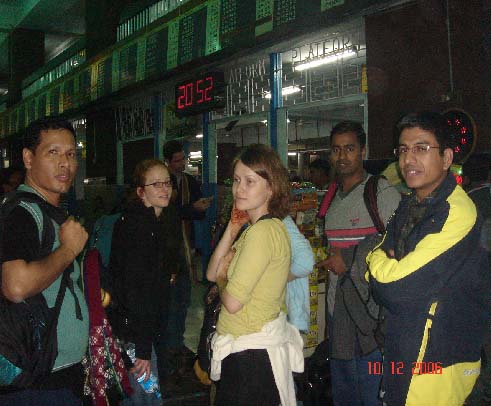
Course participants at Sealdah Railway Station on way to field visit
Tibetan Refugee Self Help Centre
The
more we care for the happiness of others,
The
greater our own sense of well-being becomes,
Cultivating
a close, warm-hearted feeling for others automatically puts the minds at
ease.
This
helps remove whatever fears or
Insecurities
we may have and gives us
The
strength to cope with any obstacles
We
encounter.
It is the ultimate source of life.
The next day participants went to visit the Tibetan
Refugees Self Help Centre. The Centre was born on October 2, 1959 with
four people. The Tibetans deem this place momentous not only from a
practical point of view but also from an emblematic point of view since
the 13th Dalai Lama spent two years of his exile in this place.
The Centre was registered as a charitable organisation under the Indian
Law and the donations it receives are exempt from income tax.
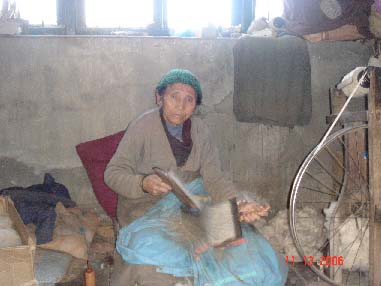
Tibetan refugee at work in Darjeeling
The eye-catching feature of the centre that attracts
the visitors is the handicraft goods beautifully designed and presented by
the resident refugees. These goods are being exported to 36 countries
around the world to represent Tibetan culture. Training programmes are
also part of the centre as to promote traditional Tibetan handicrafts
around the globe. A promising future for the Tibetans refugee youth is
ahead as the day care centre along with nursery, established in 1960, is
providing care and education to the kids.
The day care centre allows
mothers to concentrate and produce the best out of their hard work.
Another prominent feature is a medical wing of 20 beds with extended
medical services such as X-ray, ultrasound and pathological laboratory
etc. in town. The mobile medical clinic helps not only the residents of
the center but also used in organising medical camps for poor people of
the area. The center also has its printing press in town with modern
techniques to print news bulletins and other publications related to
refugees.
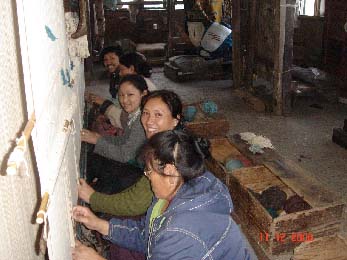
Tibetan refugee women at work in the Self Help-Centre
The group had a round of the
different sections of the centre along with the manager. Here they had a
chance to take a closure look at the manufacturing of the handicrafts such
as carpet weaving, woolen clothing, wool spinning, tailoring, knitting and
painting, carpentry etc.
The
winter course participants were also told that there were around 650
residents in the center in the year 2001. But presently there are only 350
residents (150 families). Those who left the center went abroad in search
of jobs, where some of them are well settled.
This was the second visit to the Centre by participants
of the course, as in the Third Course also in 2005 the participants had
visited Darjeeling, visited the Centre and had learnt a lot.
The Tibetans Self Help Center has not only provided the
opportunity to this refugee group to settle down but also helped to build
its sense of self worth, confidence and courage to face the challenges of
the society and the state. They are in the hope to return to their roots.
The center’s sale counter facilitated the participants to buy the
handicrafts to make their visit memorable.
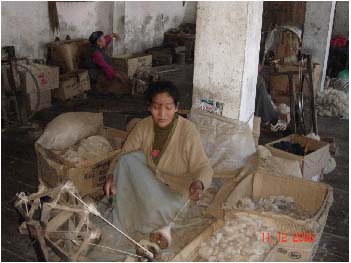
At the Tibetan Refugee Self-Help Centre
Another settlement in Sonara was
supposed to be visited by the winter course group but due to short span of
time it could not be done. It was briefed to the group that the settlement
had a monastery and a hostel. The refugees residing in this place are
associated with agriculture.
The
field trip provided an opportunity to the group to see the realities of
Tibetan refugee life in exile, where they have been living for decades. It
was felt by the participants that this field trip would help to enrich
their research and practical experiences.
The
fourth winter course included two public events – a public lecture by
Ranabir Samaddar, the Director of CRG, and panel discussion on Settled states and Unsettled Populations: Evolving discourses on Social
Justice in India in Loreto
College, Darjeeling on 11 December and a public lecture by Hans-Joachim
Heintze, University of Rurh, Bochum on Legal
Regimes of Protection for the Victims of Forced Migration on 13
December at Jadavpur University, Kolkata.
Settled
States and Unsettled Populations: Evolving Discourses on Social Justice in
India
Panel: Subhas Ranjan Chakraborty, Ranabir Samaddar, A.S.
Rai, Fr. George Thadathil
Professor Ranabir Samaddar opened
his speech by drawing attention to the geographical location of Darjeeling
on the border of West Bengal, where the upper caste southern Bengali
culture ends and another culture begins. In the eyes of the Bengali
people, this is a region of migrants but why do we so often think in terms
of settled identities? In today’s world, one of the primary forms of
demanding justice is based on political identity, as was the case, for
example, in the Indian struggle for independence. Identity, in turn, is
defined in terms of settled borders. Indeed, settled politics begins with
settled borders. Historically this has not always been the case and there
are many cases of trans-border existence.
Borders do not only exist on the
periphery of states, borders are also lines that have a life of their own.
Sometimes people obey rules of immigration and at times they neglect them.
Borders also have a tendency to divide people as life centers around
borders but at the same time life on the borders do not respect the
border. One of the greatest injustices in the past two centuries has been
the injustice done to people who did not respect borders and thought they
could live a trans-border life. This injustice was done by means of
boundary making, state demarcations and partitions. Defining borders began
with the Roman Empire now marking 2000 years of leading our lives this
way. Border is one of the fundamental conditions regulating the
institution of state, whereby non-citizens do not enjoy the same rights.
We still do not know what trans-border citizenship means. Citizenship
began with the declaration and assumption of political rights and
socio-economic rights for chosen some but is this enough? What about the
aliens, the non-citizens? The border still regulates these principles, so
what about substantive citizenship rights? We must rethink the institution
of borders. Another question characteristic of globalisation is about the
moving populations, the undocumented and uncountable mass of individuals,
moving outside and within national borders.
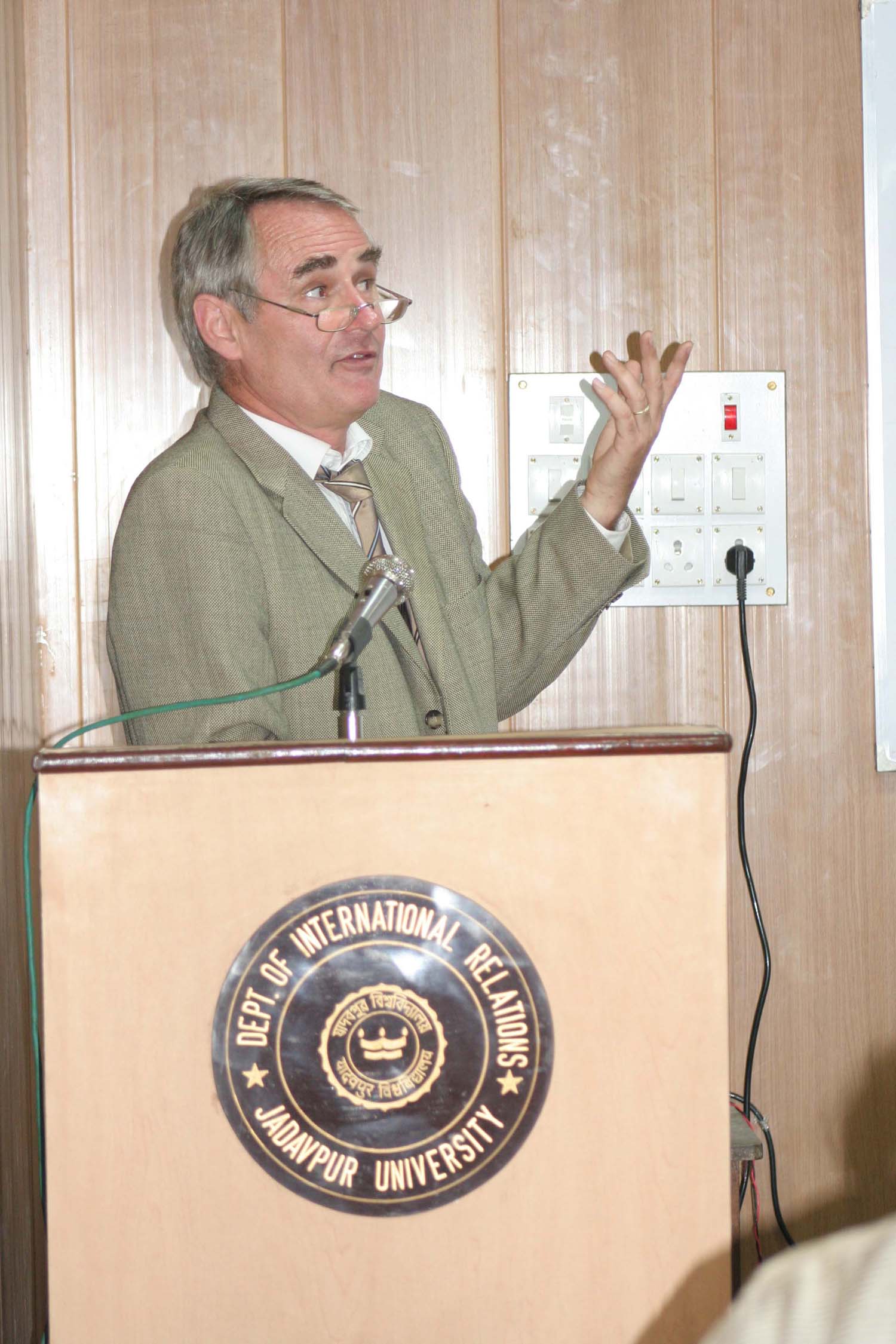
Hans-Joachim Heintze
speaking at
Jadavpur University
How do we retain
the sanctity of the border today? Land is once again one of the most
important factors in politics. Land is a source of contentious politics.
This brings us back to the classic question of politics – how do we deal
with the question of land, on which large proportion of the population
depends?
Father George Thadathil began his
speech by placing himself within the Rawlsian distinction between justice
and ethics and subtitling his talk as “ethics and ethnicity or unsettled
populations within apparently settled states”.
He was speaking of the people of Darjeeling. Ethics is the need for
fair treatment of others, premised on correct self-understanding. A
philosophical starting point is the primacy of ethical over the
ontological, which is exactly the opposite approach compared to Western
philosophy. Reason cannot unveil everything about being. Are our
perceptions born within the group or outside the group? Philosophy needs
to be rooted in ethics. However, ethics worldwide has taken a backseat due
to globalisation. For example, dalits are not yet in the mainstream of
political life. We are living in a situation where we fought to attain a
degree of justice.
Racial, ethnic, social,
demographic and linguistic differences prevent assimilation process. There
was perception of neglect in Darjeeling followed by the emergence of
ethnic identity. Whereas imperialism gave space to dalits, sixty years of
independence did not achieve what Indian constitution recommended to
achieve within ten years. There also exists a local discourse on justice
in Darjeeling. Local leaders call it counter violence – “if the state
did not use violence, we would not have either”. Another dimension worth
mentioning is the notion of the self i.e. defining oneself as anti other,
“I am not you”. I am capable of defining myself not only against you
but also along with you. I am also the other.
Social
justice is an attribute we should possess in terms of treatment of groups
and individuals. The stress should be put on benefits of social justice;
however there hasto be the burden of responsibility needed. One’s
involvement in social justice should be based on practices and principles
– the two must be compatible i.e. just.
Legal
regimes of protection for the victims of forced migration
Professor Hans-Joachim Heintze, University of Rurh, Bochum
Hans-Joachim Heintze’s lecture
took place at Jadavpur University. He addressed the subject of legal
regimes of protection for the victims of forced migration on the basis of
examples taken from the former Yugoslavia. Heintze was speaking on the
basis of personal experience as he had worked in Sarajevo, the capital of
Bosnia-Herzegovina. The question of whether return is a right or a duty in
the case of Yugoslavian refugees was raised at the outset of the lecture,
which then attempted to address the question from different perspectives.
Even though the state of
Yugoslavia was first established after the First World War, the forging of
a common Yugoslav identity failed to materialise alongside the process of
state formation. The
multinational state of Yugoslavia ceased to exist in 1991, when
deteriorating inter-ethnic relations led to a full-blown armed conflict
and eventually ethnic cleansing. The ICRC and UNHCR were both involved in
relief operations in the region. Bosnia-Herzegovina provides a good
example of ethnic cleansing, whereby conscious attempts have been made by
the governments to create homogenous citizenry. As a result, out of 4.4
million inhabitants of
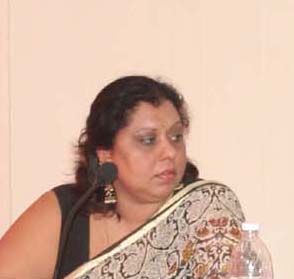
Panel discussion on women's access to citizenship in India
Bosnia-Herzegovina 1.5 million people became internally displaced and 700.000 were forced to move abroad. These people were invited by the German government to come to Germany and were granted the right to work. However, their legal status in Germany was unclear as they were first granted half-a-year residence permits, which were later renewed on short-term temporary basis.
The Dayton Agreement of 1995
specified that these people residing in Germany would now be obliged to
return to their former places of residence. The so-called peace courts
were established to ensure the end of the ethnic cleansing, thus people
were obliged to return. Thus international law was not applied in this
case.
The war in Yugoslavia is a terrible fact for the whole
of Europe because it revealed a glaring failure on behalf of Europe to end
the war. This was a failure not only of the European collective effort but
also of the international community as a whole. The question Heintze
raised at the end was: Is our aim only to provide effective humanitarian
assistance to the victims of the conflict or should we make efforts to
stop this sort of massive violence?
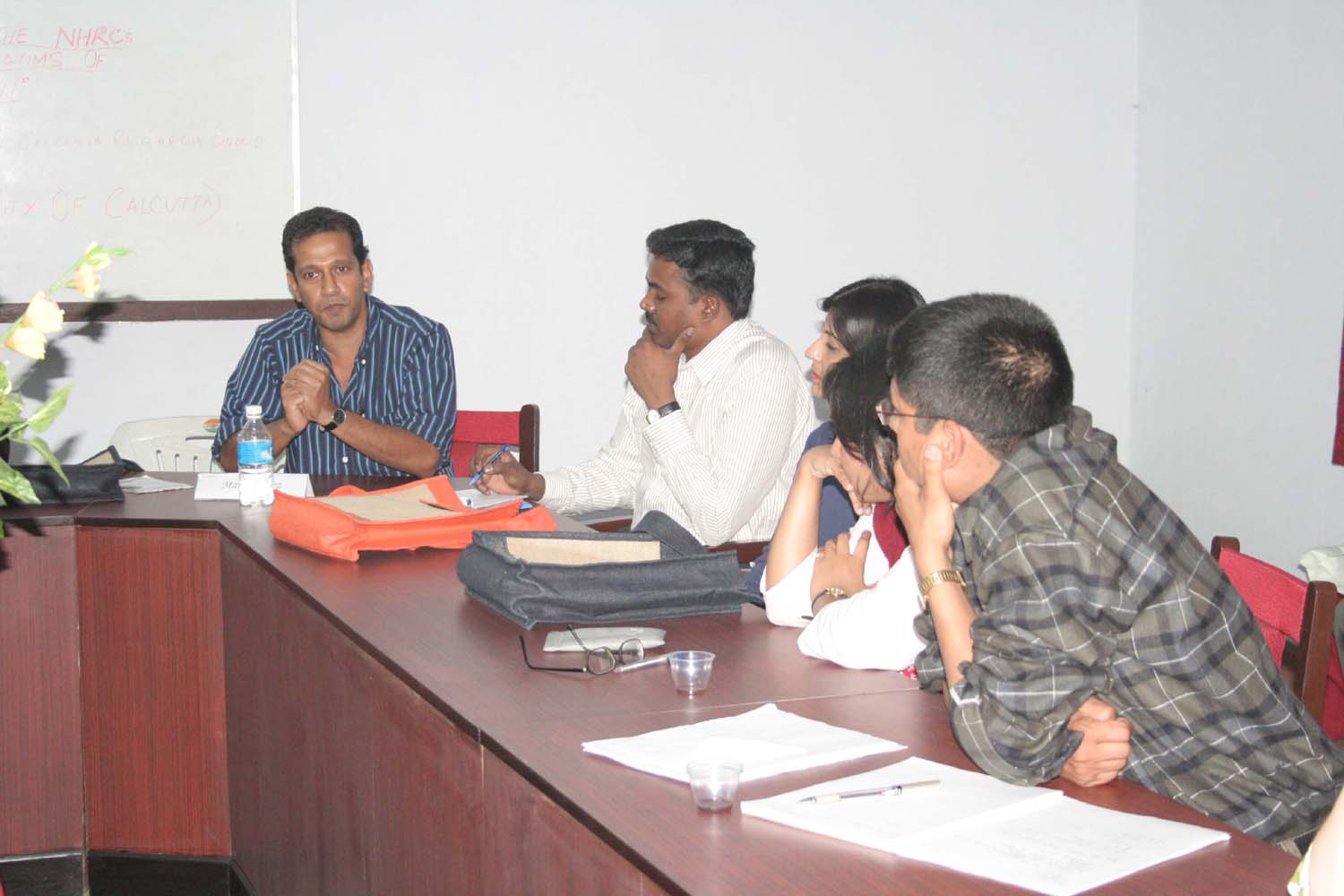
Mario Gomez and Parivelan in an interactive session
The CRG winter course is special is because it has a number of interactive sessions in the form of round tables and panel discussions. This year each compulsory module had at least one interactive session. Some modules had more than one interactive session such as module B. Participants for these sessions included administrators, members of institutions that deal with issues of refugees and IDPs such as the UNHCR and the National Human Rights Commission, human rights activists, refugee activists, creative writers, legal analysts and refugees and IDPs who have had experiences of living in camps.
Most of these
sessions were public sessions. The themes of the sessions were:
1.
Women's
Access to Citizenship in India-Twenty Years After Shah Bano (2
December )
2.
Is the Right to Return a Symbolic Right? (3
December)
3.
How
Effective is the NHRC in Protecting the Victims of Forced Migration?
(6 December )
4. Resource, Gender, and Forced Migration (7 December)
5. Forced Displacement in North East India (8 December)
6. Is the Palestinian Experience a Unique Experience in Refugee Annals? (13 December)
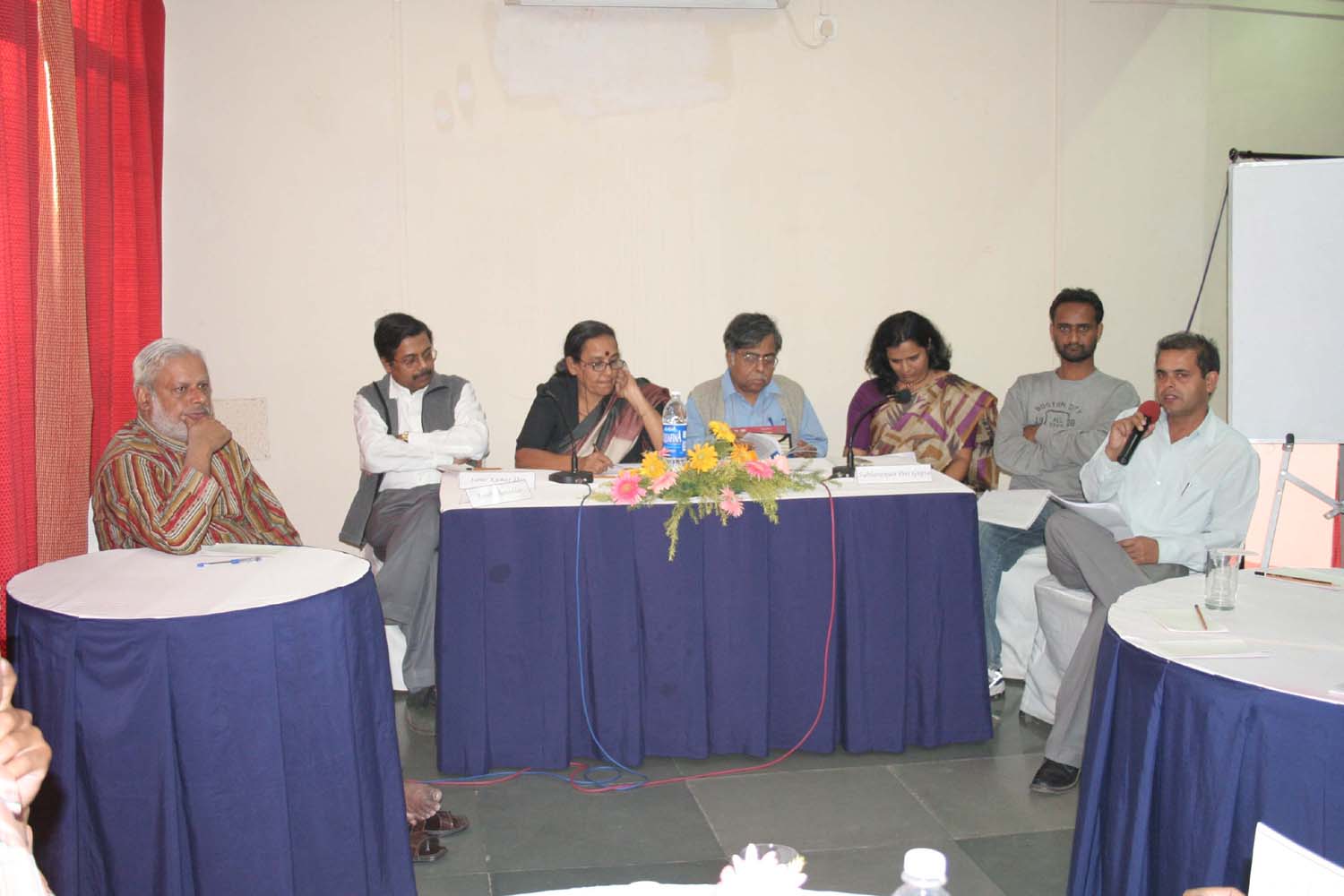
The interactive session on the Right to Return
7.
Humanitarian
Institutions and their Task of Care
(14 December )
Women’s Access to Citizenship in India – Twenty Years after Shah
Bano
The discussion began
with the panelists attempting to answer the central question, why is
citizenship so important for women? Women are both the ‘other’ and the
citizens of a nation. There are different rules for women. Shah Bano is a
Muslim woman who fought for her alimony rights for over 14 years in the
Supreme Court. Yet when she got that right the state stepped in and
negated that. Their allies
were the patriarchal community leaders. In fact community leaders have
more voice than women in women’s affairs. Social justice does not apply
to the internal workings of the family unit. Female welfare was considered
synonymous to family welfare. Multiculturalism creates new complexities
and women become minorities within minorities. Why put women’s rights
against community rights? Why can’t they go hand in hand?
There are also many cultural barriers that obstruct women’s
access to citizenship rights? The Shah Bano case, the Bhanwari Devi case
and the Alinagar killings all portray the patriarchal attitude that
inhibits the discourse on women’s rights.
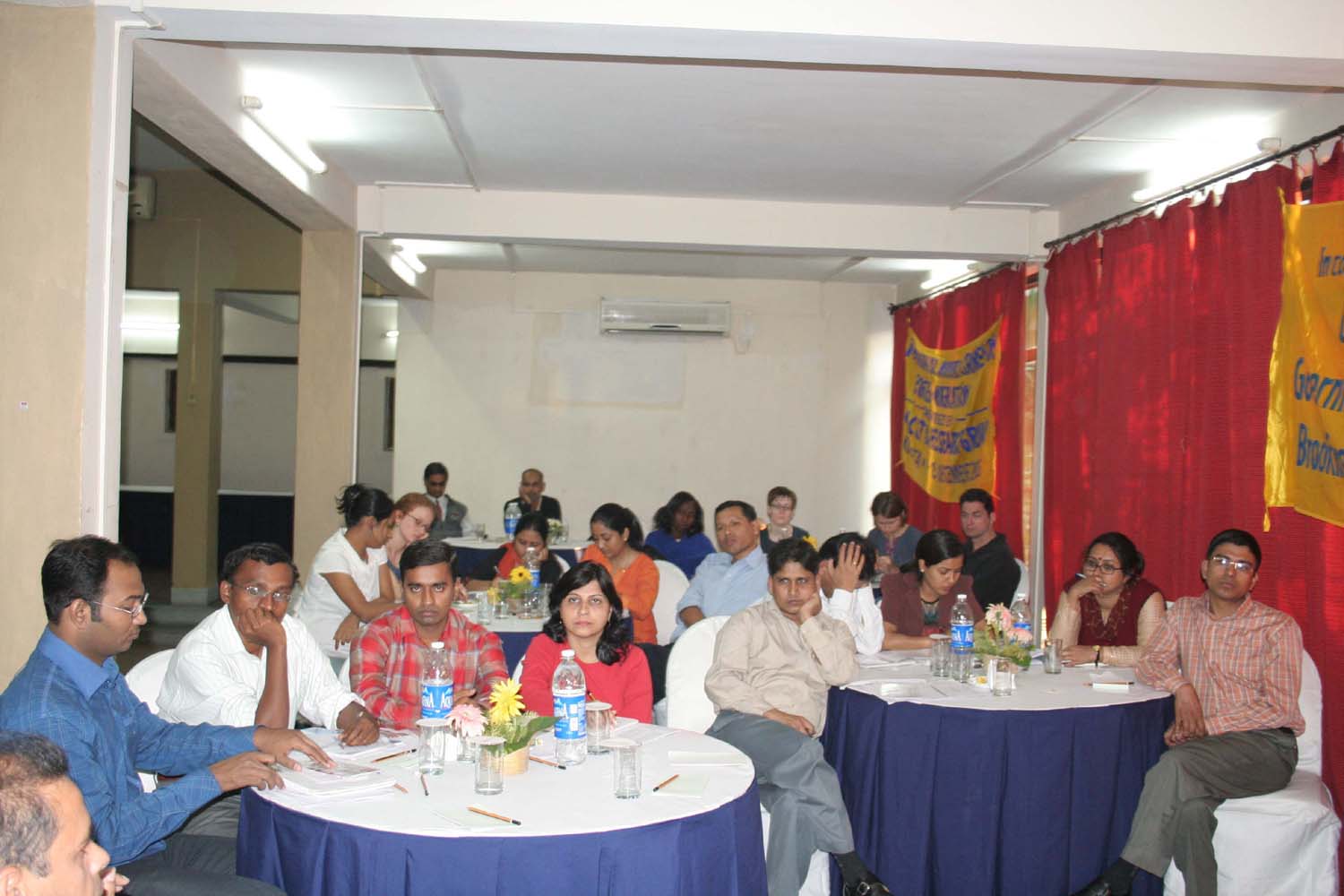
Course participants listening to alecture
The media representation of the question of women’s rights is also
skewed. The media always
takes the more sensational path and often sacrifices justice in the
process. What right do the
media have to put a rape victims’ face on the television when law
prohibits it? Sometimes the media puts women demanding her rights on
trial. Is it fair to have a trail by media? The panelists agreed that
today the collective responsibility lies with the media, the courts, and
all of us if we want women to access her rights of citizenship and make
this a more just world.
Is Right to Return Merely Symbolic?
The Right to Return
is central to any refugee movement. The
Refugee Convention of 1951 recognizes it. It does not mean taking the
refugee back to the border and pushing them back rather it is a recognition
of the right of a refugee to go back to her country with honour. In Bhutan,
many people from the South were deprived of their citizenship and then
thrown out. The notification came out in Junkha in the national newspaper of
Bhutan. Today most of these people are in UNHCR run camps in Nepal. The
essential question of return of Bhutanese refugees is a very difficult one
as they have hardly any access to citizenship.
International law has clear provisions on origin and succession of states
but no clear guideline on how states can be partitioned if they are. When a
group of policy makers or decision makers decide to partition a
state/population then who is to bear the consequence of the decision? Thus
international law is much behind international development. When we
partition territory do we ask what we are partitioning? How do we thus
ensure that people who do not want their land to be partitioned get a chance
to return or is such a dream mere hallucination.
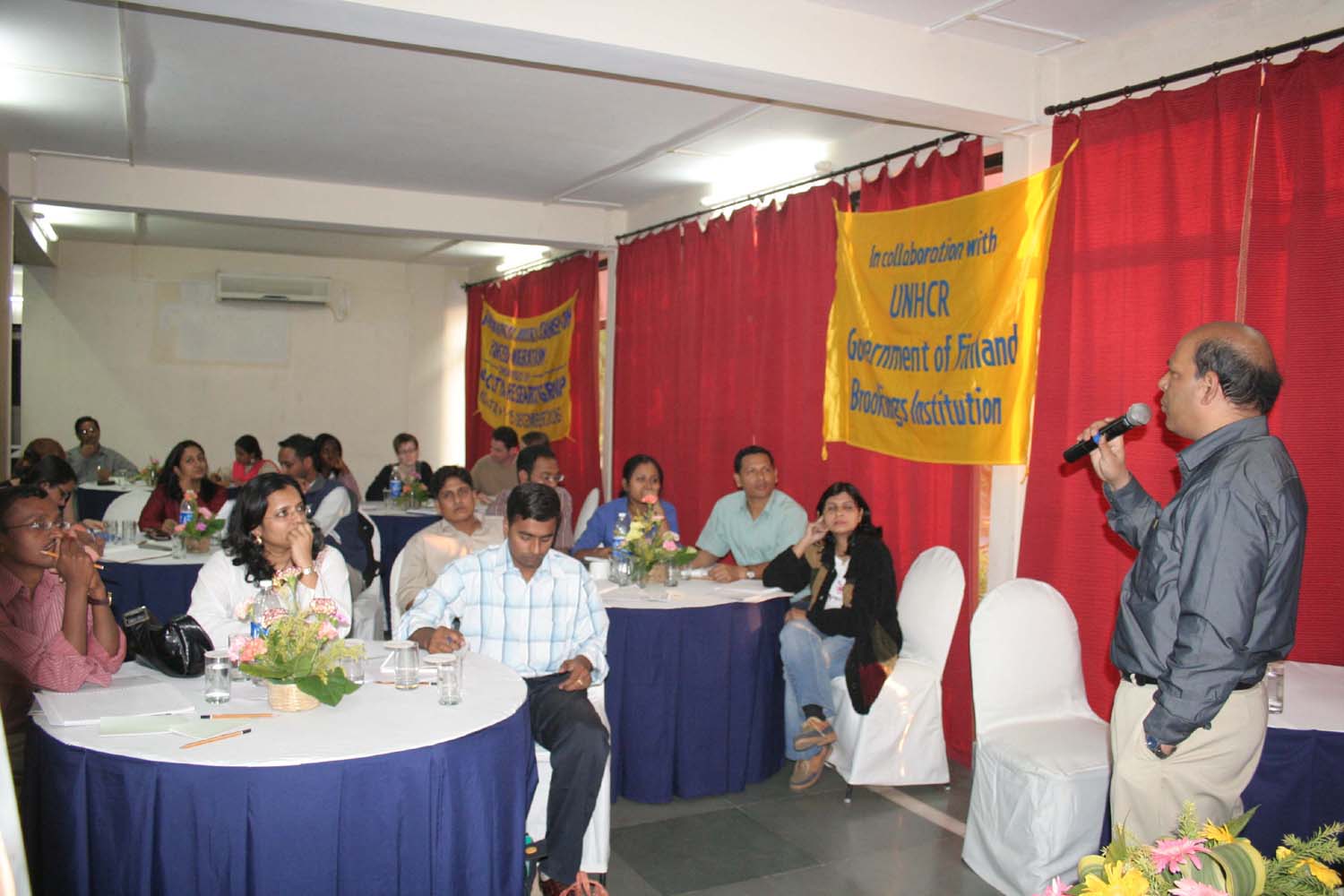
A number of
questions emerge tied to the existential condition of refugees and in
reality the Right to Return was found to be flouted in most situations. The
stateless Biharis of Bangladesh are still hanging in mid-air. This right is
honoured in paper but much flouted in practice. Neither Nehru nor Liaqat Ali
kept the promises that they made in the Nehru-Liaqat Ali Pact. Thus saying
that refugees have a right to return becomes more a tongue in cheek reply.
It may be considered as sacrosanct as any right included in our constitution
but are often violated in practice.
The Right to Return
can be seen from three angles: legal, political and emotional. It has its
legal basis in UDHR, the International Covenant on Elimination of All Forms
of Racial Discrimination and ICCPR. The political angle to the Right to
Return can be seen in the example of the Bangladeshi Muslims in Mumbai. The
Shiv Sena in Mumbai welcomes Hindus but not Muslims as it says that they had
already laid claim to their own religious state i.e. Pakistan. The emotional
appeal of ‘Vibhajan Asweekar’ (Partition Not Accepted) lies at the base
of the emotional desire to return to one’s place of birth wherein borders
become hurdles. Perhaps all countries together should ensure visa relaxation
rules.
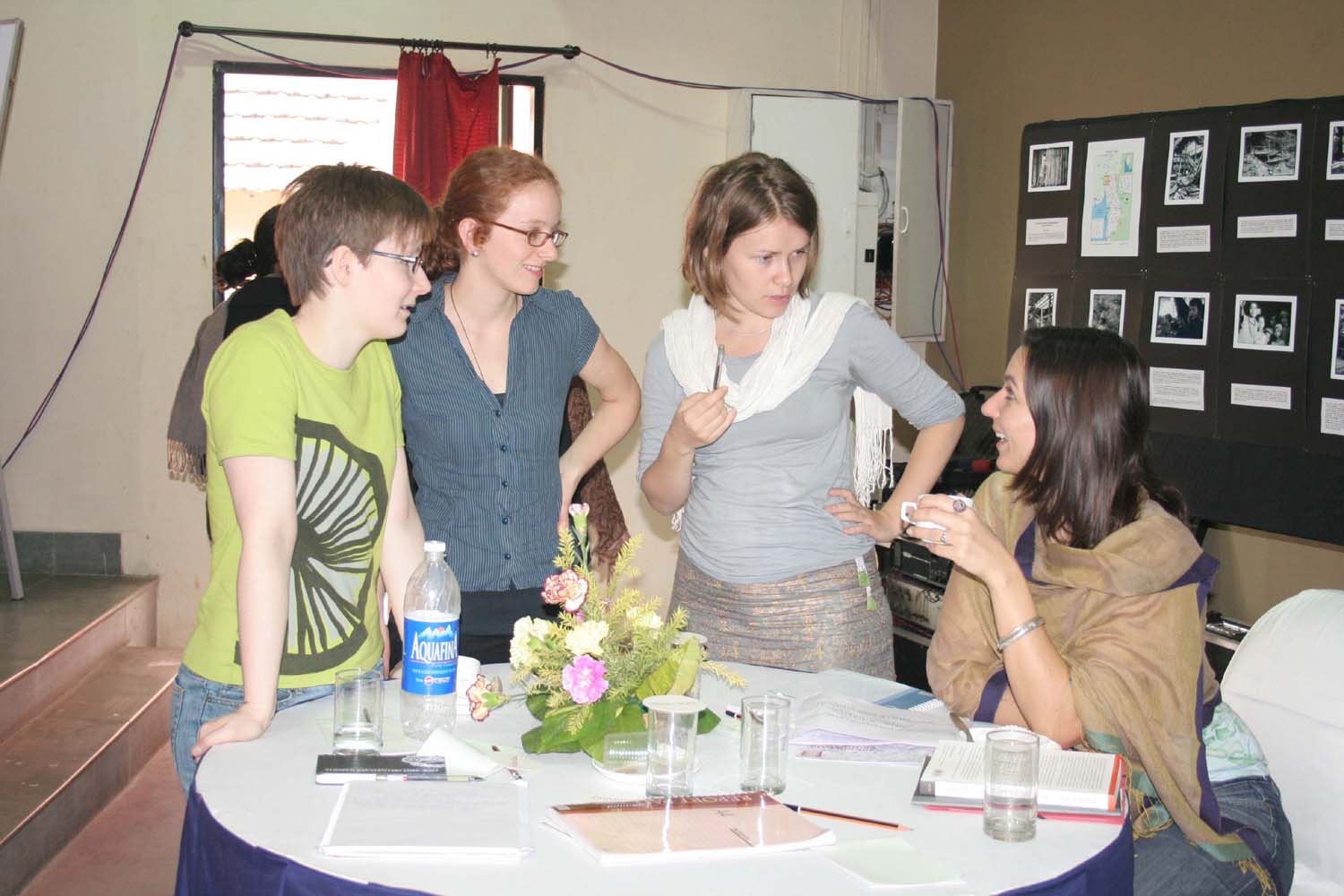
For refugees, the most important right is the right to return. Has providing a legal framework for them solved any problem? Partitions have created histories and memories of killing, destruction and displacement. Then in the post-colonial era, the trappings of sovereignty have given rise to nation-states and visa regimes. We should focus on the rights aspect of this Right to Return than on the legal aspect. Partition refuges have a right to return, provided states left long back are able to transcend and go beyond the logic of partition. It requires a radical reimagining of the body politic and the ethical collectives in which minorities do not fall prey to majoritarian democracies. There is no one way to such re-imagination that can make good the democratic deficit. Once this is done across states, the right to return is unlikely to be claimed and it becomes redundant. When every side of the border is appropriately re-imagined and is considered as 'right’ it does not matter whether one lives in India or in Pakistan or in Bangladesh and that is the way how borders lose their significance.
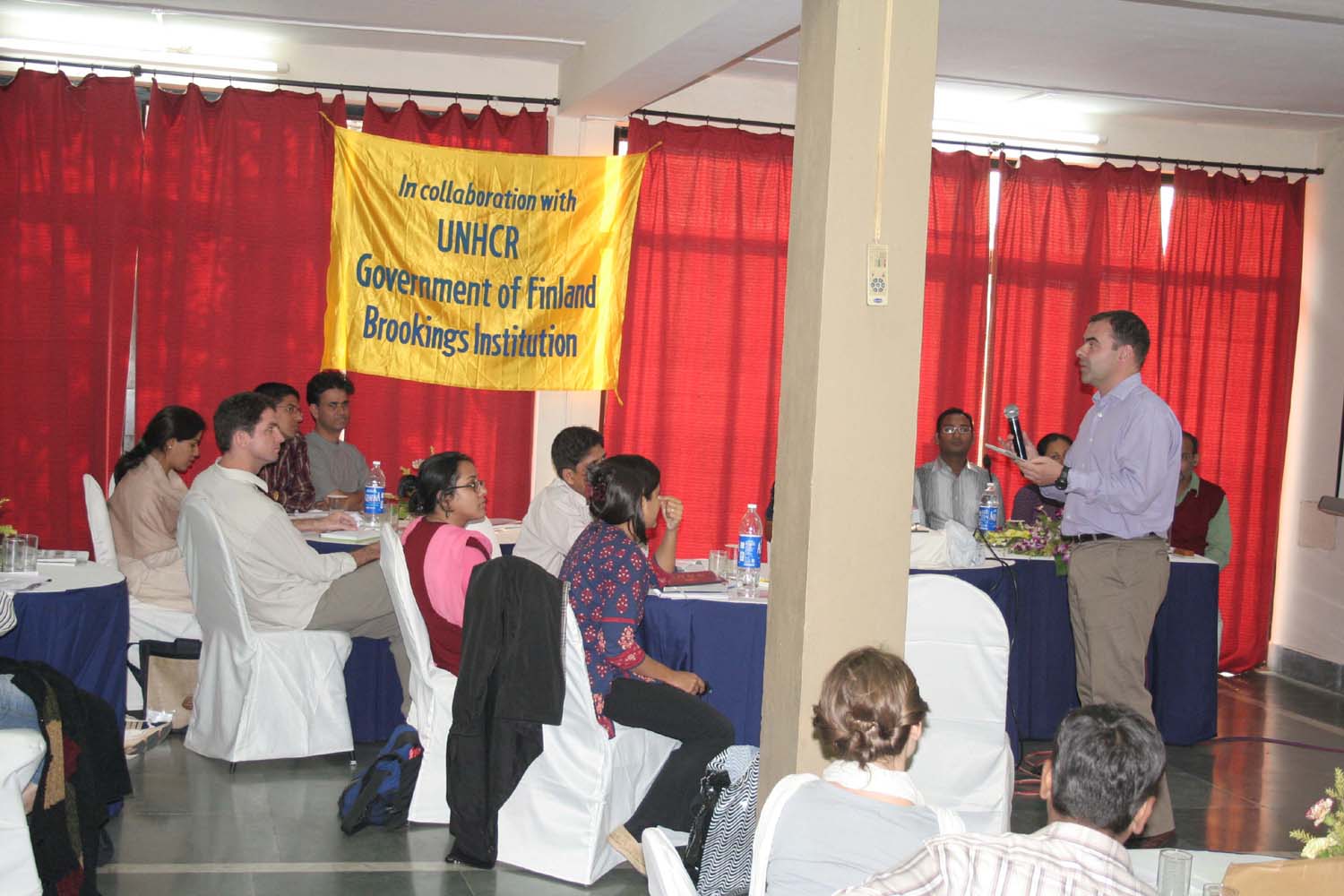
How Effective is the NHRC in Protecting the Victims of Forced Migration?
The panelists highlighted role of national human rights
commission with illustrations from IDPs situation in India and Nepal.
Various initiatives taken by NHRC of Nepal under Human Rights accord 2004
were mentioned; lists of causes of displacement in Nepal and its impact on
Neplai society and economy were mentioned. Finally various challenges which
include lack of national legislation difficulties in identifying the IDP’s
human rights violation and lack of implementing mechanism, political
instability with lack of political will and lack of humanitarian assistance
were mentioned.
The representatives
of NHRC India tried to identify the problem of refugee and IDPs. They gave
three categories of forced migration- refugees, IDPs and the trafficked
(especially women and children). They spoke about various aspects of human
rights violation by stating few case studies. They spoke about the role of
NHRC in protection and promotion of the rights of the above mentioned
categories of people. Regarding the legal station of NHRC it was said that
as NHRC is not a substitute of judiciary and it does not qualify as court.
But it enjoys the power of civil court. The nature of the function of the
NHRC is investigation and recommendations can be made. They presented a note
on formation and composition of NHRC in India under the 1993 act. They
mentioned that the success of the commission could be judged on the fact
that the member of the complaints went up from initial 400 to 75,000
complaints in the recent past. All most in all the cases the state and the
central governments have accepted the recommendation of the NHRC. They spoke
about the various aspects of autonomous character of the commission and
finally gave some successful cases handled by NHRC such as for slum dwellers
in Delhi, displacement due to developmental project at Bastar district,
Dalit resettlement in Haryana, Chakma in Tripura, ethnic conflict and
displacement at Karbi Anglong etc.
Mario Gomez spoke
about the situation 1987 since when there has been a growth in human rights
institutions, which are gaining increasing credence with the international
community. Human rights institutions have the potential to engage in various
activities. He gave the example of the NHRC in south Philippines and said
that they had a series of workshop on displacement whose objective was to
arrive at a national policy. Interestingly the Philippines government does
not use the word IDP but ‘evacuees’. The Sri Lankan NHRC has taken a
study to look at the equity issue of Tsunami victims. All displaced people
should have access to fair process at the minimum. The panelists agreed that
NHRC should be pro people and not pro state.
Resource, Violence and
Displacement
At the outset the
chair of the discussion defined resources as the conditions that nature has
given to us which can be used for one’s own survival including cultural
survival, which are non-replenishable and hence perishable. Resource crisis
occurs when there is loss of ownership or control over resources or change
in resource use pattern. The questions posed to the panelists were 1) Do you
think that new economic policies since 1990’s prepared the way for
transfer of people’s resources to private and corporate sectors? 2) Does
marginality of the people expose them to the resource crisis or does the
resources crisis contribute to their marginalization? 3) How does denial of
access to resources become potential source of conflict between indigenous
and non-indigenous people? 4) Do you think that changes in resource use
pattern also trigger off conflicts or violence?
In Nepal many have
been displaced because of roads, airport construction, hydroelectric
projects and creation of national parks. Development projects have created
problems for victims. Even those who have got compensation have had to
endure hardships, which has increased the problem of marginalized people.
Problems arise because of inbuilt hierarchy and because political elite is
acquisitive and unwilling to share. One should learn from the indigenous as
they can best tell us how to use resources.
The 1980’s oil
crisis led to liberalization of economies and new senders such as the World
Bank today not only giva money but also dictate the direction of state
economies. The New Economic Policies have taken resources away from people
by diverting the resources the market where they become commodities to be
bought and sold by those with purchasing power. The Singur problem in West
Bengal is indicative of changes in resource use pattern. But how do we
justify violence and displacement? The Sardar Sarovar Project shows that
50,000 adivasis have to pay so that others may get irrigation. It is because
they are marginalized that they cannot access people’s rights? They do not
get a fair share back.
In Bangladesh the Right to Information is important. When people are not
consulted the scope for their displacement increases. Jhum cultivation has
decreased the fertility of land and caused resource crisis. It is the
marginality of the people that exposes them to the resource crisis. The
panel farther deliberated whether we should then not question the very
paradigm of development that is being followed?
Forced Displacement in North East India
In the context of the widespread displacement in Northeast India, the
issue of access to justice by the indigenous people has assumed crucial
importance. In Bangladesh the plight of the indigenous people in the
Chittagong Hill Tracts has shown the significance of the criticality of the
right of access to justice in the context of displacement.
Development-induced displacement first began in the CHT with the Kaptai Dam,
which had serious impact in NE India. In the Northeast the influx of
migrants from neighbouring states has led to increase in population and
competition among groups for resources and jobs. Besides the prolonged
insurgency problem and the absence of any government policy with regard to
the IDPs, there is no accurate data also on the IDPs. Displacement has been
caused by natural disasters also, such as erosion by river Brahmaputra and
its tributaries.
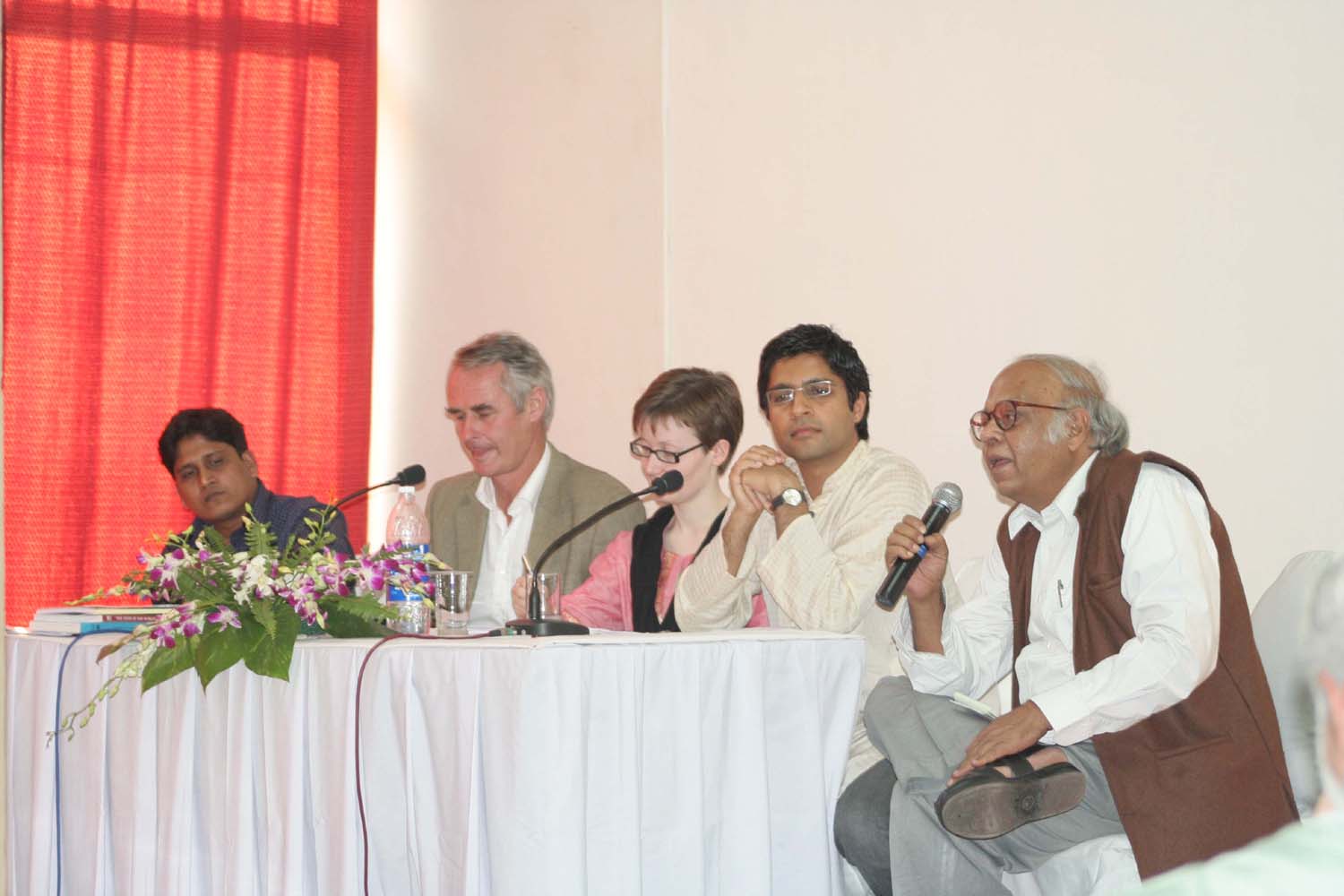
One should also take
note of the ethnicity-induced displacement in places like Karbi Anglong in
Assam. The ethnic conflict between Dimasa and Karbi communities has claimed
more than 80 lives, burnt around 50 villages and rendered 60,000 innocents
homeless and displaced. The worst affected are women and children and most
of the displaced are taking shelter in local administration sponsored 57
relief camps in and around Diphu, Manja, Dhansiri and Nagaon district.
The multiplicity and the plurality that comprises the ‘Assamese’
identity has been challenged by such ethnic groups conflict.
There can be two methods - structural and operational - of dealing
with such situations. In NE India, opposition to immigration is grounded in
the numbers game. The politics of demography is ingrained in a democracy and
it shouldn’t be seen as just xenophobia. Thus, the problem of in the NE is
one of democratic deficit.
The Burmese Chin
state bordering Mizoram has ethnic minorities that have been suppressed by
the military regime. In the
resultant insurgency, CNF has been fighting the central regime. As
militarization increases so does human rights violation like forced
migration and forced labor. Villagers from 10 different villages cleared Six
hundred acres of forest in one week. Religious festivals also got disrupted
as a result of the draconian rule of the junta. The knee jerk reaction of
the government to the problem of insurgency in Assam has also been
criticised. Instead of deploying the armed forces, the state should have
addressed the grievances of the people regarding the influx of population
from neighboring Bangladesh. At the same time the people should remember
that nationhood is not always a viable concept. In a country with a colonial
history any attempt to build projects of “people-hood” on the basis of
colonial categorization can have dubious results - agreed most of the
panelists.
Is the Palestinian Experience a Unique Experience in Refugee
Annals?
This session explored
the uniqueness of the Palestinian refugee situation. The speakers accepted
that the Palestinian refugee displacement was a massive and over helping
experience- one for which no solution has been found. It should be
considered seriously because it is a humanitarian issue, and international
agencies should draw attention on it.
The question is an
odd and a difficult one to answer simply because of the exalted status it
holds. Just as the Jewish case is seen as a template, the Palestine case is
also seen as a defacto case to look at when setting any terms of reference
for refugee groups.
The status of Palestinian refugees is very special and from the
international law point of view to appreciate its uniqueness one has to see
into its history. In the future the Palestinian refugees are entitled to
earn statehood but the question of right to return remains. It is a problem
whose solution can be attained only after long negotiations. There were
comments that though their return is a distant dream one should keep in mind
that Jerusalem became significant because of its significance with Judaism.
Besides do we have any other instances of an entire refugee community
nurturing a political resistance movement for fifty years? Some may compare
it to the Tibetan, but the Tibetan government in exile is nothing but a
shadowy presence between India and China. Edward Said had said that the
unique characteristic of the Palestinian refugees is that they have for long
seem themselves as tragic victims and this has given different form to their
distinct culture of the general mood of gloom. There is also an added sense
of helplessness as there is nothing to enforce an international law. One
should also not forget the role that imperialism has played in this whole
area.
Humanitarian Institutions and their Task of Care
The panel was asked
to address three questions. 1) What is their idea about humanitarian
institutions and their task of care? 2) Are they really caring? 3) Question
of Interrelation and interface of the rights approach and the humanitarian
approach? The entire refugee movement is predicated on two approaches. The
humanitarian approach sees refugees as people in humanitarian need of
protection. Joya Chatterjees’ paper on Rights of Charity had argued that
the government had treated refugees in a manner as though refugees were in
need of charity when refugees instead wanted to claim it as a right. We need
to go back to history and see how the Geneva Convention and the 1951
Convention were framed. Humanitarian institutions are established to give
protection and care to war-affected people, as war victims are deemed
innocent. Care means food, relief, temporary shelter and a sense of
belonging. It was also felt that we would need to review the lives of these
victims in post conflict situations.
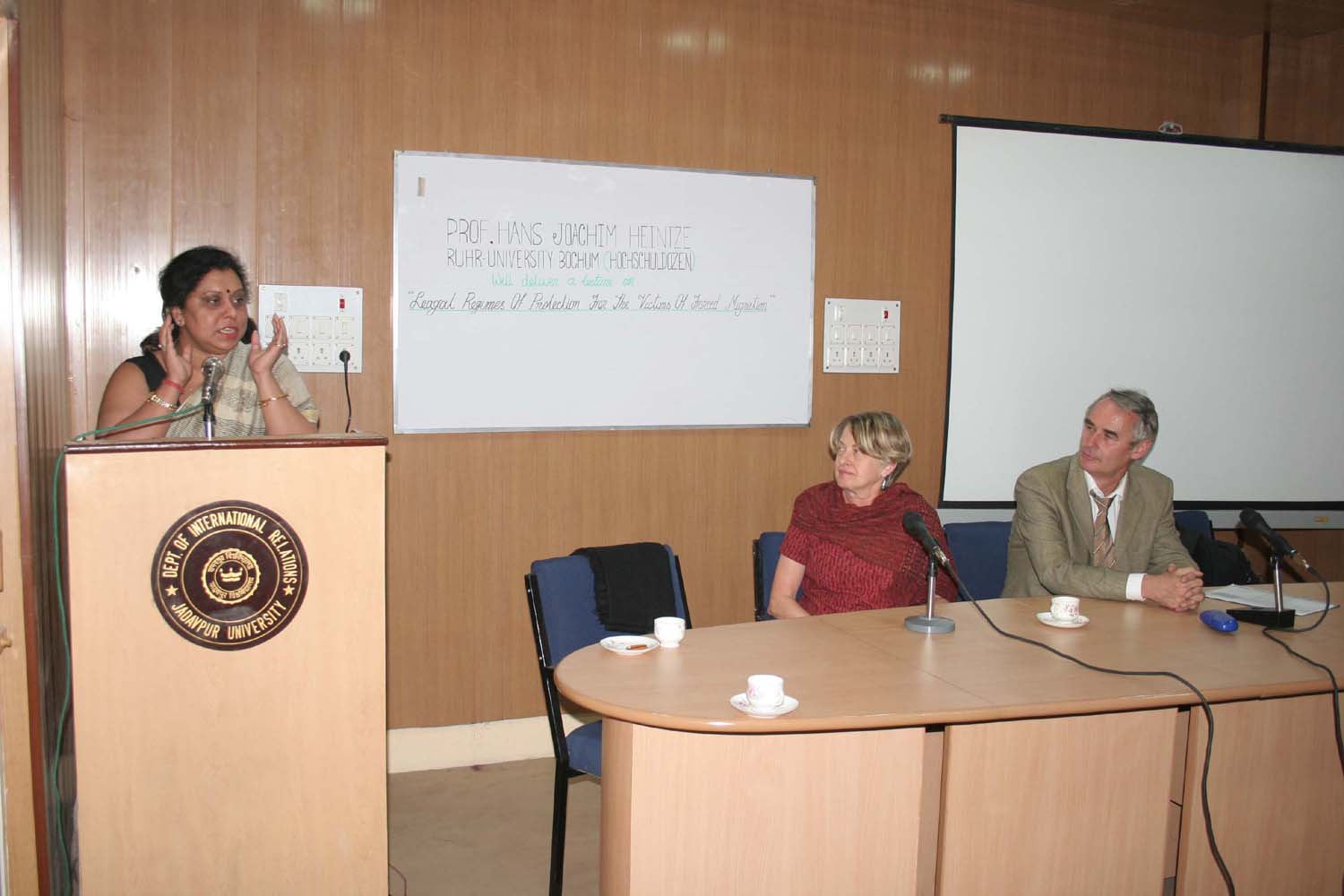
In Sri Lanka the
Tsunami victims got more importance than war-affected victims and latter
group of victims is today dissatisfied because of this discrimination. Thus
is reality there is gradation of vulnerabilities. Human Rights Institutions
have to try to help the vulnerable people to exercise their right to live
with dignity. The Bhutanese refugee camps in Nepal are one of the best
self-run in the world, which shows how effective human rights institutions
can be in small countries with less resource.
The issue that needs
to be addressed is that whether they are addressing the human rights of the
people or the needs of the people? In other words, what do need – a
rights-based approach or a need based approach? One should note also that
the Guiding Principles on the IDPs are explicitly based on the needs-based
approach and one should ask if that is an appropriate path. Who defines who
needs what? International agencies and states have proven to be quite
futile. When we call it charity we introduce the notion of power. Refugees
do not need charity but the “right to have rights”. The problem lies in
the structure on which modern nation state and UN system has been built. Is
there any modular form of humanitarian action?
Often, the problem is that the Human Right Institution take a top down
approach and force their will on the people. They need to adopt a bottom up
approach. They are not caring! Financial resources are spent on the wrong
priorities. It becomes a number game and politics of pity.
On 8 December, the participants had the opportunity to
see and discuss “Tales of the Night Fairies” with the film
director Sohini Ghosh.
The
film viewing was preceded by a discussion on what is a documentary. There
were several types of answers including: documentary is political,
sensitising, insightful, a vision, a view, a critique, a form of art, a
probe, an evaluation, a fiction, a message and a reflection. The director
went on to explain the hardship involved in making such a documentary or any
motion picture. Before the show the director declared that the movie has
been made for ‘feminists’ by a ‘feminist’. The film concentrates and
revolves around the struggles in the life of the sex workers in Kolkata.
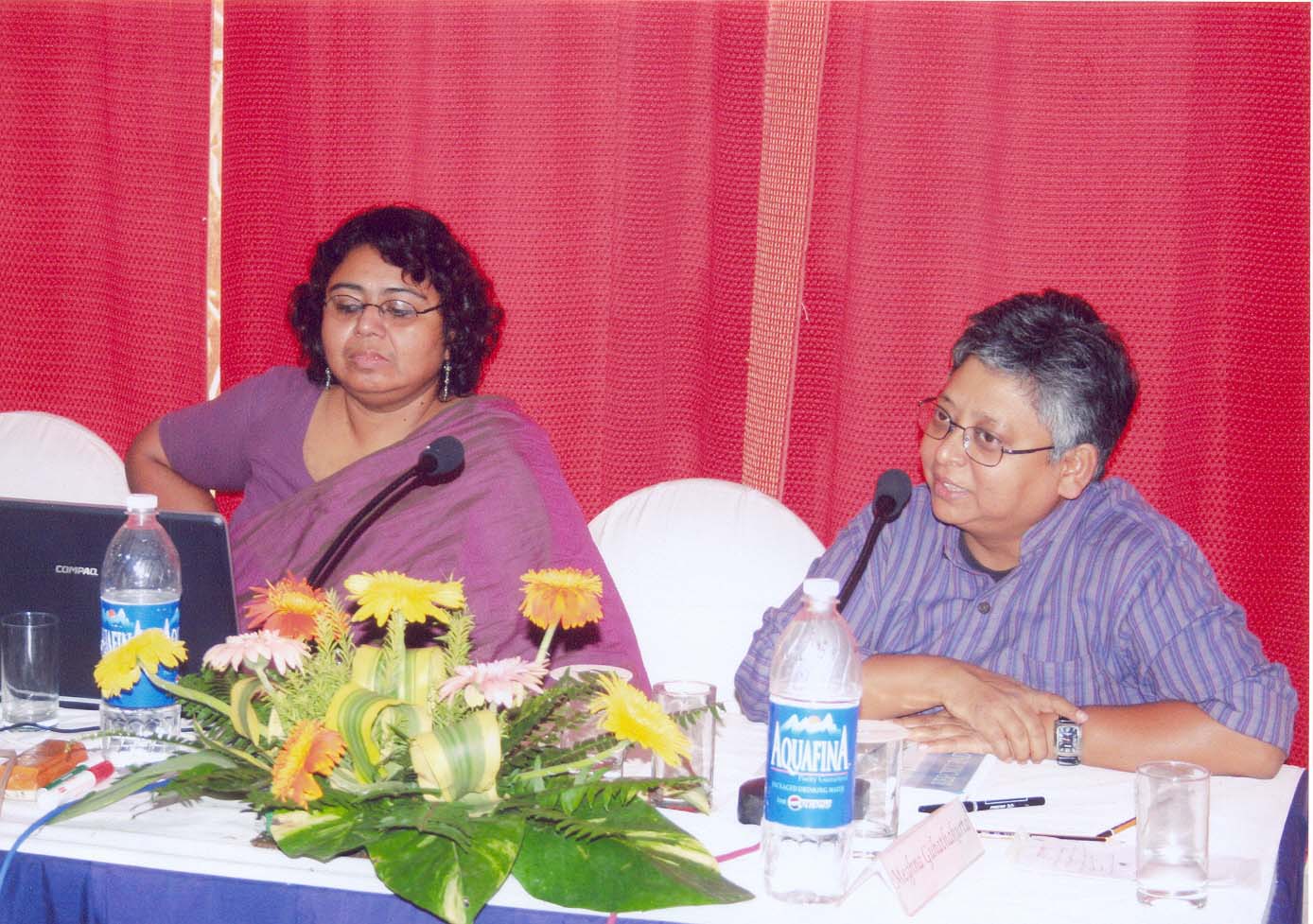
Meghna Guhathakurata and the film director Sohini Ghosh
The director said at the outset that the reason behind
her making the film lay in her own life. The middle class family background
and the sense in which they used the term “decent people” had its own
significance. The film begins with entering the lanes where sex workers live
and work. Shikha Das, a sex worker, explains how an organisation called DMSC
was formed in 1995. Deepti Pal, another sex worker emphasized that DMSC was
a big boost to them allowing them to work with dignity. She felt that now
she did not pander to masculine desires of entertainment.
According to the sex workers the biggest achievement in
forming the organisation, DMSC, was the normalisation of their lives. The
sex workers were hitherto forced to be in between the four walls,
entertaining the men clients, but they could not express their real feelings
of being with other people like anyone else. The dream of coming out in
public and celebrating their existence became a reality when they organised
a programme called ‘Sex workers millennium carnival’ in 2001. The
festival had several problems before it was allowed to take place. There
were men who felt that the moral values of the society would depreciate. But
the best part of the whole event was the participation of the non-sex
workers who wholeheartedly enjoyed the programme and even signed the
signature campaign. Eventually the organisation was successful in getting
the permission from the governmental authority to occupy the space that was
once denied to them. The film also went on to discuss the issue of safe sex.
One sex worker spoke about the empowerment of the women and the “dignity
of labour” that they felt in themselves. She felt so empowered that now
she was able to come out of the clutches of the fear and disclose her
identity as a sex worker, or the daughter of a sex worker. She wanted her
daughter also not to be scared.
Women had different stories to tell as to the
circumstances behind their becoming sex workers. They cited the history
where they even collected waste on the streets. Another lady shared her
experience of being brutalized by a policeman; she went on to say how she
took revenge on the policeman by using the situation, which came in her way
when they had an organisation. All of them felt that they should be
empowered and educated so that they could face and fight back any type of
atrocity. They felt that they were no more scared of the society. They felt
that work had to be seen as work. They even questioned, why should the
society feel their work to be bad? If it is bad then why did men visit them?
When the government of West Bengal proposed
rehabilitation for sex workers, sex workers, part of DMSC, wanted to accept
it and asked the government to give rehabilitation to those who were in real
need and not to the ones who had work. They wanted the government to give
rehabilitation to the women who could not work. The film ended with a
conversation with a sex worker who got a chance to go to Mexico to represent
the sex workers of Kolkata. That portrayed the long way she had come.
The
session ended with a question and answer session, where Sohini Ghosh was
asked several questions pertaining to the making of the film and the
implications of the film for the society. The director was asked whether she
had shown the movie to the sex workers and whether selling of one’s body
was a civilised thing to do in a civilized era. The director answered that
every human being sells his or her self in one or the other way and the sex
workers were selling theirs in their own ways.
She also accepted the fact that on the grounds of sexuality all the
sex workers might not be divided but they too were divided on communal,
caste and class lines.
Inaugural Session
The
inaugural session was held on 1 December 2006 at Hotel Sojourn, marking the
beginning of an intense 15-day familiarization of participants with the
lives of the refugees, the displaced and the vulnerable people, making an
attempt to understand the politics behind their displacement, the issue of
their survival and conduct investigations into the multi dimensional and
multi layered issues involved in the study of these groups.
The
programme began with the inaugural session where the introductory remarks
were given by the Director of CRG, Dr. Ranabir Samaddar who initiated the
participants from diverse backgrounds to the realities of the victims of
forced migration in South Asia. Warmly welcoming all to the fourth
consecutive and abundantly successful Winter Course he set the ball rolling
with a brief overview of the content of the course.
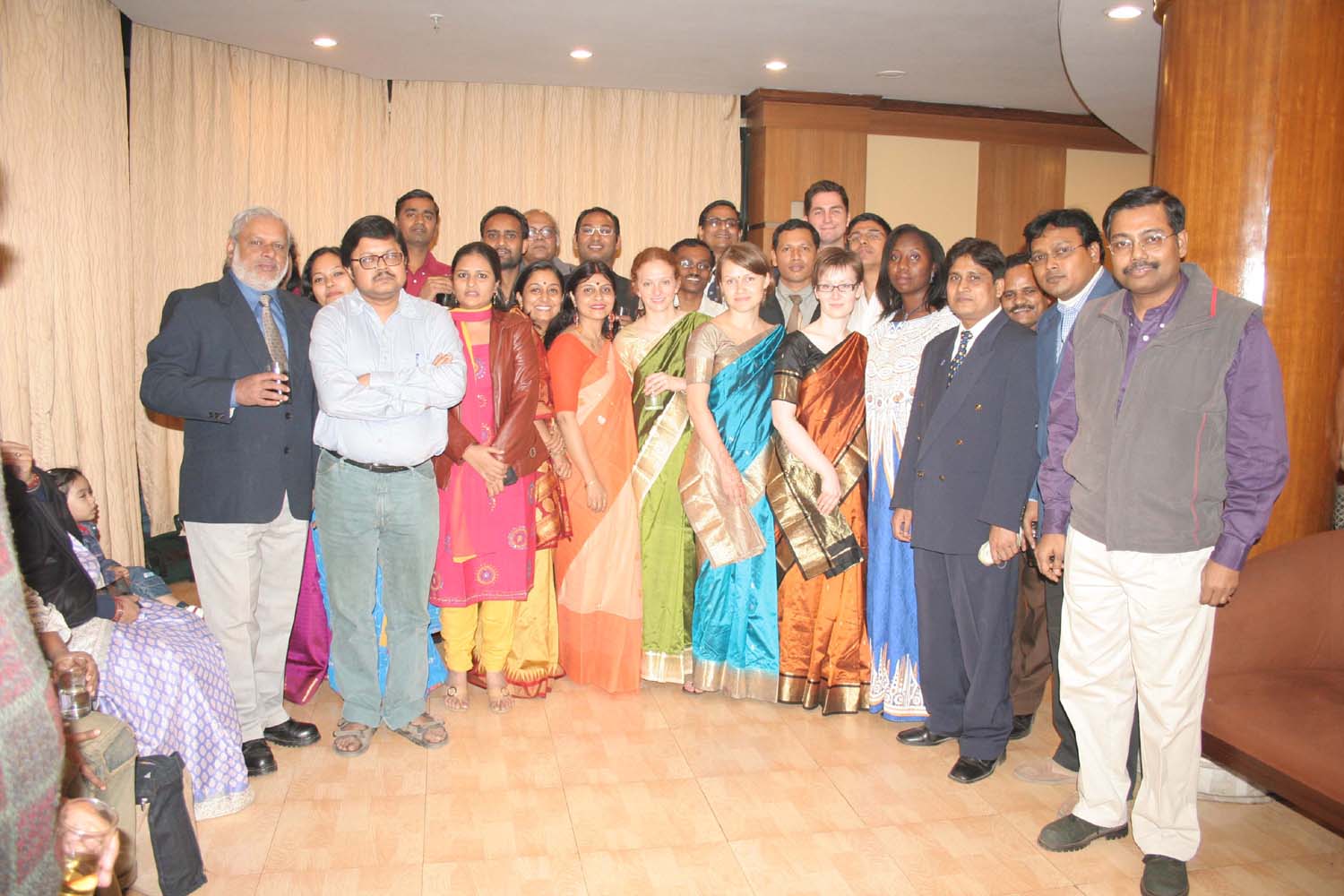
Course participants together with faculty members
The inaugural lecture was given by Flavia Agnes, the noted legal activist who is very well known both as a lawyer and a women’s rights activist. She grippingly recounted her experience of fighting a legal battle for the cause of the bar girls in Mumbai, many of whom were trafficked women from Bangladesh. She was full of remorse that her battle proved to have an adverse effect on the most marginalized victims rather than help them as these bar girls were caught in a vicious circle that had inadvertently linked them to the question of terrorism and illegal imagination. They were denied of their livelihood on the pretext of “National Interest”. She ended by posing certain hard questions about the marginalized section of the society.
Why the civil society approached?
(The full text of the lecture is available in the forthcoming issue of Refugee Watch - 29)
The Valedictory session was held
on 15 December 2006 at Hotel Sojourn. The president of CRG, Professor Subhas
Ranjan Chakraborty, delivered the Welcome address. He welcomed guests and
participants of 4th winter course and gave the floor to Dr Paula Banerjee,
who read out a message from the Embassy of Finland and the Brookings
Institution.
Dr
Ranabir Samaddar made certain remarks on the final occasion of the course.
He spoke about the nature of today’s forced migration, which is marked by
mixed and massive flows. The problems and experiences of South Asia today
are not unique to South Asia only. It is thanks to migration and migrants
that the concept of borders has been challenged, despite the attempts at
securitization by the great powers. A concept of a new type of woman has
emerged from this, that of a migrant citizen which is a new feature of
humanity. It partly carries traces of citizenship and partly traces of
alienhood (that of being uprooted and displaced). Participants’ were asked
to speak on the course and stay in Kolkata. All those who spoke heartily
thanked and congratulated CRG for such an enlightening and well-organized
course.
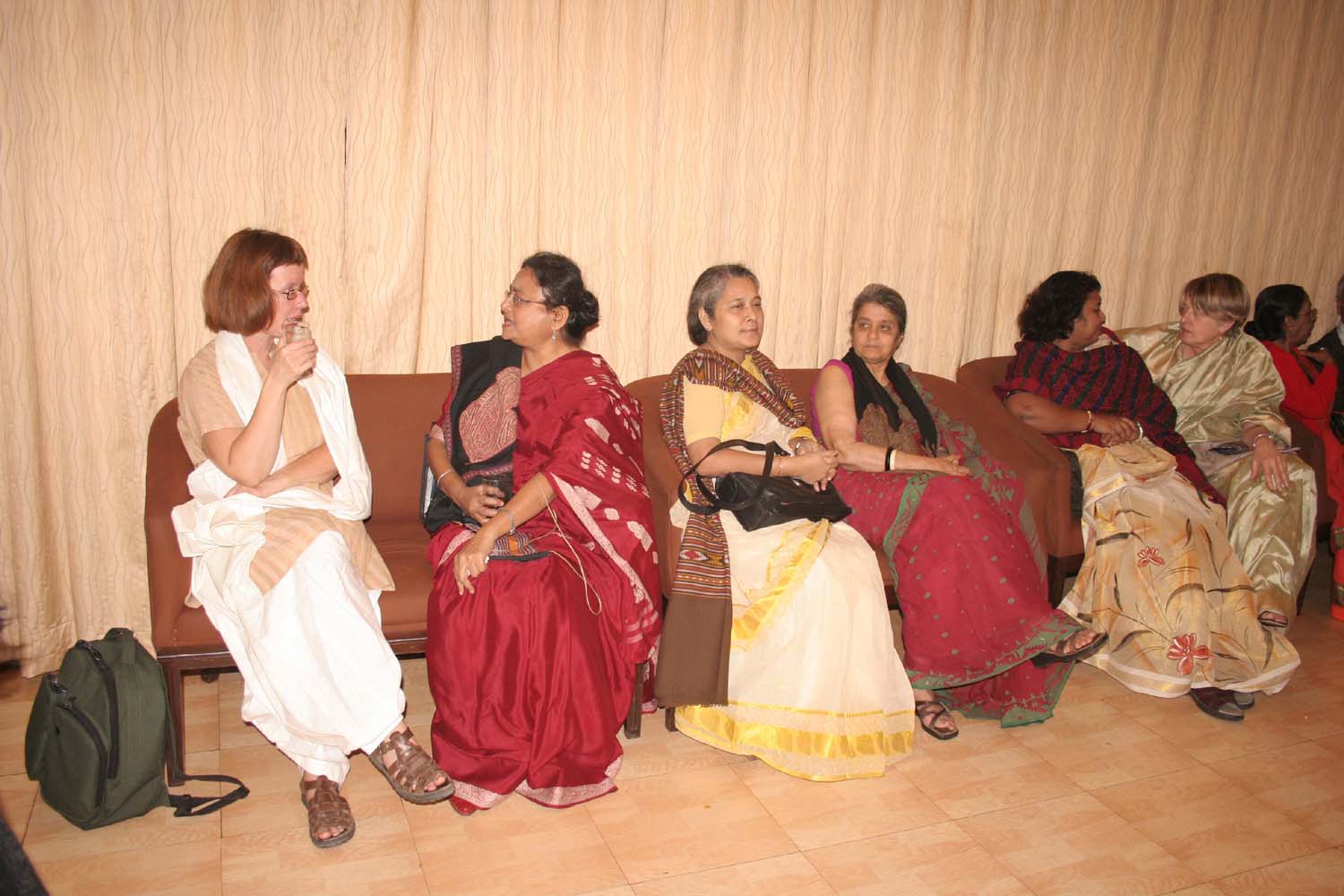
Faculty members interact prior to the Valedictory Session
Tarja Väyrynen also spoke on this occasion as an independent evaluator. She talked about the direct airline connection between Helsinki-Delhi, which was established in 2006. Lots of Indians work for Nokia. Nokia is investing a lot in India. There is now a small Indian community in Finland and vice versa. However, it is the case of mostly business-dominated exchange although learning exchange may be more important. One example of such exchange – is between Tampere University and CRG, based on equal partnership, a true dialogue. So far this has Included exchange of lectures and will now include exchange of students. She said that they were also working very hard to establish a network of scholars interested in South Asian issues. According to her the Winter Course has many strengths, and she highlighted three in particular: the variety of professional and regional backgrounds of the participants, the strong emphasis on gender, and the non-eurocentric approach. She felt that there was future potential for great cooperation in forced migration studies. In conclusion, Professor Väyrynen thanked the organisers and wished the participants good luck in their work.
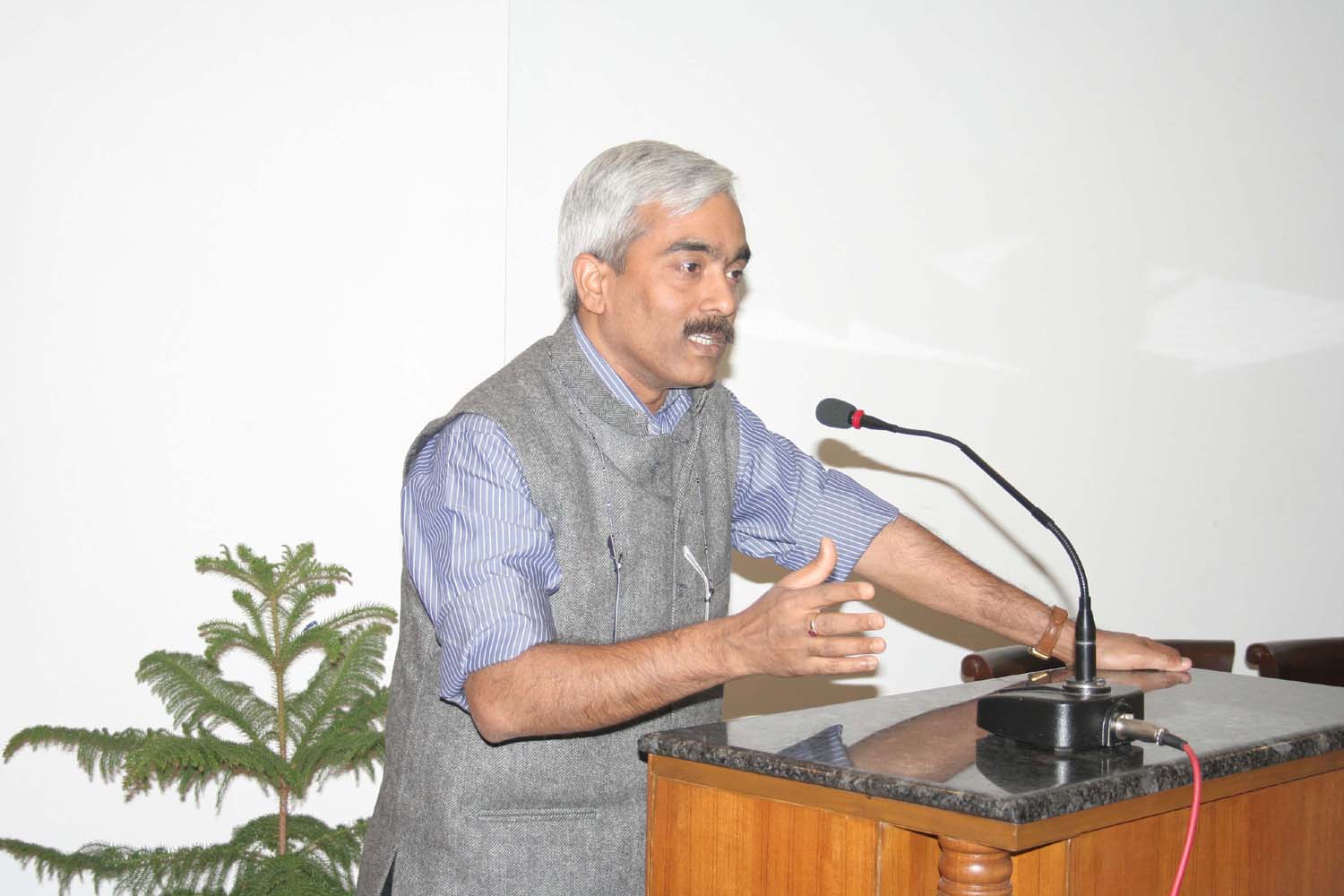
Bishnu Mohapatra addresses the course participants
After
her lecture certificates were awarded to the participants, who spoke briefly
on how they felt highly of the course and their sense of belonging to the
institution called the CRG and its work relating to forced migration.
The
Valedictory lecture was given by Hameeda Hossain from Ain O Shalish
Kendra, Dhaka who spoke on ‘Forced Migration and Trafficking of
Labour – Migrant Women Workers of Bangladesh’. The excerpt of her
lecture is as follows:
Recent debates in international
agencies have sensationalized migration by linking it to trafficking in arms
and drug smuggling and terrorism, and AIDS/HIV. The migrant, whose labour has served to build the wealth of
other countries, has been reduced to being a carrier of crimes and disease.
The use of the word “forced”
is, of course, susceptible to many complex nuances of interpretation that
serve different interests or reflect different perspectives. It is indeed a
contentious issue between countries of origin and destination, and
government responses have been both contradictory and hypocritical. While
countries of origin welcome foreign remittances from workers, they do little
to facilitate their terms and conditions of employment. In receiving
countries, much of the infrastructure development in cities and much of the
service sector owes to the labour of migrants. Dubai or Kuala Lumpur would
not have been architectural show cases without the contribution of
engineers, contractors and workers from South Asian countries.
The concerns of governments are more than regulatory, they seek to
control borders, and to restrict movements across boundaries. Many
governments have been prompted to seal borders, to reinforce border controls
or other restrictions on people’s movements.
Across land borders, the push back techniques have kept people in a
de-nationalised limbo. The more powerful countries such as the US have gone
to the extent of using trade sanctions against the country of origin. At the
same time the US has tempted migration through the sale of lotteries.
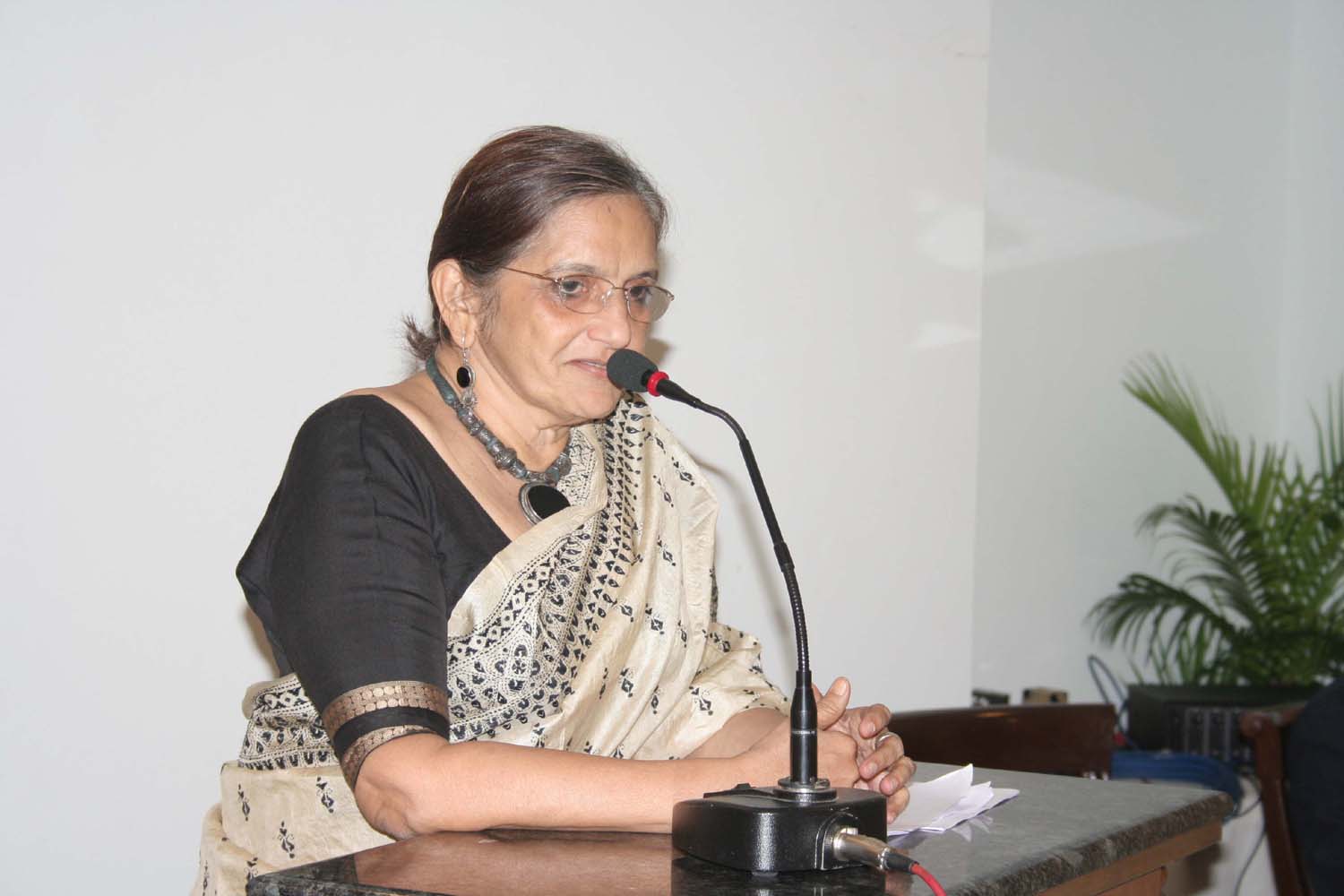
Flavia Agnes delivers the inaugural lecture
On the other hand, for ordinary citizens, freedom of
movement is a choice for survival. Migration
can be forced by political and economic circumstances in the country of
origin, but administrative controls in the country of destination also force
migrants into exploitative relations. People move unwillingly from their own habitats, and may
often be compelled by conflicts and wars, by oppression and violence, by
discrimination and poverty. While migration may be seen as a strategy for
survival by families or an escape route for individuals, or even as
presenting new opportunities, the human rights of migrants and their
security fall at risk from state controls, exploitation of the market and
social exclusion. Women, currently make up about one half of the world’s
current migrant population. It
is only in recent years that a growing
number of women from Bangladesh have taken overseas jobs.
The demand has come mainly from the Middle East. But the conditions
of work have not been particularly salutary and Bangladeshi embassies have
had to cope with many complaints from women workers.
Rather than negotiate on behalf of the workers the government saw
fit, in 1997, to ban the overseas employment of women for domestic work.
This restriction was lifted subsequently, but women’s decisions to work
overseas were subordinated to family approval, etc.
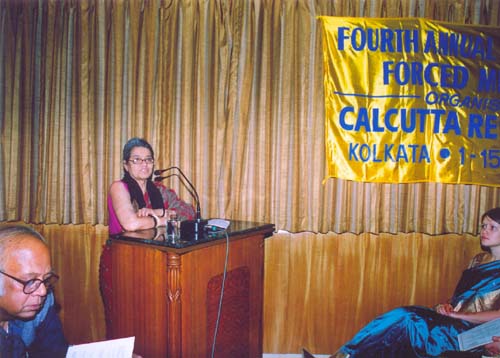
Hameeda Hossain delivers the valedictory lecture
Demand for seasonal labour
provides an incentive for temporary movements. Case studies have documented
how young women and children move across the river from Rajshahi to Maldah
to harvest beetle nuts or wheat in the chars
or marshlands of West Bengal. Their
daily movements are visible to the naked eye, and most of them are not
hindered from working. Their labour is organised by informal agents. When
some of them don’t return home, it is assumed that they were egged on by
promises of work or marriage further west. But the rationale of the market
is not evident to state forces and the policing of borders makes them into
sources of extortion or oppression.
She raised the issue of how far
does international law reach across to support women at the grassroots? The
Adviser on Trafficking from the Office of the High Commissioner on Human
Rights in Geneva underscored the need to acknowledge that trafficking is
both a cause and consequence of the violations of human rights, and that
guiding principles of the Office of the High Commissioner for Human Rights
place protection of human rights at the center of any measures taken to
prevent trafficking. Special care has to be taken to ensure that
anti-trafficking measures do not adversely affect the human rights and
dignity of persons, and in particular the rights of those who have been
trafficked or those who are vulnerable to trafficking. States thus have a
responsibility to act with due diligence to prevent trafficking, investigate
and prosecute trafficking and to assist and protect trafficked persons. It
is clear that grass roots experiences of women have influenced international
awareness of the need to move beyond legal sanctions and legal punishments
towards addressing the root causes that perpetuate gender discrimination,
economic disparities and imbalances in power.
(The full text of the lecture is
available in the forthcoming issue of Refugee Watch - 29)
The programme came to a formal end with a vote of
thanks delivered by the course coordinator, Paula Banerjee who thanked
friends and compatriots, UNHCR, Government of Finland, Brookings
Institution, for helping CRG to organise the course.
She thanked Hameeda Hossain, Flavia Agnes, all the resource persons,
NHRC of India and Nepal, participants, and the government of India for
providing visas to the participants who could make it to the course. She
beckoned civil society activists to gear up, get together, participate and
organise exchanges on rights and justice-based activities. She finally
thanked the CRG team for making the course a success.
The
Course had an inbuilt evaluation system. Participants and faculty members
were asked to fill and submit evaluation forms relating to various aspects
of the course. Some faculty members gave a detailed evaluation too. The
final evaluation was held on 15 December and was chaired by Prof. Ranabir
Samaddar. Dr. Paula Banerjee explained the perspectives of evaluation,
namely providing a platform for study, training, capacity building, and
pooling of resources in displacement studies etc. On the basis of evaluation
notes of the participants and the members of the faculty the following
aspects emerged.
Course
Structure
The overall design and the
guiding idea of the Course were highly appreciated by the participants. They
found it exciting and inspiring, as did the faculty members. Both thought
also the Course to be not only intensive and comprehensive, but also to
possess something quite particular in its wide range of participants and
resource persons and in its non-Euro-centrism.
Reading
Material
Almost all the participants got
the reading material in time. The list of readings sent, combined with the
additional material on the website, was found to be extensive, and capable
of addressing the issue of forced migration from many aspects. The
participants felt strongly that the material would be of use in their future
work or research, and many mentioned that their understanding and knowledge
of the South Asian migration issues has increased considerably by going
through the list of readings.
Assignments
In terms of assignments, only one
participant received the material after completing the first task. They felt
that the material provided helped them in completing the assignments given
to them. Also several suggestions were raised in terms of the assignments.
It was proposed that more time would be devoted to creative assignments,
both their preparation and their presentation, and that comments from the
module tutors would be available also when still working on the first draft
of the paper. Overall, the participants found the creative assignments very
good and inspiring.
New types of tasks were proposed
– some participants felt that it would be good to require a book review on
one item of the reading material, or that the participants could do a
country-specific case study where they would address the issue of forced
migration in their respective countries.
Field
Trip
The field trip was organized for
the participants of the winter course to give them practical experience of
meeting the refugees and interacting with them, which would give a better
understanding of the situation and the life of refugees. The impressions
among participants on the trip were, however, quite divided. All found the
idea as such a very good one, but criticism was directed towards the
exhaustiveness of the trip – although many mentioned that during the trip
the cohesiveness of the group was greatly enhanced – and the short time
that actually was spent in the refugee center. Also participants hoped for
more detailed information with regard to the place they were about to visit,
and hoped that at least one more day could have been spent in the field.
This extra time, the participants felt, could have been used in meeting and
interviewing the Tibetan refugees and preparing individual or group reports
on the trip, and on the methodology of doing fieldwork. Some of the
participants hoped that there would have been trips to the migrant
communities of Kolkata, the city of migrants.
Participatory
Sessions
The participants termed the
participatory sessions as one of the most valuable components of the course.
They found them interesting, intriguing, thought provoking and felt that the
sessions added to their knowledge of the refugee issues. Special compliments
were made on the idea to organize some of the sessions as roundtables, so
that the moderators could give specific questions to all the participants.
This mode of working inspired thinking and conversation. Each session was
seen to add something new to the issue of forced migration, although some
participants felt that the sessions were a bit too long. Also, a few of the
participants hoped that the questions posed during the sessions could be
given beforehand.
Film
Session
The overall opinion was that the
film was very interesting and enjoyable and provided a nice variation from
listening. Especially it was appreciated that the film dealing with sex
workers dealt with the issue in a very interesting manner, which also helped
in understanding the complicatedness of the relation between trafficking and
forced migration, and that they are not necessarily connected. However, some
of the participants felt that the films shown were not relevant in terms of
the course and more explicit linkages between the films and the course
should be made.
Follow
Up
The participants hoped that they
would continue receiving information about the lectures, seminars and
research projects organized by the CRG. They would also like to initiate a
network of the participants, so that the contacts established during the
course could be solidified and maintained in the future.
Core
Strength Areas
1.Course design and planning
2.Diverse backgrounds of the participants
3.Strong emphasis on South Asia and Non
Euro-centrism
4.Excellent resource persons
5.Comprehensive approach to the various aspects
of forced migration
6.Good reading material
Problems
1.E-mail correspondence not always satisfactory
2.Shortness of the fieldtrip
3.More time needed in distance education
4.Easier access to printing and email facilities
required
5.Further discussion on methodology needed
Excerpts
From Evaluators’ Report
Khalid Koser
pointed out the strengths and weaknesses of the course. The strength of the
course were: A committed core staff supported by carefully-selected external
faculty members, a good group of students from a range of backgrounds, a
curriculum that focuses on cutting-edge issues, a well-designed course that
integrates lectures with group work, presentations and a field trip; in 2006
a creative element has also been introduced which allows students to support
their written work in other ways, for example through photography, poetry
and dance. The course is well-integrated with other events for example
public lectures on related issues. The weaknesses he felt were A significant
gap in the curriculum was methodology. There could be a greater focus on
‘transferable skills’ – Some participants presentations were poorly
prepared and presented. He also felt that more contact time should be made
available between students and visiting faculty members in particular – an
office hours system could easily be introduced.
Tarja
Väyrynenmade certain suggestions to make the course even better. Few of her
suggestions were: If the MCRG wanted to experiment with a new module
structure, the new modules could include, for example, Media and
representations of forced migration; Urban development and internally
displaced people; ethnopolitical conflicts and forced migration; and Peace
processes and the question of the right to return. Also the resource persons
could be more fully utilised and there should be a clear structure to do
this (e.g. individual consultation hours). The forthcoming courses as the
present one should draw largely from regional knowledge and experience
rather than have faculty from US or Europe. If a comparative element (e.g.
South Asia/Africa) is brought in, that should be done in a structured
manner. Lastly she felt that some participants should also engage in field
research.
Barbara
Ramusackfelt the schedule for the participants in the programme was rigorous but
diverse in format and effectively paced.
Each day there were either informative presentations by resource
persons that ranged from lectures to videos and documentary films.
Significantly the resource faculty initiated lively discussions of
how we should assess sources of information such as documentary films both
before and after viewing films and power point presentations. The lunches
and dinners provided excellent opportunities for informal exchangers among
the participants, resource persons, and faculty. The Winter Course was the
best organized such event she had attended in India.
Living arrangements were excellent; events started on time except for
a few instances when mechanical difficulties intervened; the organizers
coped when a few faculty and resource people had to cancel at the last
minute and when various bandhs or strikes were in effect during the Course.
Participants’
Evaluation
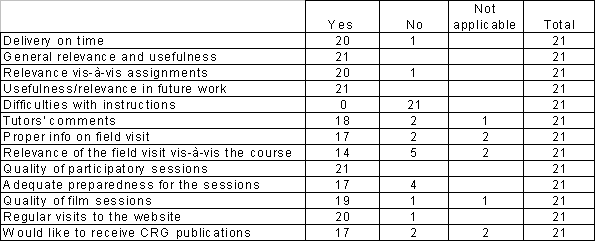

Participants’ Evaluation (charts)
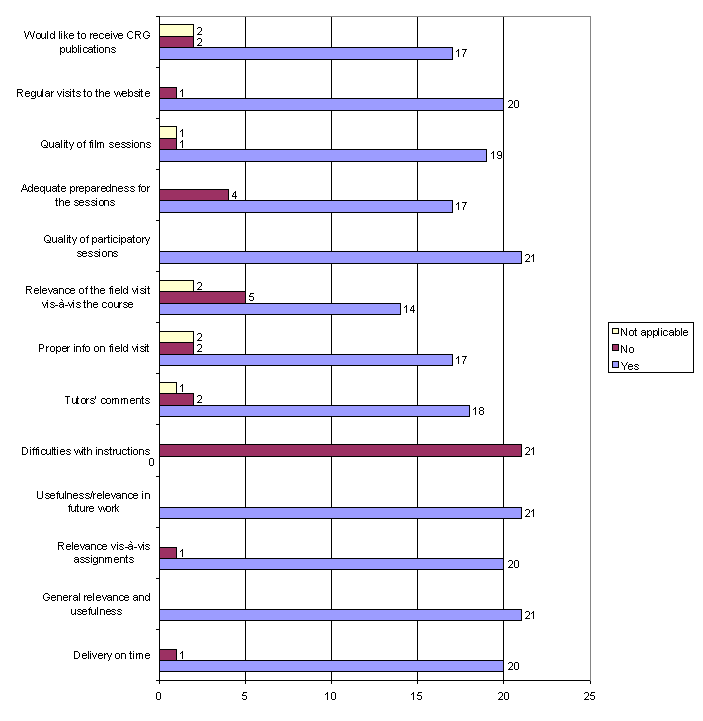
Participants’ Evaluation (percentages)
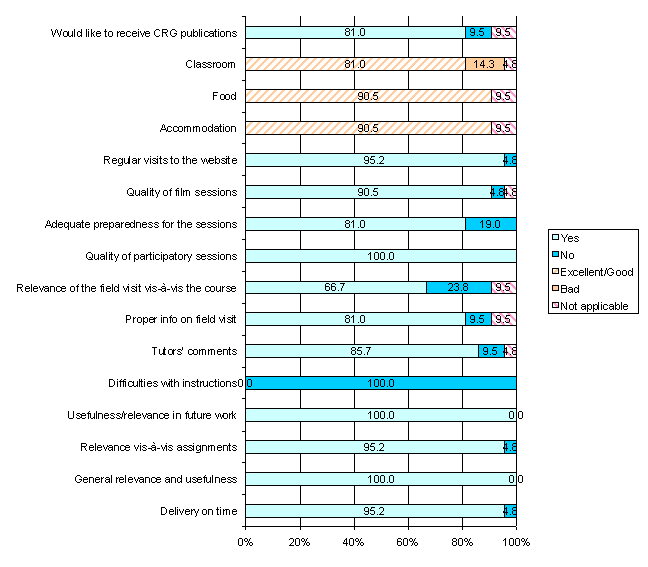
Considering
the growing popularity of the course the advisory committee requested the
CRG organisers to look into the possibilities of organizing short courses in
collaboration with willing centres and departments of Universities in India
as follow-up activity. On the basis of such advice the CRG is now in the
process of designing a number of short courses for different Universities
and research centres. This year
two such short courses were held. The
first was held in Guwahati and it was organised in collaboration with Panos,
South Asia. The second course
was held in Delhi in collaboration with the Jamia Milia Islamia University (JMU).
Collaboration with JMU went a long way to
facilitate the process of sensitising university graduates to the needs of
victims of forced migration.
This
short course was based on following five modules:
1.Human
Rights in the context of Nationalism, Ethnicity, and Racism
2.Gendered
Nature of Forced Migration, Victim-hood, and Gender-justice
3.Human
Rights Laws and Instruments of Protection - International Regional, and
National Regimes of Protection, and the Principle of Legal Responsibility
3.Internal
Displacement – causes, linkages, responses, and durable solutions
4.Resource
Politics and its Effects on Forced Migration.
The
activities of the course besides one writing assignment included workshops,
group discussions, sessions on films and documentaries. The course was for
seven days. One salient feature of the course was its public dimension. The
keynote lectures were open to the public. The course was extremely
successful with participants hailing from different parts of South Asia and
such other places as Taiwan and Germany.
The
activities of the course besides one writing assignment included workshops,
group discussions, sessions on films and documentaries. One salient feature
of the course was its public dimension. The keynote lectures were open to
the public. In the evenings resource persons spoke to the participants about
their assignments. Participants got their written assignment and topics of
workshops at least fifteen days ahead so that they could meaningfully engage
themselves with the themes. The
participatory and dialogic nature of the training programme was considered
by many to be methodologically exceptional as a training mode.
Fellowship
Programme
This
year three fellowships were given to the participants of the Winter Course.
Eva Puumala came from Tampere University and spent a month in CRG in
December 2006 working on the theme, Calcutta: A Migrants City. Two Indian
participants, Nanda Kishore and Priyanca Mathur Veluth were sent to Tampere
for a week and they worked on Finland’s policies of providing asylum in
February 2007.
Reports
By Priyanka Mathur Velath and Nanda Kishor, the CRG Junior Research Fellows
Priyanka Mathur Velath and Nanda
Kishore are PhD students in Jwaharlal Nehru University and Hyderabad Central
University respectively. They won the Junior Research Fellowships designated
for South Asian candidates and traveled to Tampere, where they were hosted
in TAPRI for a week.
Our
short term Junior Research Fellowship was part of the Indo-Finnish exchange
segment in the Winter Course on Forced Migration 2006 and co-operation
between the Department of Political Science and International Relations of
the University of Tampere, Tampere Peace Research Institute (TAPRI) and the
Mahanirban Calcutta Research Group. We
visited Tampere, Finland for a week to gain an insight into migration issues
in Finland and would like to first thank all the members of TAPRI for their
warm hospitality specially Prof Tarja Väyrynen. Our special thanks also to
Prof. Jyrki Käkönen, at the Department of International Relations for not
just facilitating our stay but also for spending his valuable time engaging
in a discussion with us on globalisation and its impact on migration and
refugee laws at large. We visited the Reception Centre for Asylum Seekers at
Pohjolankatu in Tampere, which provides services to around 200 asylum
seekers and is one of the 13 reception centres in Finland. Along with
discussions with other staff members we also conducted a detailed interview
of the senior counselor there, a man of Sri Lankan origin who himself had
been an asylum seeker in Finland 13 years ago and had just been granted
Finnish citizenship. The talks enriched our understanding of not just the
state of asylum policies in Finland but also illuminated a whole range of
issues like, from where the whole process of asylum seeking begins, who is
directly responsible for it, different countries people seeking asylum, the
official data, the mechanism in giving asylum and security issues involving
refugees. A tour of the building also showed us first hand how some Somalian
asylum-seeking families were living.
We both also presented papers on our ongoing doctoral
researches on the rights of development-induced displaced persons in India
and on displacement of Urban settlers by development projects respectively.
We received valuable comments and suggestions by all the members of TAPRI
and would particularly like to thank Helena Rytövuori-Apunen, Unto Vesa,
Tuomo Melasuo for engaging in discussions with us and widening our
perspectives and particularly Eeva Puumala, our local host. The experience
of not just living in a European country but also witnessing and analyzing
Refugee Laws and policies firsthand has been indispensable and most
memorable for us.
Report by Eeva Puumala, CRG Junior
Research Fellow from Finland
Eeva Puumala,
Ph.D. Candidate, Tampere Peace Research Institute, University of Tampere,
was one of the participants selected for the fellowship. She was a guest of
CRG for fifteen more days after the course was over. Here is her month-long Internship
Report (1 December 2006 -31.12.2006)
First of all, I would like to thank the Mahanirban Calcutta Research
Group (CRG) for accepting me as a short-term junior research fellow in the
organization. My tasks involved helping the preparation of the report of the
Fourth Winter Course on Forced Migration, but mainly concentrating on
increasing my understanding of migration issues and movements, especially in
the city of Kolkata. Meeting, working and discussing with academics who were
activists also, was of great use to my own research on migration issues. I
was guided by Prof. Ranabir Samaddar and Dr. Paula Banerjee during my
internship. Prof. Samaddar's excellent knowledge of the city, not to mention
philosophy, theory, and ethics, greatly enhanced my understanding and
offered me a chance to gain valuable information and understanding. Also,
Dr. Banerjee's interest in the gender dimensions of migration and her vast
experience in empirical knowledge of the issues of forced migration, and in
fieldwork will help me a long way in my own future research.
The opportunity to be part of the research group enabled me to establish
valuable contacts with various researchers, and be familiar with relevant
literature, which will be of great help to me in the future. I was
particularly impressed with the CRG library, it combined with the references
and articles that Prof. Samaddar kindly provided me with, and the
bibliographic list I gained will contribute to my work for many years to
come. Although the internship did not directly address my Ph.D. studies, it
offered - especially when combined with the knowledge gained from
participation in the Fourth Winter Course on Forced Migration - such insight
into the theme that would have not been possible to achieve otherwise.
As mentioned above, my tasks were two-fold. The preparation of the report on
the Fourth Winter Course involved writing a short chapter on participants'
evaluations. Mostly, however, my internship was dedicated to exploring and
thus trying to understand the "city of migrants". I was able, with
the assistance of Prof. Samaddar, Dr. Ramaswamy and Prof. Siddiqui, to
discuss the dimensions of migration in Kolkata, and go to the right places
to meet migrant workers. The places that I thus visited included
Dakshineswar, Alam Bazar, Kasipur Road, Narkeldanga Main Road, Tangra,
Howrah, Garden Reach Road and Barabazar. During these "field days"
I was able to see the dailyness of life in railway workshop areas, jute mill
areas, "Chinatown", port and dock areas. The variety of these
regions was great, and I am quite sure that I gained from visiting and
meeting these workers and dwellers not only professionally, but also
personally.
After my return to Finland, my Ph.D. research continues, but now it is
guided with the experience with CRG, and the activists and academics that
form the organization. CRG was a wonderful host to me during my visit,
hospitable to the extent that I would have never expected. I truly hope that
the contacts established would not end but continue, and that future
collaboration and association with the Group would be possible.
Public
Lectures
The
CRG collaborated with a number of institutions to organize public lectures
before and after the Winter Course in 2006.
Jyrki Kakonen Professor, Tampere University, Finland, addressed gatherings
in Maulana Abul Kalam Azad Institute of Asian Studies and Department of
South & Southeast Asian Studies, University of Calcutta, respectively on
13 and 14 June 2006.Sanjay Chaturvedi Coordinator, Centre
for the Study of Geopolitics and Department of Political Science, Punjab
University, Chandigarh, spoke on "Environmental Justice",
18 July 2006. With the
Institute of International Law Jeevan Thiagrajajah’s lecture was organized
in New Delhi. Ram Niwas Mirdha, President Indian Society of
International Law, spoke on International Humanitarian Law on the occasion
of the Hindi release of the UN Guiding Principles for the Internally
Displaced Persons, 21 August 2006. Ranabir
Samaddar and Paula Banerjee delivered two public lectures in Dhaka
University, Bangladesh in August 2006.
A
delegation of Burmese Women presented a workshop in collaboration with CRG
on their experiences and issues relating to Forced Migration and Legal
Protection on 11 September 2006.
CRG members including Sabyasachi Basu Raychowdhury delivered public lectures
in February 2007 in Katmandu in collaboration with Friends for Peace in
Nepal. On
26 February 2007 Professor Sonia Dayan-Hezbrun of University of Paris VII
visited Kolkata and delivered a lecture at the CRG on the theme of Permanent
Exile: Palestinian Refugees in Lebanon as a follow-up programme.
She presented various ideas on the “Right to Return” of the
Palestinian Refugees. Her
presentation was followed by an animated debate.
Research
Programme
The CRG has designed and
organized a number of researches on the theme of forced migration.
There were two researches on hundred years of displacement in
different parts of Northeast India. Pradip
Phanjoubam worked on displacements in Manipur and Monirul Hussain did his
research on Assam. Their
reports have been published in form of a combined research paper Policies
and Practices 12.
CRG conducted a research on the “Voices
of IDPs” in four states of South Asia in 2005-2006. The research was
done
incollaboration with the Brookings
Institution, USA. The research combined three methods – (a) sample survey
and analysis on the basis of a focused questionnaire (b) focus group
discussions with IDPs living in camps and (c) select case studies and
presentations of voices from those selected areas or population groups.
A total of 528 respondents from four different countries were interviewed.
Other than that a number of focus group discussions were held and
over thirty selected cases were studied in depth.
There were country reports from Sri Lanka, Nepal and Bangladesh and
case reports from Gujarat, Kashmir, Orissa and Bodoland in India. The
research has been regarded as one of the first of its kind in South Asia.
The report has been released in different countries of South Asia.
As a result of these researches a
significant section of the course material consisted of CRGs’ own
findings. Then for instance, two issues of REFUGEE WATCH were issued as
course material. Likewise “ Women and Forced Migration” a compilation by
Paula Banerjee of various entries
in Refugee Watch on the said them was an important instructing material.
All
these follow-up activities have ensured the transition of the course into a
full-fledged programme.
16.CRG Team on Forced Migration
1. Paula Banerjee
2. Krishna Banerjee
3. Pradip Bose
4. Subhas Chakraborty
5. Ratan Chakraborty
6. M. Chatterjee
7. Shreyashi Chaudhuri
8. Sabyasachi Basu Ray Chaudhury
9. Samir Kumar Das
10. Ashok Kumar Giri
11. Samaresh Guchhait
12. Raj Kumar Mahato
13. Sanam Roohi
14. Ranabir Samaddar
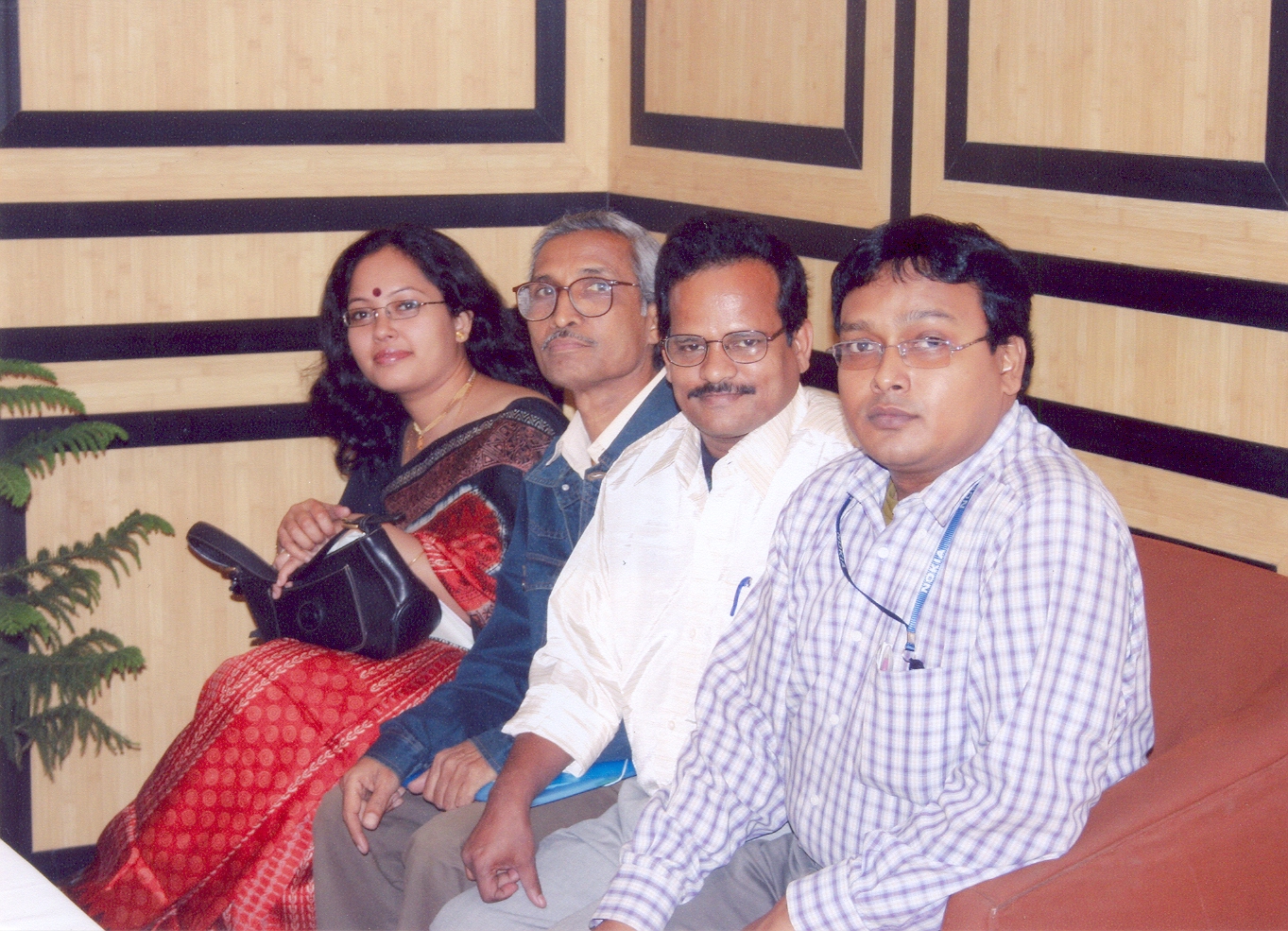
CRG office team
